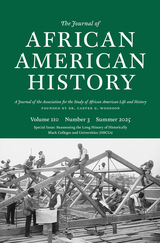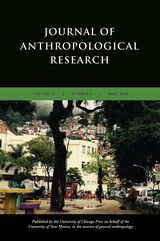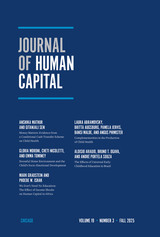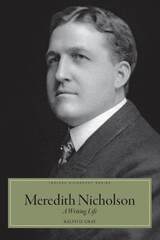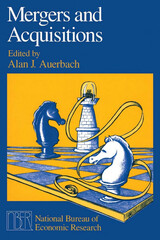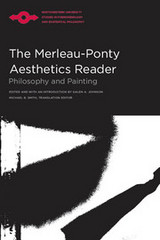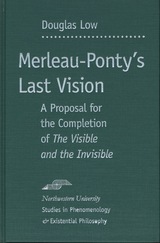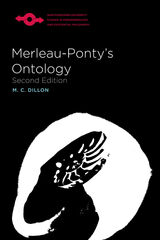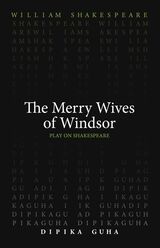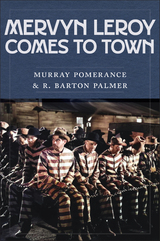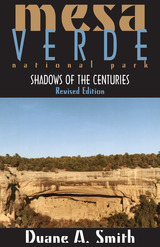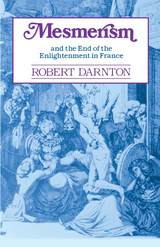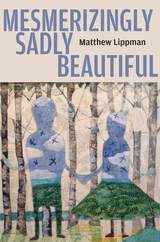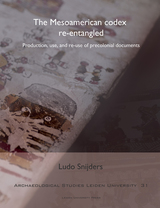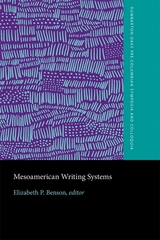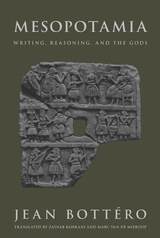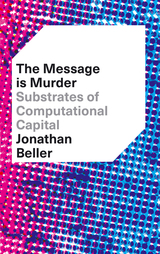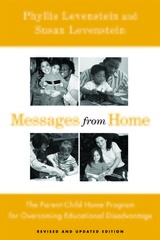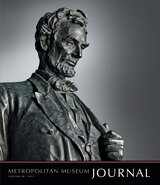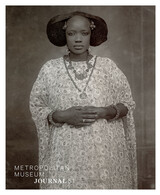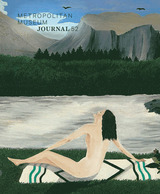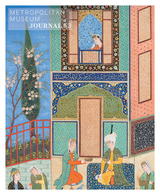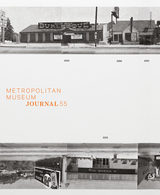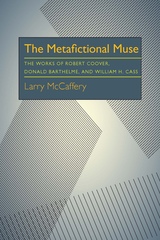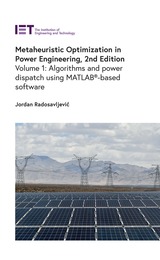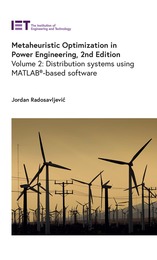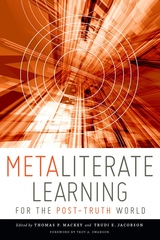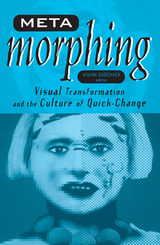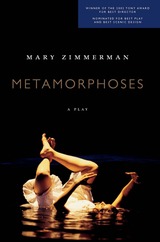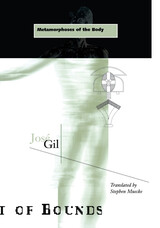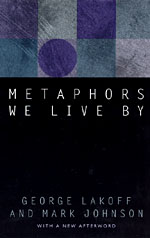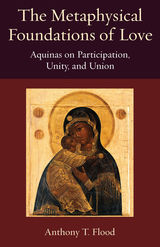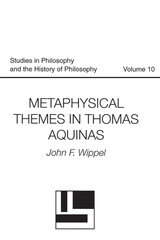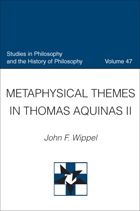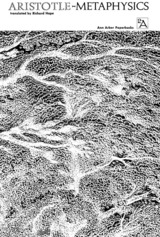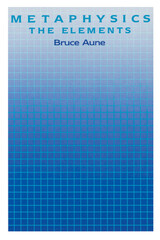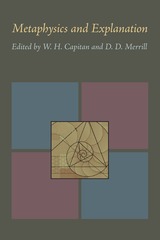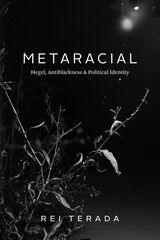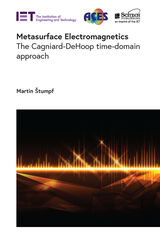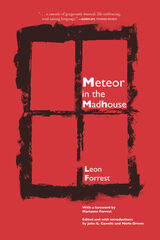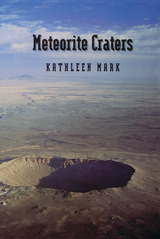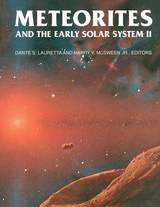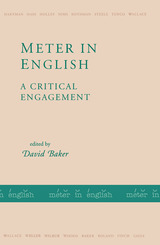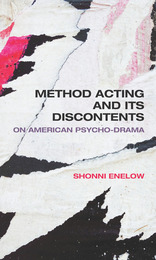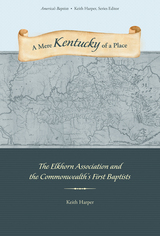 A Mere Kentucky of a Place: The Elkhorn Association and the Commonwealth's First Baptists
Keith Harper
University of Tennessee Press, 2021 As the story goes, an itinerant preacher once visited the Bluegrass region and proclaimed heaven to be “a mere Kentucky of a place.” The Commonwealth’s first Baptists certainly thought so as they began settling the region a decade before statehood. By 1785 a group of pioneering preachers formed the Elkhorn Association, widely regarded as the oldest Baptist association west of the Alleghenies. Often portrayed in the historiography as the vanguard of a new frontier democracy, the Elkhorn Association, on closer inspection, reveals itself to be far more complex. In A Mere Kentucky of a Place, Keith Harper argues that the association’s Baptist ministers were neither full-fledged frontier egalitarians nor radical religionists but simply a people in transition. These ministers formed their identities in the crucible of the early national period, challenged by competing impulses, including their religious convictions, Jeffersonian Republicanism, and a rigid honor code—with mixed results.
With a keen eye for human interest, Harper brings familiar historical figures such as John Gano and Elijah Craig to life as he analyzes leadership in the Elkhorn Association during the early republic. Mining the wealth of documents left by the association, Harper details the self-aware struggle of these leaders to achieve economic wealth, status, and full social and cultural acceptance, demonstrating that the Elkhorn Association holds a unique place in the story of Baptists in the “New Eden” of Kentucky.
Ideal for course adoption in religious studies and students of Kentucky history, this readable work is sure to become a standard source on the history of religion on the Kentucky frontier.
Meredith Nicholson: A Writing Life
Ralph D. Gray
Indiana Historical Society Press, 2007 Meredith Nicholson stands as the most Hoosier of all Indiana writers, serving as an outspoken advocate for his state. Indiana literary historian Arthur S. Shumaker called Nicholson the “most rabid” of Indiana’s major authors. In addition to writing such national best-sellers as Zelda Dameron and The House of a Thousand Candles, his best-known work, Nicholson won praise as an insightful essayist, with his work published in such national magazines as the Saturday Evening Post and Atlantic Monthly. "His inherent belief in democracy and democratic values, and his unapologetic patriotism permeate his essays," notes Gray, "some of which excoriated the Ku Klux Klan and upheld the rights and virtues of women, attitudes not always popular at the time."
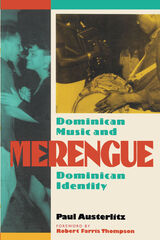 Merengue: Dominican Music and Dominican Identity
Paul Austerlitz
Temple University Press, 1997 Merengue—the quintessential Dominican dance music—has a long and complex history, both on the island and in the large immigrant community in New York City. In this ambitious work, Paul Austerlitz unravels the African and Iberian roots of merengue and traces its growth under dictator Rafael Trujillo and its renewed popularity as an international music. Using extensive interviews as well as written commentaries, Austerlitz examines the historical and contemporary contexts in which merengue is performed and danced, its symbolic significance, its social functions, and its musical and choreographic structures. He tells the tale of merengue's political functions, and of its class and racial significance. He not only explores the various ethnic origins of this Ibero-African art form, but points out how some Dominicans have tried to deny its African roots. In today's global society, mass culture often marks ethnic identity. Found throughout Dominican society, both at home and abroad, merengue is the prime marker of Dominican identity. By telling the story of this dance music, the author captures the meaning of mass and folk expression in contemporary ethnicity as well as the relationship between regional, national, and migrant culture and between rural/regional and urban/mass culture. Austerlitz also traces the impact of migration and global culture on the native music, itself already a vibrant intermixture of home-grown merengue forms. From rural folk idiom to transnational mass music, merengue has had a long and colorful career. Its well-deserved popularity will make this book a must read for anyone interested in contemporary music; its complex history will make the book equally indispensable to anyone interested in cultural studies.
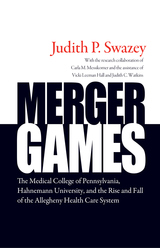 Merger Games: The Medical College of Pennsylvania, Hahnemann University, and the Rise and Fall of the Allegheny Healthcare System
Judith P. Swazey
Temple University Press, 2011 With deepening financial problems, Allegheny Heath, Education and Research Foundation filed for bankruptcy in 1998—in the midst of its landmark merger of The Medical College of Pennsylvania and Hahnemann University. What resulted was another dire event in an escalating disaster. As civil and criminal investigations probed Allegheny's collapse, the survival of the medical school and other health sciences university schools, and the operation of the hospitals hung in the balance. Fortunately, a savior arrived in the form of Drexel University who used this opportunity to create its own medical school. Merger Games is Judith Swazey's gripping account of this historic transaction. Based on extraordinarily detailed first-hand research and continuous inside access to the developments, this book clearly delineates who the players were and what this merger means for the future of medical education and institutional healthcare. Merger Games is a definitive history of one of the most important academic medicine mergers in Philadelphia and the country, which happened at a time when medical care was becoming commodified in almost every state.
Mergers and Acquisitions
Edited by Alan J. Auerbach
University of Chicago Press, 1988 Do mergers lead to financial instability? How are shareholders' interests best served? How significant a role do taxes play? What are the implications for the structure and concentration of industry? Mergers and Acquisitions, prepared in an nontechnical format, answers these and other questions that have arisen from the takeover boom that began in the mid-1980s.
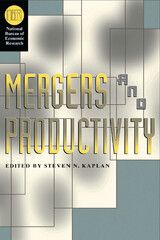 Mergers and Productivity
Edited by Steven N. Kaplan
University of Chicago Press, 2000 Mergers and Productivity offers probing analyses of high-profile mergers in a variety of industries. Focusing on specific acquisitions, it illustrates the remarkable range of contingencies involved in any merger attempt. The authors clearly establish each merger's presumed objectives and the potential costs and benefits of the acquisition, and place it within the context of the broader industry. Striking conclusions that emerge from these case studies are that merger and acquisition activities were associated with technological or regulatory shocks, and that a merger's success or failure was dependent upon the acquirer's thorough understanding of the target, its corporate culture, and its workforce and wage structures prior to acquisition.
Sifting through a wealth of carefully gathered evidence, these papers capture the richness, the complexity, and the economic intangibles inherent in contemporary merger activity in a way that large-scale studies of mergers cannot.
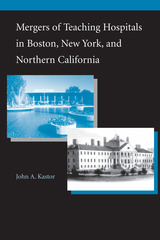 Mergers of Teaching Hospitals in Boston, New York, and Northern California
John A. Kastor
University of Michigan Press, 2003 If a teaching hospital loses funding, what is the next option? Mergers of Teaching Hospitals in Boston, New York, and Northern California investigates the recent mergers of six of the nation's most respected teaching hospitals. The author explains the reasons why these institutions decided to change their governance and the factors that have allowed two of them to continue to operate while forcing the third to dissolve after only 23 months of operation. The case studies contained within this book rely on an impressive amount of research. Notably, instead of citing only published articles and books, the author includes information from numerous, extensive personal interviews with key participants in the various mergers. With this research the author not only presents to the reader a picture of why these mergers came about, but also investigates how the organizations have fared since joining together. The mergers are analyzed and compared in order to identify various methods of merger formation as well as ways in which other newly formed hospitals might accomplish a variety of important goals. Offering a spectacular account of some of the mergers that occurred in the health care field at the close of the twentieth century, these stories provide insight into academia's relationship with teaching hospitals and the challenges involved in bringing prestigious and powerful medical institutions together. The institutions discussed are Partners, the corporation which includes the Massachusetts General Hospital and the Brigham and Women's Hospital, New York-Presbyterian Hospital, the union of the New York and Presbyterian hospitals in New York City, and the UCSF Stanford, the merged teaching hospitals of the University of California, San Francisco and Stanford. This book will particularly appeal to professionals and academics interested in medicine, business, and organizational studies. John Kastor is Professor of Medicine at the University of Maryland School of Medicine. From 1984 to 1997, he was Theodore E. Woodward Professor of Medicine and Chairman of the Department of Medicine at Maryland and Chief of the Medical Service at the University of Maryland Hospital. Dr. Kastor is also the author of Arrhythmias.
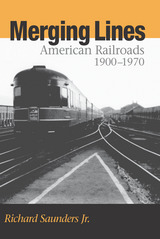 Merging Lines: American Railoads, 1900-1970
Richard Saunders, Jr.
Northern Illinois University Press, 2001
Why did American railroads decline from the glory days of the early twentieth century? Why did so many railroad mergers in the 1950s and 1960s, intended as a panacea for the ills of an outdated system, go sour and, in fact, make a bad situation worse? Saunders addresses these and many other issues in this authoritative history of U.S. railroads and their corporate mergers.
Beginning with a wide-ranging analysis of the role of railroads in the economic and social fabric of American life, Saunders traces the causes and results of the twentieth century's "merger mania." Mergers, he explains, were expected to save money, to improve service to customers, and to help railroads compete against other modes of transportation, such as the growing airline and trucking industries. Saunders then gives colorful, richly detailed accounts of the mergers and shows the reasons—including corporate greed and the inept blundering of government regulatory agencies—the outcomes fell far short of expectations.
Merging Lines explores the impact of shifting political control of railroads as no history has done before. The fates of both workers and railroad companies were dictated by the rise and fall of business and governmental leaders, including Bill Brosnan, Robert R. Young, Alfred Perlman, President John F. Kennedy, and President Lyndon B. Johnson. As power struggles erupted, the original goals of the mergers were thwarted by consumer frustration, violent labor strikes, and organizational collapse. Saunders explores these and other crucial developments in this extensive work, carefully designed for railroad historians and enthusiasts at any level.
Encyclopedic in its scope, Merging Lines includes sixty-eight maps, a list of court cases involving railroad mergers, and a wealth of information on American railroads from coast to coast. An extensively revised, updated, and supplemented edition of Saunders's earlier classic, The Railroad Mergers and the Coming of Conrail (1978), it is essential reading for all who are interested in railroad and transportation history.
Meridian
Kathleen Jesme
Tupelo Press, 2012 A meditation on the death of a mother, Meridian measures the hours and reflects on how experience collapses and elongates time, creating a lens through which we can look at how we’re connected and separated. And the poet asks: Is music our best refusal to accede to the irrationality of death?
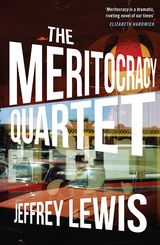 The Meritocracy Quartet
Jeffrey Lewis
Haus Publishing, 2011 Acclaimed writer Jeffrey Lewis is known for his deft portrayals of relatable figures from all walks of life. In The Meritocracy Quartet, his four interlinking novels—Meritocracy: A Love Story, The Conference of the Birds, Theme Song for an Old Show, and Adam the King—have been brought together for the first time into a single volume. Set against the backdrop of the changing American landscape over four decades, The Meritocracy Quartet is a testament to the country’s evolving personality.
The quartet follows Louie, a Yale graduate from a modest background with a gift for forging connections in high and low places. Beginning in the 1960s, as he documents a going-away party for a fellow Yalie on his way to Vietnam, and continuing through his spiritual encounters with a 1970s group of city misfits, his turn to television writing in the 1980s, and a tragic love story between two of his close friends in the 1990s, Louie chronicles not only his own personal struggles—his silent love for his best friend’s girl, his delicate relationship with an at-times absent father—but also the attitudes, events, and people that marked his generation. From the Vietnam War to George W. Bush, from television trends to the divide between the haves and have-nots, The Meritocracy Quartet is a moving witness to everything America had to offer in the latter portion of the twentieth century.
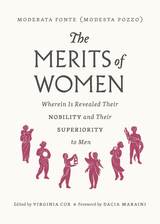 The Merits of Women: Wherein Is Revealed Their Nobility and Their Superiority to Men
Moderata Fonte
University of Chicago Press, 2018 You would as well look for blood in a corpse as for the least shred of decency in a man . . .
Without help from their wives, men are just like unlit lamps . . .
Just think of them as an unreliable clock that tells you it’s ten o’clock when it’s in fact barely two . . .
A man without a woman is like a fly without a head . . .
These are but a small selection of the quips bandied about at this lively gathering of women. The broad topic at hand is the relative pros and cons of men, and the cases in point range from pick-up artists to locker-room talk, and from double standards to fragile masculinity.
Yet this dialogue unfolds not among ironically misandrist millenials venting at their local dive bar, but rather among sixteenth-century women—variously married, widowed, single, and betrothed—attending a respectable Venice garden party. Written in the early 1590s by Moderata Fonte, pseudonym of the Renaissance poet and writer Modesta Pozzo, this literary dialogue interrogates men and men’s treatment of women, and explores by contrast the virtues of singledom and female friendship. As the women diverge from their theme—discussing everything from astrology to the curative powers of plants and minerals—a remarkable group portrait of wisdom, wit, and erudition emerges.
A new introduction by translator Virginia Cox and foreword by Dacia Maraini situate The Merits of Women in its historical context, written as it was on the cusp of Shakespeare’s heyday, and straddling the centuries between the feminist works of Christine de Pizan and Mary Wollstonecraft. Elegantly presented for a general audience, this is a must-read for baby feminists and “nasty women” alike, not to mention the perfect subtle gift for any mansplaining friend who needs a refresher on the merits of women . . . and their superiority to men.
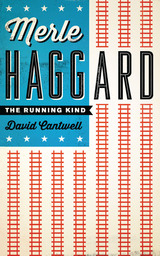 Merle Haggard: The Running Kind
By David Cantwell
University of Texas Press, 2013 Merle Haggard has enjoyed artistic and professional triumphs few can match. He’s charted more than a hundred country hits, including thirty-eight number ones. He’s released dozens of studio albums and another half dozen or more live ones, performed upwards of ten thousand concerts, been inducted into the Country Music Hall of Fame, and seen his songs performed by artists as diverse as Lynryd Skynyrd, Elvis Costello, Tammy Wynette, Willie Nelson, the Grateful Dead, and Bob Dylan. In 2011 he was feted as a Kennedy Center Honoree. But until now, no one has taken an in-depth look at his career and body of work.
In Merle Haggard: The Running Kind, David Cantwell takes us on a revelatory journey through Haggard’s music and the life and times out of which it came. Covering the entire breadth of his career, Cantwell focuses especially on the 1960s and 1970s, when Haggard created some of his best-known and most influential music, which helped invent the America we live in today. Listening closely to a masterpiece-crowded catalogue (including songs such as “Okie from Muskogee,” “Sing Me Back Home,” “Mama Tried,” “Working Man Blues,” “Kern River,” “White Line Fever,” “Today I Started Loving You Again,” and “If We Make It through December,” among many more), Cantwell explores the fascinating contradictions—most of all, the desire for freedom in the face of limits set by the world or self-imposed—that define not only Haggard’s music and public persona but the very heart of American culture.
The Merleau-Ponty Aesthetics Reader: Philosophy and Painting
Edited and with an Introduction by Galen A. Johnson; Michael B. Smith, Translation Editor
Northwestern University Press, 1993 Merleau-Ponty's essays on aesthetics are some of the major accomplishments of his philosophical career, and rank even today among the most sophisticated reflections on art in all of twentieth-century philosophy. His essays on painting, "Cezanne's Doubt" (1945), "Indirect Language and the Voices of Silence" (1952), and "Eye and Mind" (1960), have inspired new approaches to epistemology, ontology, and the philosophy of history. Galen A. Johnson has gathered these essays for the first time into a single volume and augmented them with essays by distinguished scholars and artists, including M.C. Dillon, Mikel Dufrenne, and René Magritte. Together the essays demonstrate the continuing significance of Merleau-Ponty's ideas about art for contemporary philosophy on both sides of the Atlantic.
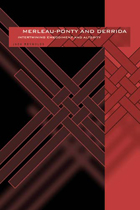 Merleau-Ponty and Derrida: Intertwining Embodiment and Alterity
Jack Reynolds
Ohio University Press, 2005 While there have been many essays devoted to comparing the work of Maurice Merleau-Ponty with that of Jacques Derrida, there has been no sustained book-length treatment of these two French philosophers. Additionally, many of the essays presuppose an oppositional relationship between them, and between phenomenology and deconstruction more generally. Jack Reynolds systematically explores their relationship by analyzing each philosopher in terms of two important and related issues—embodiment and alterity. Focusing on areas with which they are not commonly associated (e.g., Derrida on the body and Merleau-Ponty on alterity) makes clear that their work cannot be adequately characterized in a strictly oppositional way. Merleau-Ponty and Derrida: Intertwining Embodiment and Alterity proposes the possibility of a Merleau-Ponty-inspired philosophy that does not so avowedly seek to extricate itself from phenomenology, but that also cannot easily be dismissed as simply another instantiation of the metaphysics of presence. Reynolds argues that there are salient ethico-political reasons for choosing an alternative that accords greater attention to our embodied situation. As the first full-length monograph comparing the philosophers, Merleau-Ponty and Derrida will interest scholars and students in European philosophy and teachers of courses dealing with deconstruction.
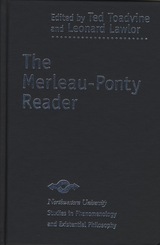 The Merleau-Ponty Reader
Leonard Lawlor and Ted Toadvine
Northwestern University Press, 2007 The first reader to offer a comprehensive view of Maurice Merleau-Ponty’s (1908-1961) work, this selection collects in one volume the foundational essays necessary for understanding the core of this critical twentieth-century philosopher’s thought.
Arranged chronologically, the essays are grouped in three sections corresponding to the major periods of Merleau-Ponty’s work: First, the years prior to his appointment to the Sorbonne in 1949, the early, existentialist period during which he wrote important works on the phenomenology of perception and the primacy of perception; second, the years of his work as professor of child psychology and pedagogy at the Sorbonne, a period especially concerned with language; and finally, his years as chair of modern philosophy at the Collège de France, a time devoted to the articulation of a new ontology and philosophy of nature. The editors, who provide an interpretive introduction, also include previously unpublished working notes found in Merleau-Ponty’s papers after his death. Translations of all selections have been updated and several appear here in English for the first time.
By contextualizing Merleau-Ponty’s writings on the philosophy of art and politics within the overall development of his thought, this volume allows readers to see both the breadth of his contribution to twentieth-century philosophy and the convergence of the various strands of his reflection.
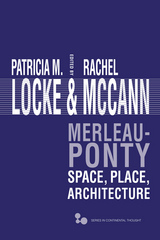 Merleau-Ponty: Space, Place, Architecture
Patricia M. Locke
Ohio University Press, 2015 Phenomenology has played a decisive role in the emergence of the discourse of place, now indispensable to many disciplines in the humanities and social sciences, and the contribution of Merleau-Ponty’s thought to architectural theory and practice is well established. Merleau-Ponty: Space, Place, Architecture is a vibrant collection of original essays by twelve eminent philosophers who mine Merleau-Ponty’s work to consider how we live and create as profoundly spatial beings. The resulting collection is essential to philosophers and creative artists as well as those concerned with the pressing ethical issues of our time. Each contributor presents a different facet of space, place, or architecture. These essays carve paths from Merleau-Ponty to other thinkers such as Irigaray, Deleuze, Ettinger, and Piaget. As the first collection devoted specifically to developing Merleau-Ponty’s contribution to our understanding of place and architecture, this book will speak to philosophers interested in the problem of space, architectural theorists, and a wide range of others in the arts and design community. Contributors: Nancy Barta-Smith, Edward S. Casey, Helen Fielding, Lisa Guenther, Galen A. Johnson, Randall Johnson, D. R. Koukal, Suzanne Cataldi Laba, Patricia M. Locke, Glen Mazis, Rachel McCann, David Morris, and Dorothea Olkowski.
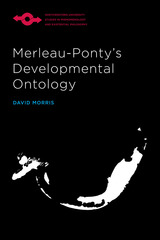 Merleau-Ponty’s Developmental Ontology
David Morris
Northwestern University Press, 2018 Winner of the 2020 Edward Goodwin Ballard Prize in Phenomenology
Merleau-Ponty's Developmental Ontology shows how the philosophy of Maurice Merleau-Ponty, from its very beginnings, seeks to find sense or meaning within nature, and how this quest calls for and develops into a radically new ontology.
David Morris first gives an illuminating analysis of sense, showing how it requires understanding nature as engendering new norms. He then presents innovative studies of Merleau-Ponty's The Structure of Behavior and Phenomenology of Perception, revealing how these early works are oriented by the problem of sense and already lead to difficulties about nature, temporality, and ontology that preoccupy Merleau-Ponty's later work. Morris shows how resolving these difficulties requires seeking sense through its appearance in nature, prior to experience—ultimately leading to radically new concepts of nature, time, and philosophy.
Merleau-Ponty's Developmental Ontology makes key issues in Merleau-Ponty's philosophy clear and accessible to a broad audience while also advancing original philosophical conclusions.
Merleau-Ponty's Last Vision: A Proposal for the Completion of "The Visible and the Invisible"
Douglas Low
Northwestern University Press, 2000 Few writers' unfinished works are considered among their most important, but such is the case with Merleau-Ponty's The Visible and the Invisible. What exists of it is a mere beginning, yet it bridged modernism and postmodernism in philosophy. Low uses material from some of Merleau-Ponty's later works as the basis for completion. Working from this material and the philosopher's own outline, Low presents how this important work would have looked had Merleau-Ponty lived to complete it.
Merleau-Ponty's Ontology: Second Edition
M.C. Dillon
Northwestern University Press, 1997 Originally published in 1988, M.C. Dillon's classic study of Merleau-Ponty is now available in a revised second edition containing a new preface and a new chapter on "Truth in Art." Dillon's thesis is that Merleau-Ponty has developed the first genuine alternative to ontological dualism seen in Western philosophy. From his early work on the philosophical significance of the human body to his later ontology of flesh, Merleau-Ponty shows that the perennial problems growing out of dualistic conceptions of mind and body, subject and object, immanence and transcendence can be resolved within the framework of a new way of thinking based on the exemplar of the worldly embodiment of thought.
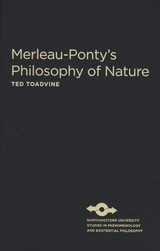 Merleau-Ponty’s Philosophy of Nature
Ted Toadvine
Northwestern University Press, 2009 In our time, Ted Toadvine observes, the philosophical question of nature is almost entirely forgotten—obscured in part by a myopic focus on solving "environmental problems" without asking how these problems are framed. But an "environmental crisis," existing as it does in the human world of value and significance, is at heart a philosophical crisis. In this book, Toadvine demonstrates how Maurice Merleau-Ponty’s phenomenology has a special power to address such a crisis—a philosophical power far better suited to the questions than other modern approaches, with their over-reliance on assumptions drawn from the natural sciences. The book examines key moments in the development of Merleau-Ponty’s philosophy of nature while roughly following the historical sequence of his major works. Toadvine begins by setting out an ontology of nature proposed in Merleau-Ponty’s first book, The Structure of Behavior. He takes up the theme of the expressive role of reflection in Phenomenology of Perception, as it negotiates the area between nature’s own "self-unfolding" and human subjectivity. Merleau-Ponty’s notion of "intertwining" and his account of space provide a transition to Toadvine’s study of the philosopher’s later work—in which the concept of "chiasm," the crossing or intertwining of sense and the sensible, forms the key to Merleau-Ponty’s mature ontology—and ultimately to the relationship between humans and nature.
 The Mermaid’s Tale: Four Billion Years of Cooperation in the Making of Living Things
Kenneth M. Weiss and Anne V. Buchanan
Harvard University Press, 2009 Even after 150 years, Darwin’s theory of evolution by natural selection is irresistibly compelling. But how can this idea—in which competition prevails—be consistent with all that we know about the thoroughly cooperative nature of life at the genetic and cellular level? This book reconciles these discrepancies.
Assembling a set of general principles, authors Kenneth Weiss and Anne Buchanan build a comprehensive, unified theory that applies on the evolutionary time scale but also on the developmental and ecological scales where daily life is lived, and cells, organisms, and species interact. They present this story through a diversity of examples spanning the fundamental challenges that organisms have faced throughout the history of life. This shows that even very complex traits can be constructed simply, based on these principles. Although relentless competitive natural selection is widely assumed to be the primary mover of evolutionary change, The Mermaid’s Tale shows how life more generally works on the basis of cooperation. The book reveals that the focus on competition and cooperation is largely an artifact of the compression of time—a distortion that dissolves when the nature and origins of adapted life are viewed primarily from developmental and evolutionary time scales.
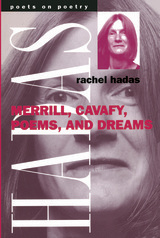 Merrill, Cavafy, Poems, and Dreams
Rachel Hadas
University of Michigan Press, 2000 Merrill, Cavafy, Poems and Dreams is a collection that--as the title indicates--looks both outward and inward. It begins with essays on Greek poets from Homer to Ritsos, in which Rachel Hadas's knowledge of classical literature and her years in Greece richly inform the writing. The collection also includes a loving exploration of the work of poet James Merrill, who was a close personal friend of the author's.
The second half of the book combines explorations of various corners and horizons of the poetry scene, including neglected American poets and Hadas's thoughts on her own poetics and career. "Two Letters from New York" and "Tangled Web Sites" take bemused looks at literary or cultural landscapes. Hadas also looks inward: to dreams and dreamwork, to her dead mother's address book, to the emblematic drilling of a well in a country house. The range of selections includes essays, interviews, memoir, criticism, and a few of Hadas's own poems.
Rachel Hadas is the author of eleven books of poetry, essays, and translations. Her most recent book is Halfway Down the Hall: New and Selected Poems. She has received a Guggenheim Fellowship in Poetry and an American Academy-Institute of Arts and Letters Award in Literature, and is a member of the American Academy of Arts and Sciences. She is Professor of English at the Newark campus of Rutgers University.
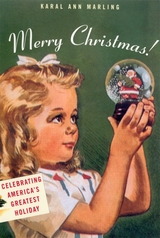 Merry Christmas!: Celebrating America’s Greatest Holiday
Karal Ann Marling
Harvard University Press, 2000 It wouldn't be Christmas without the "things." How they came to mean so much, and to play such a prominent role in America's central holiday, is the tale told in this delightful and edifying book. In a style characteristically engaging and erudite, Karal Ann Marling, one of our most trenchant observers of American culture, describes the outsize spectacle that Christmas has become, showing us the provenance and significance of each of its essential parts: the decorated trees and holiday lights, the cards and gifts and wrapping papers, the toy villages and store displays and Macy's holiday parade, Bing Crosby and Santa Claus.
Viewing Christmas through the media of mass culture--engravings and lithographs, magazine fiction, pictorial ads, news photos, cards, and movies--Marling tells us how the beloved Christmas tree grew out of a much-reprinted image of Queen Victoria and her family gathered around a decorated fir; how Santa Claus lost his provincial Dutch character and turned into the jolly old soul we know; how Charles Dickens's A Christmas Carol borrowed from Washington Irving's imaginings of what Christmas must have been like in Merrie Olde England; and how the holiday, balancing between the private and public realms, conferred a central and defining role on women.
A celebration of the visual culture of the season, Merry Christmas! offers captivating evidence that Christmas in America is primarily a secular celebration of abundance, goodwill, and familial identity, expressed in a multitude of material ways.
The Merry Wives of Windsor
William Shakespeare
Arizona Center for Medieval and Renaissance Studies, 2023 A modern translation that will appeal to new audiences.
In her translation of The Merry Wives of Windsor, Dipika Guha updates the language of Shakespeare’s comedy through the lens of our current moment. Guha maintains the humor at the heart of the play while making it accessible for both performers and audiences.
This translation was written as part of the Oregon Shakespeare Festival’s Play On! project, which commissioned new translations of thirty-nine Shakespeare plays. These translations present the work of "The Bard" in language accessible to modern audiences while never losing the beauty of Shakespeare’s verse. These volumes make these works available for the first time in print—a new First Folio for a new era.
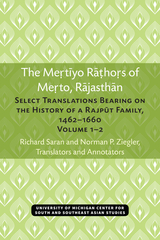 The Mertiyo Rathors of Merto, Rajasthan: Select Translations Bearing on the History of a Rajput Family, 1462–1660, Volumes 1–2
Richard Saran and Norman P. Ziegler, translators and annotators
University of Michigan Press, 2001 The Meṛtīyo Rāṭhoṛs of Meṛto, Rājasthān is a treasure for scholars of Rajpūt history. Richard D. Saran and Norman P. Ziegler, whose contributions to Rajpūt studies are well known to specialists in the field, have given us a work of deep and exacting scholarship. It is the culmination of decades devoted to the study of Middle Marwari chronicles from Rājasthān. The sources translated here provide access to the fortunes of a branch of the Jodhpur royal family, and in doing so they illuminate the larger world of Rajpūts in the middle period. The Meṛtīyo Rāṭhoṛs are significant for several reasons. Their story traces the emergence of a Rajpūt brotherhood into local prominence and follows the establishment of their kingdom on the eastern edge of Mārvāṛ as a defined territorial unit. The evolution of the Meṛtīyos as a brotherhood passed through several clearly defined stages, including a relationship with the house of Jodhpur that ranged from mutual support among brothers to hostility and clear separation. A study of the Meṛtīyos in this context provides a unique view of the formation of a strong and indpenedent Rajpūt cadet line, of the establishment and defense of a local territory, and of the internal relations among Rajpūt brotherhoods regarding issues of precedence, honor, patronage, and service. The translations are accompanied by an extensive explanatory apparatus taking various forms, which includes a valuable essay on Rajput social organization, complete genealogies, and biographies of all the major personages of the chronicles.
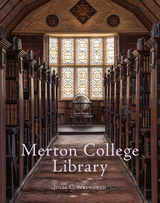 Merton College Library
Julia C. Walworth
Bodleian Library Publishing, 2020 The Merton library is rightly known for its antiquity, its beautiful medieval and early modern architecture and fittings, and its remarkable collection of manuscripts and rare books. However, a nineteenth-century plan to tear the medieval library down and replace it was only narrowly prevented. This brief history of Europe’s oldest surviving academic library begins with its origins in the thirteenth century, when a new type of community of scholars was first being set up, and follows through to the present day and its multiple functions as a working college library, a unique resource for researchers, and a delight for curious visitors.
Drawing on the remarkable wealth of documentation in the college’s archives, this is the first history of the library to explore collections, buildings, readers, and staff across more than seven hundred years. The story is told in part through stunning color images that depict not only exceptional treasures but also the library furnishings and decorations, and which show manuscripts, books, bindings, and artifacts of different periods in their changing contexts. Featuring a historical timeline and a floor plan of the college, this book will be of interest to historians, alumni, and tourists alike.
Mervyn LeRoy Comes to Town
Murray Pomerance
Rutgers University Press, 2025 Mervyn LeRoy Comes to Town is the first book devoted to the career of one of the director/producers who in the early years of sound cinema was instrumental in establishing the Hollywood model of production that would endure for more than half a century. As a director and producer, LeRoy was responsible for turning out more than sixty feature films in a career that spanned five decades; as a studio executive, he contributed substantially to the success of the industry during the challenging period of the Depression and also in the period of realignment and readjustment that followed the end of World War II. This book offers chapters devoted to individual films such as Little Caesar, Waterloo Bridge, 30 Seconds over Tokyo, Gypsy, and Quo Vadis.
Mesa Verde National Park: Shadows of the Centuries, Revised Edition
Duane A. Smith
University Press of Colorado, 2002 Originally published in 1988, Mesa Verde National Park: Shadows of the Centuries is an engaging and artfully illustrated history of an enigmatic assemblage of canyons and mesas tucked into the southwestern corner of Colorado. Duane A. Smith recounts the dramatic 1888 "discovery" of the cliff dwellings and other Anasazi ruins and the ensuing twenty-year campaign to preserve them. Smith also details the resulting creation of a national park in 1906 and assesses the impact of more recent developments - railroads and highways, air pollution, and the growing significance of tourism - on the park's financial and ecological vitality. This revised and completely redesigned edition includes more than 50 illustrations and will be enjoyed by readers interested in environmental, Western, and Colorado history.
Mesmerism and the End of the Enlightenment in France
Robert Darnton
Harvard University Press, 1968 “[An] excellent and exemplary study in the history of ideas…Provides a commendable model for those interested in the way ‘true’ and ‘false’ ideas interact and broadly influence behavior.” —Science
Early in 1788, Franz Anton Mesmer, a Viennese physician, arrived in Paris and began to promulgate a somewhat exotic theory of healing that almost immediately seized the imagination of the general populace. Robert Darnton, in his lively study of mesmerism and its relation to eighteenth-century radical political thought and popular scientific notions, provides a useful contribution to the study of popular culture and the manner in which ideas are diffused down through various social levels.
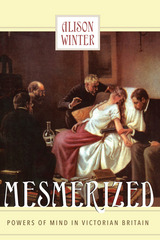 Mesmerized: Powers of Mind in Victorian Britain
Alison Winter
University of Chicago Press, 1998 Across Victorian Britain, apparently reasonable people twisted into bizarre postures, called out in unknown languages, and placidly bore assaults that should have caused unbearable pain all while they were mesmerized. Alison Winter's fascinating cultural history traces the history of mesmerism in Victorian society. Mesmerized is both a social history of the age and a lively exploration of the contested territory between science and pseudo-science.
"Dazzling. . . . This splendid book . . . gives us a new form of historical understanding and a model for open and imaginative reading."—James R. Kinkaid, Boston Globe
"A landmark in the history of science scholarship."—John Sutherland, The Independent
"It is difficult to imagine the documentary side of the story being better done than by Winter's well-researched and generously illustrated study. . . . She is a lively and keen observer; and her book is a pleasure to read purely for its range of material and wealth of detail. . . . Fruitful and suggestive."—Daniel Karlin, Times Literary Supplement
"An ambitious, sweeping and fascinating historical study. . . . Beautifully written, thoroughly researched, and well-illustrated."—Bernard Lightman, Washington Times
Mesmerizingly Sadly Beautiful
Matthew Lippman
Four Way Books, 2020 This is the “Age of the Bullet,” Matthew Lippman writes in Mesmerizingly Sadly Beautiful, days in which “bullets sprout other bullets in the bullet garden” and a caricature of a onesie-wearing president sucking on a pacifier appears on the cover of a national magazine. Lippman’s poems are wildly inventive yet grounded in the 21st-century dailyness of parenting and dinner parties and Dunkin Donuts, all of which serve as launch pads into perennial questions of mercy and trust. “I don’t care what you say about this city,” Lippman writes in the title poem whose images recall New York City in the days following 9/11: “We sit down together on the sidewalk / and we hold one another.” These are brash, beautiful poems, big-hearted in their tilt toward sentimentality and their yearning for something more, something better.
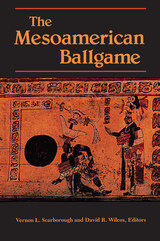 The Mesoamerican Ballgame
Edited by Vernon L. Scarborough and David R. Wilcox
University of Arizona Press, 1991 The Precolumbian ballgame, played on a masonry court, has long intrigued scholars because of the magnificence of its archaeological remains. From its lowland Maya origins it spread throughout the Aztec empire, where the game was so popular that sixteen thousand rubber balls were imported annually into Tenochtitlan. It endured for two thousand years, spreading as far as to what is now southern Arizona. This new collection of essays brings together research from field archaeology, mythology, and Maya hieroglyphic studies to illuminate this important yet puzzling aspect of Native American culture. The authors demonstrate that the game was more than a spectator sport; serving social, political, mythological, and cosmological functions, it celebrated both fertility and the afterlife, war and peace, and became an evolving institution functioning in part to resolve conflict within and between groups. The contributors provide complete coverage of the archaeological, sociopolitical, iconographic, and ideological aspects of the game, and offer new information on the distribution of ballcourts, new interpretations of mural art, and newly perceived relations of the game with material in the Popol Vuh. With its scholarly attention to a subject that will fascinate even general readers, The Mesoamerican Ballgame is a major contribution to the study of the mental life and outlook of New World peoples.
The Mesoamerican Codex Re-entangled: Production, Use and Re-use of Pre-colonial Documents
Ludo Snijders
Leiden University Press, 2017 This innovative work aims to piece together the cultural biography of Mesoamerica’s precolonial codices. Today, fewer than twenty manuscripts are all that remain of the Mesoamerican book-making tradition. These pictographic and hieroglyphic texts have often been researched according to their content, but such studies have ignored their nature as material objects. By tracing the paths these books have followed over the past five hundred years, Ludo Snijders offers fascinating insights into their production, use and reuse, destruction, rediscovery, and reinvention.
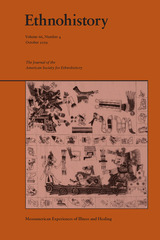 Mesoamerican Experiences of Illness and Healing
Rebecca Dufendach, special issue editor
Duke University Press The sixteenth-century encounter between Mesoamericans and Europeans resulted in a tremendous loss of life in indigenous communities and significantly impacted their health and healing strategies. Contributors to this special issue of Ethnohistory address how indigenous people experienced bodily health in the wake of this encounter. By exploring archival indigenous and Spanish-language documents, contributors address how bodily health was experienced in the wake of the European encounter and uncover transformations of health discourses and experiences of illness. They investigate eclectic healing practices and medical chants; changing notions of the causes of illnesses; and the language of cleansing ceremonies, bone-setting, midwifery, and maternal medicine.
Contributors. Sabina Cruz de la Cruz, Rebecca Dufendach, Servando Hinojosa, Timothy W. Knowlton, Gabrielle Vail, Edber Dzidz Yam
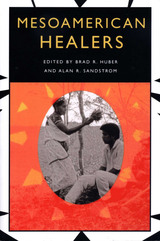 Mesoamerican Healers
Edited by Brad R. Huber and Alan R. Sandstrom
University of Texas Press, 2001 Healing practices in Mesoamerica span a wide range, from traditional folk medicine with roots reaching back into the prehispanic era to westernized biomedicine. These sometimes cooperating, sometimes competing practices have attracted attention from researchers and the public alike, as interest in alternative medicine and holistic healing continues to grow. Responding to this interest, the essays in this book offer a comprehensive, state-of-the-art survey of Mesoamerican healers and medical practices in Mexico and Guatemala. The first two essays describe the work of prehispanic and colonial healers and show how their roles changed over time. The remaining essays look at contemporary healers, including bonesetters, curers, midwives, nurses, physicians, social workers, and spiritualists. Using a variety of theoretical approaches, the authors examine such topics as the intersection of gender and curing, the recruitment of healers and their training, healers' compensation and workload, types of illnesses treated and recommended treatments, conceptual models used in diagnosis and treatment, and the relationships among healers and between indigenous healers and medical and political authorities.
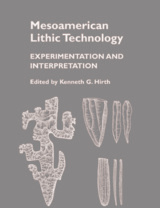 Mesoamerican Lithic Technology
Kenneth Hirth
University of Utah Press, 2003 Any overview of prehispanic society in the Americas would identify its obsidian core-blade production as a unique and highly inventive technology. Normally termed prismatic blades, these long, parallel-sided flakes are among the sharpest cutting tools ever produced by humans. Their standardized form permitted interchangeable use, and such blades became the cutting tool of choice throughout Mesoamerica between 600–800 B.C. Because considerable production skill is required, increased demand may have stimulated the appearance of craft specialists who played an integral role in Mesoamerican society. Some investigators have argued that control over obsidian also had a significant effect on the development and organization of chiefdom and state-level societies. While researchers have long recognized the potential of obsidian studies, recent work has focused primarily on compositional analysis to reconstruct trade and distribution networks. Study of blade production has received much less attention, and many aspects of this highly evolved craft are still lost. This volume seeks to identify current research questions in Mesoamerican lithic technology and to demonstrate that replication studies coupled with experimental research design are valuable analytical approaches to such questions.
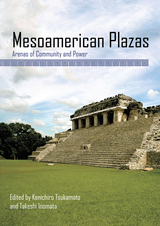 Mesoamerican Plazas: Arenas of Community and Power
Edited by Kenichiro Tsukamoto and Takeshi Inomata
University of Arizona Press, 2014 Until now, archaeological and historical studies of Mesoamerican plazas have been scarce compared to studies of the surrounding monumental architecture such as pyramidal temples and palaces. Many scholars have assumed that ancient Mesoamericans invested their labor, wealth, and symbolic value in pyramids and other prominent buildings, viewing plazas as by-products of these buildings. Even when researchers have recognized the potential significance of plazas, they have thought that plazas as vacant spaces could offer few clues about their cultural and political roles. Mesoamerican Plazas challenges both of these assumptions.
The primary question that has motivated the contributors is how Mesoamerican plazas became arenas for the creation and negotiation of social relations and values in a community. The thirteen contributions stress the significance of interplay between power relations and embodied practices set in specific historical and material settings, as outlined by practice theory and performance theory. This approach allows the contributors to explore broader anthropological issues, such as the negotiation of power relations, community making, and the constitution of political authorities.
Overall, the contributions establish that physical interactions among people in communal events were not the outcomes of political machinations held behind the scenes, but were the actual political processes through which people created, negotiated, and subverted social realities. If so, spacious plazas that were arguably designed for interactions among a large number of individuals must have also provided critical arenas for the constitution and transformation of society.
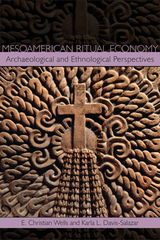 Mesoamerican Ritual Economy: Archaeological and Ethnological Perspectives
E. Christian Wells
University Press of Colorado, 2007 In Mesoamerican Ritual Economy, scholars examine the extent to which economic processes were driven by and integrated with religious ritual in ancient Mesoamerica. The contributors explore how traditional rituals - human blood sacrifice and self-mutilation, "flowery wars" and battling butterfly warriors, sumptuous feasting with chocolate and tamales, and fantastic funerary rites - intertwined with all sectors of the economy. Examining the interplay between well-established religious rites and market forces of raw material acquisition, production, circulation, and consumption, this volume effectively questions the idea that materialism alone motivates the production, exchange, and use of objects.
Exploring the intersection of spirituality and materiality, Mesoamerican Ritual Economy will be of interest to all scholars studying how worldview and belief motivate economic behavior. The authors consider a diverse set of Mesoamerican cultural patterns in order to investigate the ways in which ritual and economic practices influenced each other in the operation of communities, small-scale societies, and state-level polities. Contributors include: Sarah B. Barber, Frances F. Berdan, Karla L. Davis-Salazar, Barbara W. Fash, William L. Fash, Antonia E. Foias, Arthur A. Joyce, Brigitte Kovacevich, Ben A. Nelson, Enrique Rodríguez-Alegría, Katherine A. Spielmann, John M. Watanabe, E. Christian Wells.
Mesoamerican Sites and World-Views
Elizabeth P. Benson
Harvard University Press This volume explores questions of why ancient Mesoamerican sites were placed where they were, how the sites might have been altered, and what these activities and choices had to do with the cosmology and worldview of the people who constructed the sites. With research from experts in fields ranging from history to ethnography to astronomy, Mesoamerican Sites and World-Views is an investigation into Mesoamerican conceptions of reality through a tangible legacy we can still see today.
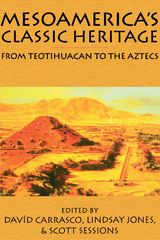 Mesoamerica's Classic Heritage: From Teotihuacan to the Aztecs
Davíd Carrasco
University Press of Colorado, 2000 For more than a millennium the great Mesoamerican city of Teotihuacan (c. 150 B.C.E. - 750 C.E.) has been imagined and reimagined by a host of subsequent cultures, including our own. Mesoamerica's Classic Heritage engages the subject of the unity and diversity of pre-Hispanic Mesoamerica by focusing on the classic heritage of this ancient city. This new volume is the product of several years of research by members of Princeton University's Moses Mesoamerican Archive and Research Project and Mexico's Proyecto Teotihuacán. Offering a variety of disciplinary perspectives - including the history of religions, anthropology, archaeology, and art history - and a wealth of new data, Mesoamerica's Classic Heritage examines Teotihuacan's rippling influence across Mesoamerican time and space, including important patterns of continuity and change, and its relationships, both historical and symbolic, with Tenochtitlan, Cholula, and various Maya communities. The contributors to Mesoamerica's Classic Heritage offer a wide range of individual interpretations, but they agree that Teotihuacan, more than any other pre-Hispanic center, was a paradigmatic source that formed the art and architecture, cosmology and ritual life, and conceptions of urbanism and political authority for significant parts of the Mesoamerican world. This great city achieved the prestige of being the site of the creation of the cosmos and of effective social and political space in Mesoamerica through its capacity to symbolize, perform, and export its imperial authority. These essays reveal the different ways in which Teotihuacan's classic heritage both fed and fed on the dynamic interactivity of the entire area. Whether or not a paradigm shift in Mesoamerican studies is taking place, certainly a new contextual understanding of Teotihuacan and the diversities and unities of Mesoamerica is emerging in these pages.
Mesopotamia
Julian Reade
Harvard University Press, 1991
Mesopotamia: Writing, Reasoning, and the Gods
Jean Bottéro
University of Chicago Press, 1995 Our ancestors, the Mesopotamians, invented writing and with it a new way of looking at the world. In this collection of essays, the French scholar Jean Bottero attempts to go back to the moment which marks the very beginning of history.
To give the reader some sense of how Mesopotamian civilization has been mediated and interpreted in its transmission through time, Bottero begins with an account of Assyriology, the discipline devoted to the ancient culture. This transmission, compounded with countless discoveries, would not have been possible without the surprising decipherment of the cuneiform writing system. Bottero also focuses on divination in the ancient world, contending that certain modes of worship in Mesopotamia, in their application of causality and proof, prefigure the "scientific mind."
Mesopotamian Chronicles
Jean-Jacques Glassner
SBL Press, 2004 All the chronicle literature of ancient Mesopotamia from the early second millennium to Seleucid times is collected in this English translation of Glassner’s Chroniques Mésopotamiennes (Paris: Les Belles Lettres, 1993). In addition to revising and supplementing the French edition, this volume provides transcriptions of the cuneiform and English translations of every example of Sumerian, Assyrian, and Babylonian chronographic literature as well as seminal essays on the genre and on Mesopotamian historiography in general.
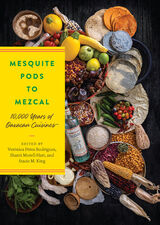 Mesquite Pods to Mezcal: 10,000 Years of Oaxacan Cuisines
Verónica Pérez Rodriguez, Shanti Morell-Hart, and Stacie M. King
University of Texas Press, 2024 New case studies documenting ten thousand years of cuisines across the cultures of Oaxaca, Mexico, from the earliest gathered plants, such as guajes, to the contemporary production of tejate and its health implications.
Among the richest culinary traditions in Mexico are those of the “eight regions” of the state of Oaxaca. Mesquite Pods to Mezcal brings together some of the most prominent scholars in Oaxacan archaeology and related fields to explore the evolution of the area’s world-renowned cuisines. This volume, the first to address food practices across Oaxaca through a long-term historical lens, covers the full spectrum of human occupation in Oaxaca, from the early Holocene to contemporary times. Contributors consider the deep history of agroecological management and large-scale landscape transformation, framing food production as a human-environment relation. They explore how, after the arrival of the Spanish, Oaxacan cuisines adapted, diets changed, and food became a stronger marker of identity. Examining the present, further studies document how traditional foodways persist and what they mean for contemporary Oaxacans, whether they are traveling ancient roads, working outside the region, or rebuilding after an earthquake. Together, the original case studies in this volume demonstrate how new methods and diverse theoretical approaches can come together to trace the development of a rich food tradition, one that is thriving today.
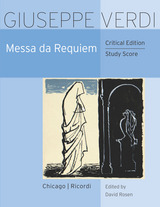 Messa da Requiem: Critical Edition Study Score
Giuseppe Verdi
University of Chicago Press, 2016 The Works of Giuseppe Verdi is the first critical edition of the composer’s oeuvre. Together with his operas, the series presents his songs, his choral music and sacred pieces, and his string quartet and other instrumental works.
This edition of Messa da Requiem is based on Verdi’s autograph score and other original sources. The appendices include two pieces from the compositional history of the Requiem: an early version of the Libera me, composed in 1869 as part of a collaborative work planned as a memorial to Rossini; and the Liber scriptus, which in the original score of the Manzoni memorial Requiem was composed as a fugue for chorus. The introduction to the score traces the complex compositional and performance histories of the Requiem and discusses the work’s problems of instrumentation and notation, while the critical commentary gives a full description of the sources and an account of all editorial decisions.
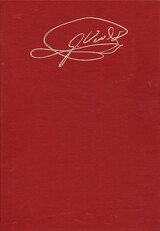 Messa da Requiem for the Anniversary of the Death of Manzoni, 22 May 1874
Giuseppe Verdi Edited by David Rosen
University of Chicago Press, 1990 Messa da Requiem is the fourth work to be published in The Works of Giuseppe Verdi. Following the strict requirements of the series, this edition is based on Verdi's autograph and other authentic sources, and has been reviewed by a distinguished editorial board—Philip Gossett (general editor), Julian Budden, Martin Chusid, Francesco Degrada, Ursula Günther, Giorgio Pestelli, and Pierluigi Petrobelli. It is available as a two-volume set: a full orchestral score and a critical commentary. The appendixes include two pieces from the compositional history of the Requiem: an early version of the Libera me, composed in 1869 as part of a collaborative work planned as a memorial to Rossini; and the Liber scriptus, which in the original score of the Manzoni memorial Requiem was composed as a fugue in G minor. The score, which has been beautifully bound and autographed, is printed on high-grade paper in an oversized format. The introduction to the score discusses the work's genesis, instrumentation, and problems of notation. The critical commentary, printed in a smaller format, discusses the editorial decisions and traces the complex compositional history of the Requiem.
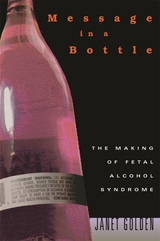 Message in a Bottle: The Making of Fetal Alcohol Syndrome
Janet Golden
Harvard University Press, 2006 A generation has passed since a physician first noticed that women who drank heavily while pregnant gave birth to underweight infants with disturbing tell-tale characteristics. Women whose own mothers enjoyed martinis while pregnant now lost sleep over a bowl of rum raisin ice cream. In Message in a Bottle, Janet Golden charts the course of Fetal Alcohol Syndrome (FAS) through the courts, media, medical establishment, and public imagination.
Long considered harmless during pregnancy (doctors even administered it intravenously during labor), alcohol, when consumed by pregnant women, increasingly appeared to be a potent teratogen and a pressing public health concern. Some clinicians recommended that women simply moderate alcohol consumption; others, however, claimed that there was no demonstrably safe level for a developing fetus, and called for complete abstinence. Even as the diagnosis gained acceptance and labels appeared on alcoholic beverages warning pregnant women of the danger, FAS began to be de-medicalized in some settings. More and more, FAS emerged in court cases as a viable defense for people charged with serious, even capital, crimes and their claims were rejected.
Golden argues that the reaction to FAS was shaped by the struggle over women's relatively new abortion rights and the escalating media frenzy over "crack" babies. It was increasingly used as evidence of the moral decay found within marginalized communities--from inner-city neighborhoods to Indian reservations. With each reframing, FAS became a currency traded by politicians and political commentators, lawyers, public health professionals, and advocates for underrepresented minorities, each pursuing separate aims.
The Message Is Murder: Substrates of Computational Capital
Jonathan Beller
Pluto Press, 2017 More than fifty years ago, Marshall McLuhan proclaimed that “the medium is the message,” profoundly influencing future generations of media theorists. A long-overdue wakeup call for the field of media studies, The Message is Murder analyzes the formations of violence still imbued in the everyday functions of the media. Jonathan Beller introduces the concept of computational capital to argue that contemporary media are not neutral, but rather they are technologies of political economy that became entangled with gendered and racialized capitalism in the twentieth and twenty-first centuries. Engaging with Borges, Turing, Hitchcock, and Marx, Beller offers an ambitious and provocative critique of contemporary media studies.
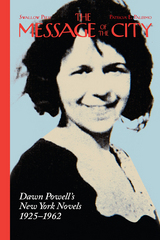 The Message of the City: Dawn Powell’s New York Novels, 1925–1962
Patricia E. Palermo
Ohio University Press, 2016 Dawn Powell was a gifted satirist who moved in the same circles as Dorothy Parker, Ernest Hemingway, renowned editor Maxwell Perkins, and other midcentury New York luminaries. Her many novels are typically divided into two groups: those dealing with her native Ohio and those set in New York. “From the moment she left behind her harsh upbringing in Mount Gilead, Ohio, and arrived in Manhattan, in 1918, she dove into city life with an outlander’s anthropological zeal,” reads a recent New Yorker piece about Powell, and it is those New York novels that built her reputation for scouring wit and social observation. In this critical biography and study of the New York novels, Patricia Palermo reminds us how Powell earned a place in the national literary establishment and East Coast social scene. Though Powell’s prolific output has been out of print for most of the past few decades, a revival is under way: the Library of America, touting her as a “rediscovered American comic genius,” released her collected novels, and in 2015 she was posthumously inducted into the New York State Writer’s Hall of Fame. Engaging and erudite, The Message of the City fills a major gap in in the story of a long-overlooked literary great. Palermo places Powell in cultural and historical context and, drawing on her diaries, reveals the real-life inspirations for some of her most delicious satire.
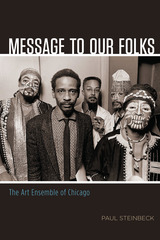 Message to Our Folks: The Art Ensemble of Chicago
Paul Steinbeck
University of Chicago Press, 2017 This year marks the golden anniversary of the Art Ensemble of Chicago, the flagship band of the Association for the Advancement of Creative Musicians. Formed in 1966 and flourishing until 2010, the Art Ensemble distinguished itself by its unique performance practices—members played hundreds of instruments on stage, recited poetry, performed theatrical sketches, and wore face paint, masks, lab coats, and traditional African and Asian dress. The group, which built a global audience and toured across six continents, presented their work as experimental performance art, in opposition to the jazz industry’s traditionalist aesthetics.
In Message to Our Folks, Paul Steinbeck combines musical analysis and historical inquiry to give us the definitive study of the Art Ensemble. In the book, he proposes a new theory of group improvisation that explains how the band members were able to improvise together in so many different styles while also drawing on an extensive repertoire of notated compositions. Steinbeck examines the multimedia dimensions of the Art Ensemble’s performances and the ways in which their distinctive model of social relations kept the group performing together for four decades. Message to Our Folks is a striking and valuable contribution to our understanding of one of the world’s premier musical groups.
Messages From Home: The Parent-Child Home Program For Overcoming Educational Disadvantage
Phyllis Levenstein and Susan Levenstein
Temple University Press, 2008 The Parent-Child Home Program, a pre-preschool home visiting program, has grown greatly since the first edition of Messages from Home was published in 1988. This expanded and updated edition shows the continued success of this program-spearheaded by the late Phyllis Levenstein-which prepares at-risk children for school success, overcoming educational disadvantage. Since The Parent-Child Home Program was founded in the 1960s, it has enriched the cognitive, social, and emotional school readiness of tens of thousands of children. The Program's methods, its theoretical underpinnings, and its impressive results are presented in detail. The success stories of both parents and children make inspiring reading. The combination of lively writing and data-driven scientific rigor give it both broad appeal and academic relevance.
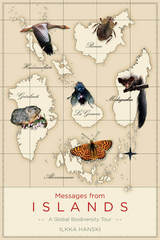 Messages from Islands: A Global Biodiversity Tour
Ilkka Hanski
University of Chicago Press, 2016 From a small island in the Baltic Sea to the large tropical islands of Borneo and Madagascar, Messages from Islands is a global tour of these natural, water-bound laboratories. In this career-spanning work, Ilkka Hanski draws upon the many islands on which he performed fieldwork to convey key themes in ecology. By exploring the islands’ biodiversity as an introduction to general issues, Hanski helps us to learn how species and communities interact in fragmented landscapes, how evolution generates biodiversity, and how this biodiversity is maintained over time.
Beginning each chapter on a particular island, Hanski dives into reflections on his own field studies before going on to pursue a variety of ecological questions, including: What is the biodiversity crisis? What are extinction thresholds and extinction debts? What can the biodiversity hypothesis tell us about rapidly increasing allergies, asthma, and other chronic inflammatory disorders? The world’s largest island, Greenland, for instance, is the starting point for a journey into the benefits that humankind acquires from biodiversity, including the staggering biodiversity of microbes in the ecosystems that are closest to us—the ecosystems in our guts, in our respiratory tracts, and under our skin. Conceptually oriented but grounded in an adventurous personal narrative, Messages from Islands is a landmark work that lifts the natural mysteries of islands from the sea, bringing to light the thrilling complexities and connections of ecosystems worldwide.
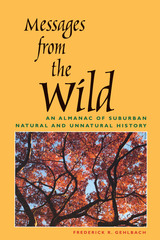 Messages from the Wild: An Almanac of Suburban Natural and Unnatural History
By Frederick R. Gehlbach
University of Texas Press, 2002 Seeking a closer connection with nature than the manicured lawns of suburbia, naturalist Fred Gehlbach and his family built a house on the edge of a wooded ravine in Central Texas in the mid-1960s. On daily walks over the hills, creek hollows, and fields of the ravine, Gehlbach has observed the cycles of weather and seasons, the annual migrations of birds, and the life cycles of animals and plants that also live in the ravine. In this book, Gehlbach draws on thirty-five years of journal entries to present a composite, day-by-day almanac of the life cycles of this semiwild natural island in the midst of urban Texas. Recording such events as the hatching of Eastern screech owl chicks, the emergence of June bugs, and the first freeze of November, he reminds us of nature's daily, monthly, and annual cycles, from which humans are becoming ever more detached in our unnatural urban environments. The long span of the almanac also allows Gehlbach to track how local and even global developments have affected the ravine, from scars left by sewer construction to an increase in frost-free days probably linked to global warming. This long-term record of natural cycles provides one of only two such baseline data sets for North America. At the same time, the book is an eloquent account of one keen observer's daily interactions with his wild and human neighbors and of the lessons in connectedness and the "play of life" that they teach.
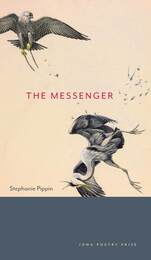 The Messenger
Stephanie Pippin
University of Iowa Press, 2013 In thrilling poems of metamorphosis and birth, death and dissolution, Stephanie Pippin’s debut collection returns us to a world unshorn of wildness. Delivering accident and hunger, love and grief, nature in these poems is beautiful and brutal, “a hellish magnificence” that both invites and denies the meanings we project onto it. Refusing the domesticated comfort of our usual myths, Pippin reminds us of our place as creatures among others in a world where “what isn’t dead / is dying,” and where the thrill of predatory flight commingles with the desperation of the prey.
This mesmerizing and astonishingly assured collection offers a message as harrowing as it is essential. Faced with the hard master of necessity—“angel stinking of his own / excitement”—and bare before what Mallarmé called “the horror of the forest,” we are helpless, finally, to do anything to save what we love. Our sole task, these poems insist, is to look on while we can, and to love harder.
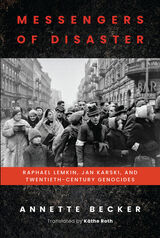 Messengers of Disaster: Raphael Lemkin, Jan Karski, and Twentieth-Century Genocides
Annette Becker, Translated by Käthe Roth
University of Wisconsin Press, 2021 Leading up to World War II, two Polish men witnessed the targeted extermination of Jews under Adolf Hitler and the German Reich before the reality of the Holocaust was widely known. Raphael Lemkin, a Jewish lawyer who coined the term "genocide," and Jan Karski, a Catholic member of the Polish resistance, independently shared this knowledge with Winston Churchill and Franklin D. Roosevelt. Having heard false rumors of wartime atrocities before, the leaders met the messengers with disbelief and inaction, leading to the eventual murder of more than six million people.
Messengers of Disaster draws upon little-known texts from an array of archives, including the International Committee of the Red Cross in Geneva and the International Tracing Service in Bad Arolsen. Carrying the knowledge of disaster took a toll on Lemkin and Karski, but their work prepared the way for the United Nations to unanimously adopt the first human rights convention in 1948 and influenced the language we use to talk about genocide today. Annette Becker's detailed study of these two important figures illuminates how distortions of fact can lead people to deny knowledge of what is happening in front of their own eyes.
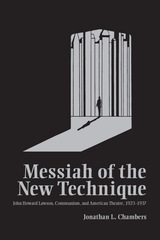 Messiah of the New Technique: John Howard Lawson, Communism, and American Theatre, 1923-1937
Jonathan L. Chambers
Southern Illinois University Press, 2006 Messiah of the New Technique: John Howard Lawson, Communism, and American Theatre, 1923–1937 is a critical and political biography and a cultural and social history that focuses on Lawson’s career in the theatre. Using a materialist methodology, Jonathan L. Chambers emphasizes the evolution and interplay of the playwright’s artistic vision and political ideology, considering his art as both a documentation of this evolution and a product of the socio-political and cultural matrix in which he was immersed. Spanning the playwright’s career, the volume details Lawson’s early indoctrination in and commitment to the avant-garde, his use and development of various nonrealistic playwriting techniques, his subtle though unfocused attacks on bourgeois society, and the varied critical responses he received. Chambers addresses Lawson’s involvement with the New Playwrights’ Theatre and his participation in the protests surrounding the case of Nicola Sacco and Bartolomeo Vanzetti, which stimulated his growing commitment to left-wing politics and radical causes. Chambers also analyzes the social and cultural factors that shaped Lawson’s growing interest in revolutionary politics, his tutelage in Marxism under Edmund Wilson, and his tenure as president of the Screen Writers Guild. He also covers the final phase of Lawson’s playwriting career, which reveals the playwright’s internal struggle. That struggle, suggests Chambers, pitted Lawson’s view of aesthetics against his political ideology and is reflected in his scripts and theoretical writings. Messiah of the New Technique provides a wealth of new material about both the playwright and the period, offering a critical synopsis of the artist’s career, addressing his often vehement rebuttals to his critics, and summarizing both his political activism and his creative and critical endeavors in the last forty years of his life.
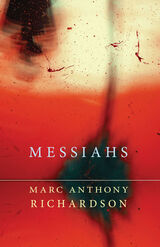 Messiahs
Marc Anthony Richardson
University of Alabama Press, 2021 2021 Big Other Book Award Fiction Finalist
A fiercely ecstatic tale of betrayal and self-sacrifice
Messiahs centers on two nameless lovers, a woman of east Asian descent and a former state prisoner, a black man who volunteered incarceration on behalf of his falsely convicted nephew, yet was “exonerated” after more than two years on death row. In this dystopian America, one can assume a relative’s capital sentence as an act of holy reform—“the proxy initiative,” patterned after the Passion. The lovers begin their affair by exchanging letters, and after his release, they withdraw to a remote cabin during a torrential winter, haunted by their respective past tragedies. Savagely ostracized by her family for years, the woman is asked by her mother to take the proxy initiative for her brother—creating a conflict she cannot bear to share with her lover. Comprised of ten poetic paragraphs, Messiahs’ rigorous style and sustained intensity equals agony and ecstasy.
 Messiahs and Machiavellians: Depicting Evil in the Modern Theatre
Paul Corey
University of Notre Dame Press, 2008
Messiahs and Machiavellians is an innovative exploration of “modern evil” in works of early- and late-modern theatre, raising issues about ethics, politics, religion, and aesthetics that speak to our present condition.
Paul Corey examines how theatre—which expressed a key political dynamic both in the Renaissance and the twentieth century—lays open the impulses that instigated modernity and, ultimately, unparalleled levels of violence and destruction. Starting with Albert Camus’ Caligula and Samuel Beckett’s Waiting for Godot, then turning to Machiavelli’s Mandragola and Shakespeare’s Measure for Measure, Corey traces the emergence of two dominant, intertwining features of modern evil: an unrestrained pursuit of power and the utopian desire for perfection.
Corey’s imaginative and convincing readings of these plays, based on detailed textual analysis, move beyond the accounts usually offered by literary critics. Drawing on political, theological, and philosophical sources—a combination as fertile as it is unusual—Corey’s methodology allows him to make keen and subtle arguments about the eschatological nature of modern politics.
“Corey’s lucid, compelling treatise argues for a radical reconsideration of the role of tragedy in dealing with the shifting metaphysical and metatheatrical sands of the contemporary era. While the study begins with an examination of mid-20th Century French existentialism—and the dramatic work of Beckett and Camus in particular—the book soon takes the reader on a fascinating voyage back into the ‘problem’ comedies of the Italian and English Renaissance theatre, and beyond that, into Greek tragedy to understand the evolving concept of ‘evil’ in the Western philosophical, theological, and dramatic tradition. Ending with a reflection on the new ‘theatre’ of terrorism entering the 21st Century, Corey poses the intriguing suggestion, that far from being irrelevant to the post-modern era, a ‘new tragic sensibility’ may become key to our gaining a ‘lucid awareness of our current situation […] the limits of politics, the indelible nature of violence, our inescapable mortality, and a need for prudence’ ” —Moira Day, University of Saskatchewan
“A sensitive examination of the problem of evil in Renaissance and 20th century drama. Corey provides fascinating analyses of individual plays, and makes a compelling argument for restoring a tragic vision of good and evil in the face of modern expediency and utopianism.” —Mary P. Nichols, Baylor University
“In Messiahs and Machiavellians, Paul Corey delivers insights both numerous and profound. His work is a serious and important contribution to contemporary political science while also offering analyses of interest to scholars in literature, religious studies, theology, and ethics.” —Barry Cooper, University of Calgary
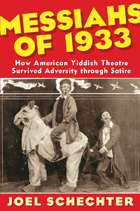 Messiahs of 1933: How American Yiddish Theatre Survived Adversity through Satire
Joel Schechter
Temple University Press, 2008 Joel Schechter has rediscovered the funny and often politically-charged plays of the American Yiddish theatre of the 1930s. In Messiahs of 1933 he celebrates their satire, their radical imagination, and their commitment to social change. He introduces readers to the once-famous writers and actors—Moishe Nadir, David Pinski, Yosl Cutler, and others—who brought into artistic form their visions of peace, social justice, and satire for all. Messiahs of 1933 greatly enlarges our understanding of Yiddish theatre and culture in the United States. It examines the innovative stage performances created by the Artef collective, the Modicut puppeteers, and the Yiddish Unit of the Federal Theatre Project. And it introduces to contemporary readers some of the most popular theatre actors of the 30s, including Leo Fuchs, Menasha Skulnik, and Yetta Zwerling. Throughout, it includes relevant photographs and contemporary comic strips, along with the first English-language publication of excerpts from the featured plays.
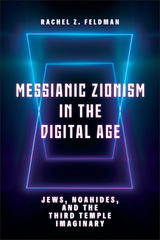 Messianic Zionism in the Digital Age: Jews, Noahides, and the Third Temple Imaginary
Rachel Z. Feldman
Rutgers University Press, 2024 Judaism in the twenty-first century has seen the rise of the messianic Third Temple movement, as religious activists based in Israel have worked to realize biblical prophecies, including the restoration of a Jewish theocracy and the construction of the third and final Temple on Jerusalem’s Temple Mount. Through groundbreaking ethnographic research, Messianic Zionism in the Digital Age details how Third Temple visions have gained considerable momentum and political support in Israel and abroad .
The role of technology in this movement’s globalization has been critical. Feldman skillfully highlights the ways in which the internet and social media have contributed to the movement's growth beyond the streets of Jerusalem into communities of former Christians around the world who now identify as the Children of Noah (Bnei Noah). She charts a path for future research while documenting the intimate effects of political theologies in motion and the birth of a new transnational Judaic faith.
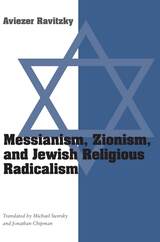 Messianism, Zionism, and Jewish Religious Radicalism
Aviezer Ravitzky
University of Chicago Press, 1996 The Orthodox Jewish tradition affirms that Jewish exile will end with the coming of the Messiah. How, then, does Orthodoxy respond to the political realization of a Jewish homeland that is the State of Israel? In this cogent and searching study, Aviezer Ravitzky probes Orthodoxy's divergent positions on Zionism, which range from radical condemnation to virtual beatification.
Ravitzky traces the roots of Haredi ideology, which opposes the Zionist enterprise, and shows how Haredim living in Israel have come to terms with a state to them unholy and therefore doomed. Ravitzky also examines radical religious movements, including the Gush Emunim, to whom the State of Israel is a divine agent. He concludes with a discussion of the recent transformation of Habad Hassidism from conservatism to radical messianism.
This book is indispensable to anyone concerned with the complex confrontation between Jewish fundamentalism and Israeli political sovereignty, especially in light of the tragic death of Israeli Prime Minister Yitzhak Rabin.
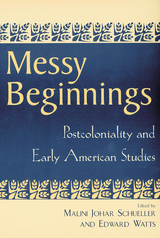 Messy Beginnings: Postcoloniality and Early American Studies
Edited by Malini Johar Schueller and Edward Watts
Rutgers University Press, 2003 When exploring the links between America and postcolonialism, scholars tend to think either in terms of contemporary multiculturalism, or of imperialism since 1898. This narrow view has left more than the two prior centuries of colonizing literary and political culture unexamined. Messy Beginnings challenges the idea of early America’s immunity from issues of imperialism, that its history is not as “clean” as European colonialism. By addressing the literature ranging from the diaries of American women missionaries in the Middle East to the work of Benjamin Franklin and Nathaniel Hawthorne, and through appraisals of key postcolonial theorists such as Edward Said, Gayatri Spivak, and Homi Bhabha, the contributors to this volume explore the applicability of their models to early American culture. Messy Beginnings argues against the simple concept that the colonization of what became the United States was a confrontation between European culture and the “other.” Contributors examine the formation of America through the messy or unstable negotiations of the idea of “nation.”
The essays forcefully show that the development of “Americanness” was a raced and classed phenomenon, achieved through a complex series of violent encounters, legal maneuvers, and political compromises. The complexity of early American colonization, where there was not one coherent “nation” to conquer, contradicts the simple label of imperialism used in other lands. The unique approach of Messy Beginnings will reshape both pre-conceived notions of postcolonialism, and how postcolonialists think about the development of the American nation.
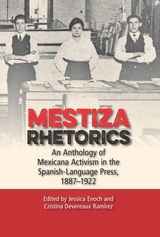 Mestiza Rhetorics: An Anthology of Mexicana Activism in the Spanish-Language Press, 1887-1922
Edited by Jessica Enoch and Cristina Devereaux Ramirez
Southern Illinois University Press, 2019 This critical bilingual anthology collects and contextualizes thirty-four primary writings of understudied revolutionary mexicana rhetors and social activists who published with presses within the United States and Mexico during the late nineteenth and early twentieth centuries—a time of cross-border revolutionary upheaval and change. These mexicana newspaperwomen leveraged diverse and compelling rhetorical strategies and used the press to advance the early feminist movement in Mexico and the U.S. Southwest; to define their rights and roles in and confront the hypocrisies of their societies’ patriarchal systems; to engage in important debates about education, women’s rights, and language instruction; and to protest injustices in society and construct possible solutions. Because these presses were in both Mexico and the United States, their writings offer opportunities to explore the concerns, struggles, and triumphs of mexicanas in both U.S. and Mexican cities and throughout the borderlands.
Mestiza Rhetorics is the first anthology dedicated to mexicana rhetors and provides unmatched access to mexicana rhetorics. This collection puts forward the work of mexicana newspaperwomen in Spanish and English, provides evidence of their participation in political and educational debates at the turn of the twentieth century, and demonstrates how the Spanish-language press operated as a rhetorical space for mexicanas.
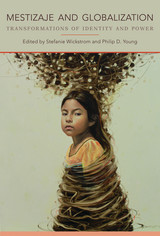 Mestizaje and Globalization: Transformations of Identity and Power
Edited by Stefanie Wickstrom and Philip D. Young
University of Arizona Press, 2014 The Spanish word mestizaje does not easily translate into English. Its meaning and significance have been debated for centuries since colonization by European powers began. Its simplest definition is “mixing.” As long as the term has been employed, norms and ideas about racial and cultural relations in the Americas have been imagined, imposed, questioned, rejected, and given new meaning.
Mestizaje and Globalization presents perspectives on the underlying transformation of identity and power associated with the term during times of great change in the Americas. The volume offers a comprehensive and empirically diverse collection of insights concerning mestizaje’s complex relationship with indigeneity, the politics of ethnic identity, transnational social movements, the aesthetic of cultural production, development policies, and capitalist globalization, with particular attention to cases in Latin America and the United States.
Beyond the narrow and often inadequate meaning of mestizaje as biological and racial mixing, the concept deserves an innovative theoretical consideration due to its multidimensional, multifaceted character and its resilience as an ideological construct. The contributors argue that historical analyses of mestizaje do not sufficiently understand contemporary ways that racism, ethnic discrimination, and social injustice intermingle with current discourse and practice of cultural recognition and multiculturalism in the Americas.
Mestizaje and Globalization contributes to an emerging multidisciplinary effort to explore how identities are imposed, negotiated, and reconstructed. The chapter authors clearly set forth the issues and obstacles that indigenous peoples and subjugated minorities face, as well as the strategies they have employed to gain empowerment in the face of globalization.
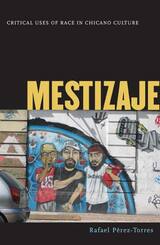 Mestizaje: Critical Uses of Race in Chicano Culture
Rafael Perez-Torres
University of Minnesota Press, 2005 Focusing on the often unrecognized role race plays in expressions of Chicano culture, Mestizaje is a provocative exploration of the volatility and mutability of racial identities. In this important moment in Chicano studies, Rafael Pérez-Torres reveals how the concepts and realities of race, historical memory, the body, and community have both constrained and opened possibilities for forging new and potentially liberating multiracial identities.
Informed by a broad-ranging theoretical investigation of identity politics and race and incorporating feminist and queer critiques, Pérez-Torres skillfully analyzes Chicano cultural production. Contextualizing the history of mestizaje, he shows how the concept of mixed race has been used to engage issues of hybridity and voice and examines the dynamics that make mestizo and mestiza identities resistant to, as well as affirmative of, dominant forms of power. He also addresses the role that mestizaje has played in expressive culture, including the hip-hop music of Cypress Hill and the vibrancy of Chicano poster art. Turning to issues of mestizaje in literary creation, Pérez-Torres offers critical readings of the works of Emma Pérez, Gil Cuadros, and Sandra Cisneros, among others. This book concludes with a consideration of the role that the mestizo body plays as a site of elusive or displaced knowledge.
Moving beyond the oppositions—nationalism versus assimilation, men versus women, Texans versus Californians—that have characterized much of Chicano studies, Mestizaje synthesizes and assesses twenty-five years of pathbreaking thinking to make a case for the core components, sensibilities, and concerns of the discipline.
Rafael Pérez-Torres is professor of English at the University of California, Los Angeles. He is author of Movements in Chicano Poetry: Against Myths, Against Margins, coauthor of To Alcatraz, Death Row, and Back: Memories of an East LA Outlaw, and coeditor of The Chicano Studies Reader: An Anthology of Aztlán, 1970–2000.
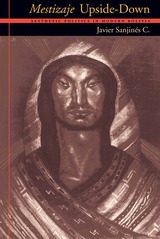 Mestizaje Upside Down: Aesthetic Politics In Modern Bolivia
Javier Sanjines C
University of Pittsburgh Press, 2004
Mestizaje—the process of cultural, ethnic, and racial mixing of Spanish and indigenous peoples—has been central to the creation of modern national identity in Bolivia and much of Latin America. Though it originally carried negative connotations, by the early twentieth century it had come to symbolize a national unity that transcended racial divides.
Javier Sanjinés C. contends that mestizaje, rather than a merging of equals, represents a fundamentally Western perspective that excludes indigenous ways of viewing the world. In this sophisticated study he reveals how modernity in Bolivia has depended on a perception, forged during the colonial era, that local cultures need to be uplifted.
Sanjinés traces the rise of mestizaje as a defining feature of Bolivian modernism through the political struggles and upheavals of the twentieth century. He then turns this concept upside-down by revealing how the dominant discussion of mestizaje has been resisted and transformed by indigenous thinkers and activists. Rather than focusing solely on political events, Sanjinés grounds his argument in an examination of fiction, political essays, journalism, and visual art, offering a unique and masterly overview of Bolivian culture, identity, and politics.
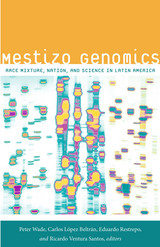 Mestizo Genomics: Race Mixture, Nation, and Science in Latin America
Peter Wade, Carlos López Beltrán, Eduardo Restrepo and Ricardo Ventura Santos, eds.
Duke University Press, 2014 In genetics laboratories in Latin America, scientists have been mapping the genomes of local populations, seeking to locate the genetic basis of complex diseases and to trace population histories. As part of their work, geneticists often calculate the European, African, and Amerindian genetic ancestry of populations. Some researchers explicitly connect their findings to questions of national identity and racial and ethnic difference, bringing their research to bear on issues of politics and identity.
Drawing on ethnographic research in Brazil, Colombia, and Mexico, the contributors to Mestizo Genomics explore how the concepts of race, ethnicity, nation, and gender enter into and are affected by genomic research. In Latin America, national identities are often based on ideas about mestizaje (race mixture), rather than racial division. Since mestizaje is said to involve relations between European men and indigenous or African women, gender is a key factor in Latin American genomics and in the analyses in this book. Also important are links between contemporary genomics and recent moves toward official multiculturalism in Brazil, Colombia, and Mexico. One of the first studies of its kind, Mestizo Genomics sheds new light on the interrelations between "race," identity, and genomics in Latin America.
Contributors. Adriana Díaz del Castillo H., Roosbelinda Cárdenas, Vivette García Deister, Verlan Valle Gaspar Neto, Michael Kent, Carlos López Beltrán, María Fernanda Olarte Sierra, Eduardo Restrepo, Mariana Rios Sandoval, Ernesto Schwartz-Marín, Ricardo Ventura Santos, Peter Wade
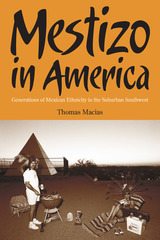 Mestizo in America: Generations of Mexican Ethnicity in the Suburban Southwest
Thomas Macias
University of Arizona Press, 2006 How much does ethnicity matter to Mexican Americans today, when many marry outside their culture and some can’t even stomach menudo? This book addresses that question through a unique blend of quantitative data and firsthand interviews with third-plus-generation Mexican Americans. Latinos are being woven into the fabric of American life, to be sure, but in a way quite distinct from ethnic groups that have come from other parts of the world. By focusing on individuals’ feelings regarding acculturation, work experience, and ethnic identity—and incorporating Mexican-Anglo intermarriage statistics—Thomas Macias compares the successes and hardships of Mexican immigrants with those of previous European arrivals. He describes how continual immigration, the growth of the Latino population, and the Chicano Movement have been important factors in shaping the experience of Mexican Americans, and he argues that Mexican American identity is often not merely an “ethnic option” but a necessary response to stereotyping and interactions with Anglo society.Talking with fifty third-plus generation Mexican Americans from Phoenix and San Jose—representative of the seven million nationally with at least one immigrant grandparent—he shows how people utilize such cultural resources as religion, spoken Spanish, and cross-national encounters to reinforce Mexican ethnicity in their daily lives. He then demonstrates that, although social integration for Mexican Americans shares many elements with that of European Americans, forces related to ethnic concentration, social inequality, and identity politics combine to make ethnicity for Mexican Americans more fixed across generations. Enhancing research already available on first- and second-generation Mexican Americans, Macias’s study also complements research done on other third-plus-generation ethnic groups and provides the empirical data needed to understand the commonalities and differences between them. His work plumbs the changing meaning of mestizaje in the Americas over five centuries and has much to teach us about the long-term assimilation and prospects of Mexican-origin people in the United States.
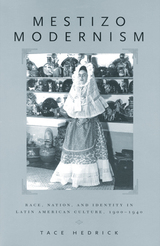 Mestizo Modernism: Race, Nation, and Identity in Latin American Culture, 1900-1940
Hedrick, Tace
Rutgers University Press, 2003 We use the term “modernism” almost exclusively to characterize the work of European and American writers and artists who struggled to portray a new kind of fractured urban life typified by mechanization and speed. Between the 1880s and 1930s, Latin American artists were similarly engaged--but with a difference. While other modernists drew from “primitive” cultures for an alternative sense of creativity, Latin American modernists were taking a cue from local sources, primarily indigenous and black populations in their own countries. Although these artists remained outsiders to modernism elsewhere as a result of their race, nation, and identity, their racial heritage served as a positive tool in negotiating their relationship to the dichotomy between tradition and modernity.
In Mestizo Modernism Tace Hedrick focuses on four key artists who represent Latin American modernism—Peruvian poet Cesar Vallejo, Chilean poet Gabriela Mistral, Mexican muralist Diego Rivera, and Mexican artist Frida Kahlo. Hedrick interrogates what being “modern” and “American” meant for them and illuminates the cultural contexts within which they worked, as well as the formal methods they shared, including the connection they drew between ancient cultures and modern technologies. In so doing, she defines “modernism” more as a time frame at the turn of the twentieth century, marked broadly across the arts and national boundaries, than as a strict aesthetic or formal category. In fact, this look at Latin American artists will force the reconceptualization of what modernism has meant in academic study and what it might mean for future research.
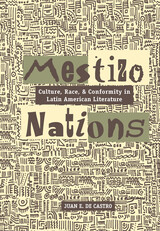 Mestizo Nations: Culture, Race, and Conformity in Latin American Literature
Juan E. De Castro
University of Arizona Press, 2002 Nationality in Latin America has long been entwined with questions of racial identity. Just as American-born colonial elites grounded their struggle for independence from Spain and Portugal in the history of Amerindian resistance, constructions of nationality were based on the notion of the fusion of populations heterogeneous in culture, race, and language. But this rhetorical celebration of difference was framed by a real-life pressure to assimilate into cultures always defined by Iberian American elites. In Mestizo Nations, Juan De Castro explores the construction of nationality in Latin American and Chicano literature and thought during the nineteenth and twentieth centuries. Focusing on the discourse of mestizaje—which proposes the creation of a homogenous culture out of American Indian, black, and Iberian elements—he examines a selection of texts that represent the entire history and regional landscape of Latin American culture in its Western, indigenous, and neo-African traditions from Independence to the present.
Through them, he delineates some of the ambiguities and contradictions that have beset this discourse. Among texts considered are the Indianist novel Iracema by the nineteenth-century Brazilian author José de Alencar; the Tradiciones peruanas, Peruvian Ricardo Palma's fictionalizations of national difference; and historical and sociological essays by the Peruvian Marxist José Carlos Mariátegui and the Brazilian intellectual Gilberto Freyre. And because questions raised by this discourse are equally relevant to postmodern concerns with national and transnational heterogeneity, De Castro also analyzes such recent examples as the Cuban dance band Los Van Van's use of Afrocentric lyrics; Richard Rodriguez's interpretations of North American reality; and points of contact and divergence between José María Arguedas's novel The Fox from Up Above and the Fox from Down Below and writings of Gloria Anzaldúa and Julia Kristeva.
By updating the concept of mestizaje as a critical tool for analyzing literary text and cultural trends—incorporating not only race, culture, and nationality but also gender, language, and politics—De Castro shows the implications of this Latin American discursive tradition for current critical debates in cultural and area studies. Mestizo Nations contains important insights for all Latin Americanists as a tool for understanding racial relations and cultural hybridization, creating not only an important commentary on Latin America but also a critique of American life in the age of multiculturalism.
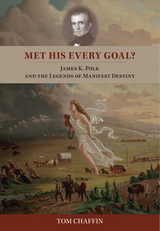 Met His Every Goal?: James K. Polk and the Legends of Manifest Destiny
Tom Chaffin
University of Tennessee Press, 2015 Soon after winning the presidency in 1845, according to the oft-repeated anecdote, James K. Polk slapped his thigh and predicted what would be the "four great measures" of his administration: the acquisition of some or all of the Oregon Country, the acquisition of California, a reduction in tariffs, and the establishment of a permanent independent treasury. Over the next four years, the Tennessee Democrat achieved all four goals. And those milestones—along with his purported enunciation of them—have come to define his presidency. Indeed, repeated ad infinitum in U.S. history textbooks, Polk's bold listing of goals has become U.S. political history’s equivalent of Babe Ruth’s called home run of the 1932 World Series, in which the slugger allegedly gestured toward the outfield and, on the next pitch, slammed a home run.
But then again, as Tom Chaffin reveals in this lively tour de force of historiographic sleuthing, like Ruth's alleged "called shot" of 1932, the "four measures" anecdote hangs by the thinnest of evidentiary threads. Indeed, not until the late 1880s, four decades after Polk’s presidency, did the story first appear in print.
In this eye-opening study, Tom Chaffin, author, historian, and, since 2008, editor of the multi-volume series Correspondence of James K. Polk, dispatches the thigh-slap anecdote and other misconceptions associated with Polk. In the process, Chaffin demonstrates how the "four measures" story has skewed our understanding of the 11th U.S. president. As president, Polk enlarged his nation's area by a third—thus rendering it truly a coast-to-coast continental nation-state. Indeed, the anecdote does not record, and effectively obscures complex events, including notable failures—such as Polk's botched effort to purchase Cuba, as well as his inability to shape the terms of California's and the New Mexico territory's admission into the Union. Cuba would never enter the federal Union; and those other tasks would be left for successor presidents. Indeed, debates over the future of slavery in the United States—debates accelerated by Polk's territorial gains—eventually produced perhaps the central irony of his legacy: A president devoted to national unity further sectionalized the nation’s politics, widening geopolitical fractures among the states that soon led to civil war.
Engagingly written and lavishly illustrated, Met His Every Goal?—intended for general readers, students, and specialists—offers a primer on Polk and a revisionist view of much of the scholarship concerning him and his era. Drawing on published scholarship as well as contemporary documents—including heretofore unpublished materials—it presents a fresh portrait of an enigmatic autocrat. And in Chaffin's examination of an oft-repeated anecdote long accepted as fact, readers witness a case study in how historians use primary sources to explore—and in some cases, explode—received conceptions of the past.
MET vol 47 num 1
The University of Chicago Press
University of Chicago Press Journals, 2013
MET vol 48 num 1
The University of Chicago Press
University of Chicago Press Journals, 2014 This is volume 48 issue 1 of Metropolitan Museum Journal. Founded in 1968, the Metropolitan Museum Journal is a blind, peer-reviewed scholarly journal published annually that features original research on the history, interpretation, conservation, and scientific examination of works of art in the Museum’s collection. Its scope encompasses the diversity of artistic practice from antiquity to the present day. The Journal encourages contributions offering critical and innovative approaches that will further our understanding of works of art.
MET vol 49 num 1
The University of Chicago Press
University of Chicago Press Journals, 2015
MET vol 50 num 1
The University of Chicago Press
University of Chicago Press Journals, 2016
MET vol 51 num 1
The University of Chicago Press
University of Chicago Press Journals, 2016
MET vol 52 num 1
The University of Chicago Press
University of Chicago Press Journals, 2017 This is volume 52 issue 1 of Metropolitan Museum Journal. Founded in 1968, the Metropolitan Museum Journal is a blind, peer-reviewed scholarly journal published annually that features original research on the history, interpretation, conservation, and scientific examination of works of art in the Museum’s collection. Its scope encompasses the diversity of artistic practice from antiquity to the present day. The Journal encourages contributions offering critical and innovative approaches that will further our understanding of works of art.
MET vol 53 num 1
The University of Chicago Press
University of Chicago Press Journals, 2018 This is volume 53 issue 1 of Metropolitan Museum Journal. Founded in 1968, the Metropolitan Museum Journal is a blind, peer-reviewed scholarly journal published annually that features original research on the history, interpretation, conservation, and scientific examination of works of art in the Museum’s collection. Its scope encompasses the diversity of artistic practice from antiquity to the present day. The Journal encourages contributions offering critical and innovative approaches that will further our understanding of works of art.
MET vol 54 num 1
The University of Chicago Press
University of Chicago Press Journals, 2019
MET vol 55 num 1
The University of Chicago Press
University of Chicago Press Journals, 2020
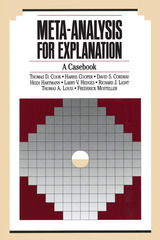 Meta-Analysis for Explanation: A Casebook
Thomas D. Cook
Russell Sage Foundation, 1992 Social science research often yields conflicting results: Does juvenile delinquent rehabilitation work? Is teenage pregnancy prevention effective? In an effort to improve the value of research for shaping social policy, social scientists are increasingly employing a powerful technique called meta-analysis. By systematically pulling together findings of a particular research problem, meta-analysis allows researchers to synthesize the results of multiple studies and detect statistically significant patterns among them. Meta-Analysis for Explanation brings exemplary illustrations of research synthesis together with expert discussion of the use of meta-analytic techniques. The emphasis throughout is on the explanatory applications of meta-analysis, a quality that makes this casebook distinct from other treatments of this methodology. The book features four detailed case studies by Betsy Jane Becker, Elizabeth C. Devine, Mark W. Lipsey, and William R. Shadish, Jr. These are offered as meta-analyses that seek both to answer the descriptive questions to which research synthesis is traditionally directed in the health and social sciences, and also to explore how a more systematic method of explanation might enhance the policy yield of research reviews. To accompany these cases, a group of the field's leading scholars has written several more general chapters that discuss the history of research synthesis, the use of meta-analysis and its value for scientific explanation, and the practical issues and challenges facing researchers who want to try this new technique. As a practical resource, Meta-Analysis for Explanation guides social scientists to greater levels of sophistication in their efforts to synthesize the results of social research. "This is an important book...[it is] another step in the continuing exploration of the wider implications and powers of meta-analytic methods." —Contemporary Psychology
 Metabolic Arrest and the Control of Biological Time
Peter W. Hochachka and Michael Guppy
Harvard University Press, 1987 Freshwater turtles and goldfish can survive for several days without oxygen, some diving turtles for several months; hibernating animals can exist without food for long periods; others can survive extreme conditions such as desiccation, freezing, and thawing. These creatures are, in effect, self-sustaining life-support systems, with a mysterious ability to regulate their own metabolisms.
These capabilities raise important questions, which Hochachka and Guppy explore in this seminal new book. What mechanisms turn down (or off) cell metabolism and other cell functions? How does an animal such as an opossum know when to activate mechanisms for slowing or stopping tissue and organ functions? How does it know when to turn them on again? How extensive is metabolic arrest as a defense against harsh environmental conditions? Can we decipher universal principles of metabolic arrest from available data? The lessons to be learned are of potentially great interest to clinicians, because the authors provide a theoretical framework in which to organize an attack on the all-too-practical problem of protecting tissues against hypoxia. Areas that may be influenced include research on cardiac arrest, strokes, acute renal failure, liver ischemia, lung injury, respiratory defense syndrome, claudication, shock, and organ transplant. Investigation of other metabolic arrest mechanisms may be similarly useful in both clinical and agricultural fields.
This is a pioneering book of great use to biomedical/clinical researchers and to biologists, biochemists, and physiologists generally.
Metabolic Homeostasis: A Syllabus for Those Concerned with the Care of Patients
Nathan B. Talbot, Robert H. Richie, and John D. Crawford
Harvard University Press In extensive research already reported in the authors’ authoritative volume, Functional Endocrinology from Birth through Adolescence, it was shown that the output of an endocrine gland must be evaluated in relation to physiological needs which are changing constantly. Study of the various circumstances of disease in these areas led to the development of a number of procedures which can be used by the physician to assist the body in overcoming or alleviating the abnormality encountered. The present syllabus will be useful in the solution of diagnostic and therapeutic problems.
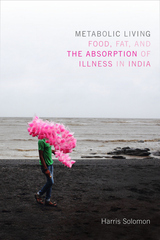 Metabolic Living: Food, Fat, and the Absorption of Illness in India
Harris Solomon
Duke University Press, 2016 The popular narrative of "globesity" posits that the adoption of Western diets is intensifying obesity and diabetes in the Global South and that disordered metabolisms are the embodied consequence of globalization and excess. In Metabolic Living Harris Solomon recasts these narratives by examining how people in Mumbai, India, experience the porosity between food, fat, the body, and the city. Solomon contends that obesity and diabetes pose a problem of absorption between body and environment. Drawing on ethnographic fieldwork carried out in Mumbai's home kitchens, metabolic disorder clinics, food companies, markets, and social services, he details the absorption of everything from snack foods and mangoes to insulin, stress, and pollutants. As these substances pass between the city and the body and blur the two domains, the onset and treatment of metabolic illness raise questions about who has the power to decide what goes into bodies and when food means life. Evoking metabolism as a condition of contemporary urban life and a vital political analytic, Solomon illuminates the lived predicaments of obesity and diabetes, and reorients our understanding of chronic illness in India and beyond.
 Metabolics: Poems
Jessica E. Johnson
Acre Books, 2023 In this debut poetry collection, a single speaker tries to control her body and negotiate her time with digital devices, all the while navigating identities, impulses, and relationships that are often in tension.
Metabolics, a book-length poem, borrows the movements of metabolic pathways to consider how nature accomplishes both balance and deep transformation. In visual figures and prose blocks that bridge the divide between poetry and nonfiction, Jessica E. Johnson employs scientific idioms to construct an allegory about a family in the Pacific Northwest. The region becomes a character in its own right, with cedars, moss, and heavy cloud knitting the mother, father, boy, and girl into their setting.
This far-reaching volume also serves as a study of the ecologies of contemporary parenting, with adults and children affected by “feeds” both on screen and off as their bodies metabolize food, the environment, and excess feelings such as rage. From climate change to kombucha to smartphones and curated produce, the smallest details of daily life in “Plasticland” catalyze a larger examination of selfhood: “Despite so many attempts to resolve this tension, sometimes you are you and also sometimes mother just as light can be both particle and wave.”
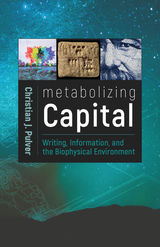 Metabolizing Capital: Writing, Information, and the Biophysical Environment
Christian J. Pulver
Utah State University Press, 2020 Metabolizing Capital outlines a critical ecological framework to guide the theorization of writing and rhetoric in the dynamic contexts of Web 3.0 and environmental crisis.
The rise of the global cloud and the internet-of-things have ushered in a new stage of the internet that marks a transition from the celebrated user-generated content of Web 2.0 to the data-driven networks of Web 3.0. As social media networks have expanded, so has the amount of writing and communication we do online. This has created several valuable sub-layers of data and metadata about consumer-citizens that corporations and governments now routinely collect, store, and monetize. This frenzy to collect more data is contributing to several problematic social and environmental concerns as flows of information and capital dangerously accelerate how energy and matter move through ecosystems at every scale.
This book explores the planetary consequences of Web 3.0 and the vital role that writing and data production play in accelerating capital circulation, from concerns raised by the growing energy demands of the information industries, to growing streams of electronic waste, to the growing socioeconomic tensions arising as a result of information monopolies.
A posthuman, Marxist analysis of digital culture and writing, Metabolizing Capital contributes to and challenges current understandings of rhetorical agency and actor networks. Combining scholarship from writing studies, rhetoric, and composition with research in metabolic ecology, information theory, media studies, cognitive psychology, history, and new materialism, this book should be of interest to scholars in writing studies as well as others who study digital culture, ecological literacies, the history of writing and information, big data, and environmental concerns related to electronics and the information industries.
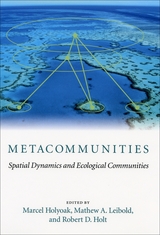 Metacommunities: Spatial Dynamics and Ecological Communities
Edited by Marcel Holyoak, Mathew A. Leibold, and Robert D. Holt
University of Chicago Press, 2005 Until recently community ecology—a science devoted to understanding the patterns and processes of species distribution and abundance—focused mainly on specific and often limited scales of a single community. Since the 1970s, for example, metapopulation dynamics—studies of interacting groups of populations connected through movement—concentrated on the processes of population turnover, extinction, and establishment of new populations.
Metacommunities takes the hallmarks of metapopulation theory to the next level by considering a group of communities, each of which may contain numerous populations, connected by species interactions within communities and the movement of individuals between communities. In examining communities open to dispersal, the book unites a broad range of ecological theories, presenting some of the first empirical investigations and revealing the value of the metacommunity approach.
The collection of empirical, theoretical, and synthetic chapters in Metacommunities seeks to understand how communities work in fragmented landscapes. Encouraging community ecologists to rethink some of the leading theories of population and community dynamics, Metacommunities urges ecologists to expand the spatiotemporal scales of their research.
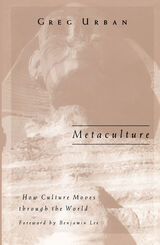 Metaculture: How Culture Moves through the World
Greg Urban
University of Minnesota Press, 2001 It is one thing to comprehend how culture makes its way through the world in those cases where something old is reproduced in the same physical shape-where, for example, a song is sung or a story retold. It is another thing altogether, as Greg Urban demonstrates, to think about cultural motion when something new is created-a new song or a new story. And this, the creating of new culture, is the overarching value of the contemporary world, as well as the guiding principle of the capitalist entrepreneur. From the Declaration of Independence to the movie Babe, from the Amazon River to the film studio, from microscopic studies of the words making up myths and books to the large-scale forces of conquest, conversion, and globalization that drive history, Urban follows the clues to a startling revelation: "metaculture" makes the modern, entrepreneurial form of culture possible. In Urban’s work we see how metaculture, in its relationship to newness, explains the peculiar shape of modern society and its institutions, from the prevalence of taste and choice to the processes of the public sphere, to the centrality of persuasion and hegemony within the nation.
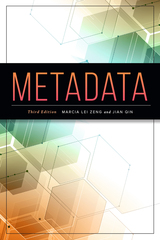 Metadata
Jian Qin
American Library Association, 2022 This benchmark text is back in a new edition thoroughly updated to incorporate developments and changes in metadata and related domains. Zeng and Qin provide a solid grounding in the variety and interrelationships among different metadata types, offering a comprehensive look at the metadata schemas that exist in the world of library and information science and beyond. Readers will gain knowledge and an understanding of key topics such as - the fundamentals of metadata, including principles of metadata, structures of metadata vocabularies, and metadata descriptions;
- metadata building blocks, from modeling to defining properties, from designing application profiles to implementing value vocabularies, and from specification generating to schema encoding, illustrated with new examples;
- best practices for metadata as linked data, the new functionality brought by implementing the linked data principles, and the importance of knowledge organization systems;
- resource metadata services, quality measurement, and interoperability approaches;
- research data management concepts like the FAIR principles, metadata publishing on the web and the recommendations by the W3C in 2017, related Open Science metadata standards such as Data Catalog Vocabulary (DCAT) version 2, and metadata-enabled reproducibility and replicability of research data;
- standards used in libraries, archives, museums, and other information institutions, plus existing metadata standards’ new versions, such as the EAD 3, LIDO 1.1, MODS 3.7, DC Terms 2020 release coordinating its ISO 15396-2:2019, and Schema.org’s update in responding to the pandemic; and
- newer, trending forces that are impacting the metadata domain, including entity management, semantic enrichment for the existing metadata, mashup culture such as enhanced Wikimedia contents, knowledge graphs and related processes, semantic annotations and analysis for unstructured data, and supporting digital humanities (DH) through smart data.
A supplementary website provides additional resources, including examples, exercises, main takeaways, and editable files for educators and trainers.
Metadata
Marcia Lei Zeng
American Library Association, 2016
Metadata
Marcia Lei Zeng
American Library Association, 2008
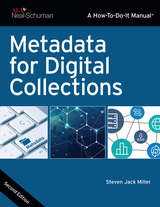 Metadata for Digital Collections
Steven Jack Miller
American Library Association, 2022 Since it was first published, LIS students and professionals everywhere have relied on Miller’s authoritative manual for clear instruction on the real-world practice of metadata design and creation. Now the author has given his text a top to bottom overhaul to bring it fully up to date, making it even easier for readers to acquire the knowledge and skills they need, whether they use the book on the job or in a classroom. By following this book’s guidance, with its inclusion of numerous practical examples that clarify common application issues and challenges, readers will - learn about the concept of metadata and its functions for digital collections, why it’s essential to approach metadata specifically as data for machine processing, and how metadata can work in the rapidly developing Linked Data environment;
- know how to create high-quality resource descriptions using widely shared metadata standards, vocabularies, and elements commonly needed for digital collections;
- become thoroughly familiarized with Dublin Core (DC) through exploration of DCMI Metadata Terms, CONTENTdm best practices, and DC as Linked Data;
- discover what Linked Data is, how it is expressed in the Resource Description Framework (RDF), and how it works in relation to specific semantic models (typically called “ontologies”) such as BIBFRAME, comprised of properties and classes with “domain” and “range” specifications;
- get to know the MODS and VRA Core metadata schemes, along with recent developments related to their use in a Linked Data setting;
- understand the nuts and bolts of designing and documenting a metadata scheme; and
- gain knowledge of vital metadata interoperability and quality issues, including how to identify and clean inconsistent, missing, and messy metadata using innovative tools such as OpenRefine.
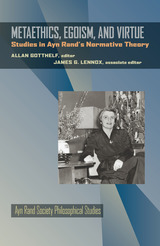 Metaethics, Egoism, and Virtue: Studies in Ayn Rand's Normative Theory
Allan Gotthelf
University of Pittsburgh Press, 2010
Philosopher-novelist Ayn Rand (1905–1982) is a cultural phenomenon. Her books have sold more than 25 million copies, and countless individuals speak of her writings as having significantly influenced their lives. In spite of the popular interest in her ideas, or perhaps because of it, Rand’s work has until recently received little serious attention from academics. Though best known among philosophers for her strong support of egoism in ethics and capitalism in politics, there is an increasingly widespread awareness of both the range and the systematic character of Rand’s philosophic thought. This new series, developed in conjunction with the Ayn Rand Society, an affiliated group of the American Philosophical Association, Eastern Division, seeks a fuller scholarly understanding of this highly original and influential thinker.
The first volume starts not with the metaphysical and epistemological fundamentals of Rand’s thought, but with central aspects of her ethical theory. Though her endorsement of ethical egoism is well-known—one of her most familiar essay collections is The Virtue of Selfishness—the character of her egoism is not. The chapters in this volume address the basis of her egoism in a virtue-centered normative ethics; her account of how moral norms in general are themselves based on a fundamental choice by an agent to value his own life; and how her own approach to the foundations of ethics is to be compared and contrasted with familiar approaches in the analytic ethical tradition. Philosophers interested in the objectivity of value, in the way ethical theory is (and is not) virtue-based, and in acquiring a serious understanding of an egoistic moral theory worthy of attention will find much to consider in this volume, which includes critical responses to several of its main essays.
The Metafictional Muse: The Works of Robert Coover, Donald Barthelme, and William H. Gass
Larry McCaffery
University of Pittsburgh Press, 1982
McCaffery interprets the works of three major writers of radically experimental fiction: Robert Coover; Donald Barthelme; and Willam H. Gass. The term “metafiction” here refers to a strain in American writing where the self-concious approach to the art of fiction-making is a commentary on the nature of meaning itself.
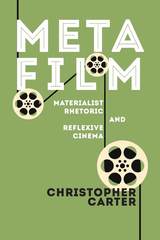 Metafilm: Materialist Rhetoric and Reflexive Cinema
Christopher Carter
Ohio State University Press, 2018 In Metafilm: Materialist Rhetoric and Reflexive Cinema, Christopher Carter examines paradoxical rhetoric in visual culture, analyzing movies that immerse viewers in violent narratives while examining the ethics of the transaction. Featuring the films of Michael Haneke, Atom Egoyan, Icíar Bollaín, Paul Thomas Anderson, and Ryan Coogler, Carter analyzes how personal conflict intermingles with the inherent violence of warfare, transnational economics, labor exploitation, and racism in genres ranging from horror to historical recreation and from depictions of genocide to records of police brutality. These films, Carter argues, reflect on their construction, distribution, and audience engagement, emphasizing the material design and the economics of rhetoric in ways most films do not.
Ultimately, Metafilm reframes materialism as a multimodal composing-in-action, or reflexive materialism, focusing on movies that dramatize their entanglement in economic and historical trauma while provoking forms of resistance during and after viewing. Carter contends that even as we recognize the division of social power in the films, we must also recognize how the concept is subversive and eludes control. In looking at the interplay between the films’ content and their production, circulation, and reception, Carter explores how the films persuade us to identify with onscreen worlds before probing our expectations—validating some, rejecting others, and sometimes proposing new ways of watching altogether.
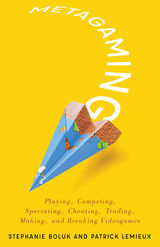 Metagaming: Playing, Competing, Spectating, Cheating, Trading, Making, and Breaking Videogames
Stephanie Boluk
University of Minnesota Press, 2017 The greatest trick the videogame industry ever pulled was convincing the world that videogames were games rather than a medium for making metagames. Elegantly defined as “games about games,” metagames implicate a diverse range of practices that stray outside the boundaries and bend the rules: from technical glitches and forbidden strategies to Renaissance painting, algorithmic trading, professional sports, and the War on Terror. In Metagaming, Stephanie Boluk and Patrick LeMieux demonstrate how games always extend beyond the screen, and how modders, mappers, streamers, spectators, analysts, and artists are changing the way we play. Metagaming uncovers these alternative histories of play by exploring the strange experiences and unexpected effects that emerge in, on, around, and through videogames. Players puzzle through the problems of perspectival rendering in Portal, perform clandestine acts of electronic espionage in EVE Online, compete and commentate in Korean StarCraft, and speedrun The Legend of Zelda in record times (with or without the use of vision). Companies like Valve attempt to capture the metagame through international e-sports and online marketplaces while the corporate history of Super Mario Bros. is undermined by the endless levels of Infinite Mario, the frustrating pranks of Asshole Mario, and even Super Mario Clouds, a ROM hack exhibited at the Whitney Museum of American Art. One of the only books to include original software alongside each chapter, Metagaming transforms videogames from packaged products into instruments, equipment, tools, and toys for intervening in the sensory and political economies of everyday life. And although videogames conflate the creativity, criticality, and craft of play with the act of consumption, we don’t simply play videogames—we make metagames.
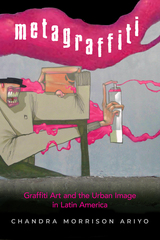 Metagraffiti: Graffiti Art and the Urban Image in Latin America
Chandra Morrison Ariyo
Rutgers University Press, 2025 Focusing on graffiti scenes from São Paulo and Santiago in Chile, this innovative visual ethnography examines diverse forms of self-reference and metareference that appear in Latin American graffiti art. Chandra Morrison Ariyo works across multiple scales of contemporary graffiti production—from tags to massive murals—to show how painting the city enables individuals to reimagine their own position within the material and social structures around them. Metagraffitti reveals how practitioners such as Tinho, OSGEMEOS, Grin, and Bisy use metagraffiti features to influence public perceptions about this art form and its effect on the urban environment. Ultimately, Metagraffiti proposes a novel conceptual framework that highlights graffiti’s ability to forge alternative forms of movement, sociality, and value within Latin American cityscapes. These urban images invite us to imagine what the city could be, when seen as a site for action and imagination.
Metaheuristic Optimization in Power Engineering
Jordan Radosavljević
The Institution of Engineering and Technology, 2018 A metaheuristic is a consistent set of ideas, concepts, and operators to design a heuristic optimization algorithm, that can provide a sufficiently good solution to an optimization problem with incomplete or imperfect information. Modern and emerging power systems, with the growing complexity of distributed and intermittent generation, are an important application for such methods.
Metaheuristic Optimization in Power Engineering: Algorithms and power dispatch using MATLAB®-based software, Volume 1
Jordan Radosavljević
The Institution of Engineering and Technology, 2024 A metaheuristic is a higher-level procedure designed to find, generate, or select a heuristic or partial search algorithm that may provide a sufficiently good solution to an optimization problem with incomplete or imperfect information or limited computation capacity. Metaheuristics can often find good solutions with less computational effort than other algorithms. Modern and emerging power systems, with the growing complexity of distributed and intermittent generation and EV charging, are an application for such methods.
Metaheuristic Optimization in Power Engineering: Distribution systems using MATLAB®-based software, Volume 2
Jordan Radosavljević
The Institution of Engineering and Technology, 2024 A metaheuristic is a higher-level procedure designed to find, generate, or select a heuristic or partial search algorithm that may provide a sufficiently good solution to an optimization problem with incomplete or imperfect information or limited computation capacity. Metaheuristics can often find good solutions with less computational effort than other algorithms. Modern and emerging power systems, with the growing complexity of distributed and intermittent generation and EV charging, are an application for such methods.
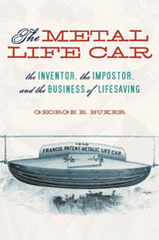 The Metal Life Car: The Inventor, the Impostor, and the Business of Lifesaving
George E. Buker
University of Alabama Press, 2008 Engineering the battlefield—one armored advance at a time. For centuries sailing vessels crept along the coastline, ready to flee ashore in case of danger or trouble; this worked well until weather or poor sailing drove these ships against an unforgiving coast. Saviors and salvors (often the same people) struggled to rescue both humans and cargo, often with results as tragic for them as for the sailors and passengers. Joseph Francis (b. Boston, Massachusetts, 1801) was an inventor who also had the ability to organize a business to produce his inventions and the salesmanship to sell his products. His metal lifeboats, first used in survey expeditions in Asia Minor and Central America, came into demand among the world’s merchant marine, the U.S. Navy, and the U.S. Revenue Service. His corrugated “life car” was the keystone to development of the U.S. Life-Saving Service. Francis’s metal bateaux and lifeboats played an important role in the Third Seminole War in Florida. His metal pontoon army wagons served in the trans-Mississippi campaigns against the Indians. In Europe, he was acclaimed as a genius and sold patent rights to shipyards in Liverpool and the Woolwich Arsenal in England, Le Havre seaport in France, in the free city of Hamburg, and in the Russian Empire. But while Francis was busy in Europe, Captain Douglass Ottinger, U.S. Revenue Marine Service, claimed to be the inventor of Francis’s life car and obtained support in the U.S. Congress and the Patent Office for his claim. Francis had to battle for decades to prove his rights, and Americans remained generally unfamiliar with his devices, thereby condemning Civil War armies to inferior copies while Europe was using, and acclaiming, his inventions.
 The Metal of a Thousand Uses: Mercury Mining in Arkansas, 1930-1946
Terry S. Reynolds
University of Arkansas Press, 2026 In 1930, a remote corner of southwest Arkansas witnessed the discovery of cinnabar, the ore from which mercury is extracted. Upon the arrival of “the metal of a thousand uses,” a wave of hope and ambition swept through the foothills of the Ouachita Mountains as mercury mining promised economic revival for the struggling state. Despite the known dangers of the industry, Arkansans greeted the prospect of a mercury boom with unbridled enthusiasm, seeing it as a potential solution to their economic woes amid the Great Depression. In The Metal of a Thousand Uses: Mercury Mining in Arkansas, 1930–1946, Terry S. Reynolds charts the dramatic rise and fall of the state’s mercury mining district, from the euphoria of discovery to the logistical and financial challenges of industrialization. Drawing on deep archival research, Reynolds explores the experiences of the miners and managers whose fates became bound to the companies that sought to commercialize mercury refining in the Ouachita Mountains. The result is a vivid account of a little-known chapter in American mineral-resource history.
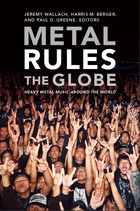 Metal Rules the Globe: Heavy Metal Music around the World
Jeremy Wallach, Harris M. Berger, and Paul D. Greene, eds.
Duke University Press, 2012 During the past three decades, heavy metal music has gone global, becoming a potent source of meaning and identity for fans around the world. In Metal Rules the Globe, ethnographers and some of the foremost authorities in the burgeoning field of metal studies analyze this dramatic expansion of heavy metal music and culture. They take readers inside metal scenes in Brazil, Canada, China, Easter Island, Indonesia, Israel, Japan, Malaysia, Malta, Nepal, Norway, Singapore, Slovenia, and the United States, describing how the sounds of heavy metal and the meanings that metalheads attribute to them vary across cultures. The contributors explore the dynamics of masculinity, class, race, and ethnicity in metal scenes; the place of metal in the music industry; and the ways that disenfranchised youth use metal to negotiate modernity and social change. They reveal heavy metal fans as just as likely to criticize the consumerism, class divisiveness, and uneven development of globalization as they are to reject traditional cultural norms. Crucially, they never lose sight of the sense of community and sonic pleasure to be experienced in the distorted, pounding sounds of local metal scenes. Contributors. Idelber Avelar, Albert Bell, Dan Bendrups, Harris M. Berger, Paul D. Greene, Ross Hagen, Sharon Hochhauser, Shuhei Hosokawa, Keith Kahn-Harris, Kei Kawano, Rajko Muršič,Steve Waksman, Jeremy Wallach, Robert Walser, Deena Weinstein, Cynthia P. Wong
 Metalinguistic Development
Jean Émile Gombert
University of Chicago Press, 1992 At a very early age, the child is able to use and understand
language correctly. Later comes the precocious ability to
“reflect” upon and deliberately control its use.
Metalinguistic development, or the emergence of a reflective
attitude to the comprehension and production of oral and
written language, must be distinguished from that of ordinary
verbal communication.
This is the first book to review and analyze what is
known about metacognitive processes in relation to language.
Each of its seven chapters deals systematically with the
relationship between the comprehension and production of the
phonetic, syntactic, semantic, pragmatic, and textual aspects
of language. This material is then related to the
metacognitive principles which govern reflective awareness.
A concluding chapter deals with written language and
metalinguistics.
Jean Émile Gombert's novel description of processes such
as the understanding of metaphor and humor in relation to
pragmatics and his suggestion that metalinguistic knowledge
is intimately connected with literacy contribute to a fuller
understanding of the stages of language acquisition and
mastery. With clarity and insight, Metalinguistic
Development reveals how the capacity for reflection gives
rise to emergent properties of the language system.
“A clear, critical, and interesting book about
an important topic which has not been reviewed properly
before. I particularly like the way that Jean Eacute;mile Gombert
combines a comprehensive account of American work with a very
impressive knowledge of European work.”—Peter Bryant,
University of Oxford
Jean Émile Gombert teaches genetic psychology at the
University of Dijon.
Metalwork from Sardis: The Finds Through 1974
J. C. Waldbaum
Harvard University Press, 1983 In this eighth monograph on the archaeological excavations at Sardis, Jane C. Waldbaum presents the evidence for metal industries at the site, from the early Bronze Age through the gold refinery of the Lydian kings to the Late Antique and Byzantine ironworks. More than one thousand objects made of metal or related to metalworking are catalogued and illustrated. These finds are placed in historical context with the help of ancient literary and epigraphic sources. This corpus of metalwork from an important site makes a substantial contribution to Mediterranean archaeology, and adds to the series of publications that will constitute a full technical report on this massive excavation.
Metamaterials and Metasurfaces: Foundations, trends and applications
Subal Kar
The Institution of Engineering and Technology, 2025 This book provides an introduction to the world of metamaterials and metasurfaces; artificially engineered materials that can control electromagnetic waves in ways not found in nature. These materials exhibit unusual effects with applications ranging from miniaturised antennas to advanced sensors, energy harvesting, and even future communication systems.
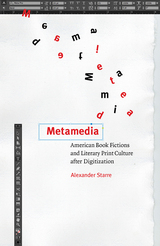 Metamedia: American Book Fictions and Literary Print Culture after Digitization
Alexander Starre
University of Iowa Press, 2015 Does literature need the book? With electronic texts and reading devices growing increasingly popular, the codex is no longer the default format of fiction. Yet as Alexander Starre shows in Metamedia, American literature has rediscovered the book as an artistic medium after the first e-book hype in the late 1990s. By fusing narrative and design, a number of “bibliographic” writers have created reflexive fictions—metamedia—that invite us to read printed formats in new ways. Their work challenges ingrained theories and beliefs about literary communication and its connections to technology and materiality. Metamedia explores the book as a medium that matters and introduces innovative critical concepts to better grasp its narrative significance.
Combining sustained textual analysis with impulses from the fields of book history, media studies, and systems theory, Starre explains the aesthetics and the cultural work of complex material fictions, such as Mark Z.Danielewski’s House of Leaves (2000), Chip Kidd’s The Cheese Monkeys (2001), Salvador Plascencia’s The People of Paper (2005), Reif Larsen’s The Selected Works of T. S. Spivet (2009), and Jonathan Safran Foer’s Tree of Codes (2010). He also broadens his analysis beyond the genre of the novel in an extensive account of the influential literary magazine McSweeney’s Quarterly Concern and its founder, Dave Eggers.
For this millennial generation of writers and publishers, the computer was never a threat to print culture, but a powerful tool to make better books. In careful close readings, Starre puts typefaces, layouts, and cover designs on the map of literary criticism. At the same time, the book steers clear of bibliophile nostalgia and technological euphoria as it follows writers, designers, and publishers in the process of shaping the surprising history of literary bookmaking after digitization.
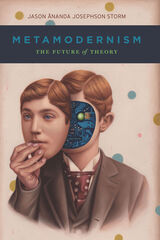 Metamodernism: The Future of Theory
Jason Ananda Josephson Storm
University of Chicago Press, 2021 For decades, scholars have been calling into question the universality of disciplinary objects and categories. The coherence of defined autonomous categories—such as religion, science, and art—has collapsed under the weight of postmodern critiques, calling into question the possibility of progress and even the value of knowledge. Jason Ānanda Josephson Storm aims to radicalize and move beyond these deconstructive projects to offer a path forward for the humanities and social sciences using a new model for theory he calls metamodernism.
Metamodernism works through the postmodern critiques and uncovers the mechanisms that produce and maintain concepts and social categories. In so doing, Storm provides a new, radical account of society’s ever-changing nature—what he calls a “Process Social Ontology”—and its materialization in temporary zones of stability or “social kinds.” Storm then formulates a fresh approach to philosophy of language by looking beyond the typical theorizing that focuses solely on human language production, showing us instead how our own sign-making is actually on a continuum with animal and plant communication.
Storm also considers fundamental issues of the relationship between knowledge and value, promoting a turn toward humble, emancipatory knowledge that recognizes the existence of multiple modes of the real. Metamodernism is a revolutionary manifesto for research in the human sciences that offers a new way through postmodern skepticism to envision a more inclusive future of theory in which new forms of both progress and knowledge can be realized.
Metamorphoses: A Play
Mary Zimmerman
Northwestern University Press, 2002 A beautiful and deeply humane reanimation of Ovid's myths Called by Time the "theater event of the year," Mary Zimmerman's Metamorphoses brings Ovid's tales to stunning visual life. Set in and around a large pool of water onstage, Metamorphoses juxtaposes the ancient and the contemporary in both language and image to reflect the variety and persistence of narrative in the face of inevitable change. Nominated for three 2002 Tony Awards, including "Best Play," Metamorphoses earned Zimmerman a Tony for "Best Direction of a Play."
 Metamorphoses in Nineteenth-Century Sculpture
Jeanne L. Wasserman
Harvard University Press, 1975 The detective work of art history—recreating the past with visual clues and often scanty documentation—becomes particularly challenging in the case of cast sculpture since the nineteenth century. Increasing popular demand for small versions of well-known monuments, and technical advances which made mass production of sculpture available for the first time, tempted nineteenth-century artists to profitably reproduce their works. Collectors, dealers, and scholars today are faced with the problem of unraveling the histories of the legions of reproductions left behind.
Metamorphoses in Nineteenth-Century Sculpture confronts the question of originality through visual comparison of similar works brought together, possibly for the first time. Groups of sculptures by Houdon, Barye, Carpeaux, Rodin, Saint-Gaudens, and Daniel Chester French are considered. Problems of quality and the obvious or subtle changes in the character of a sculpture as it is changed in size, translated into other materials, or cast from other casts must all be faced in the evaluation of a serial piece. Here technical specialists have joined with art scholars to retrace the evolution of each series from the artist’s original concept to its final edition, in many cases long after the sculptor’s death.
After two years of consultation and correspondence with almost seventy lenders, the Fogg Museum at Harvard chose more than one hundred objects for first-hand study. Then Professor Jacques de Caso, who wrote the historical and legal introduction, and six other authorities on the sculptors traveled to Cambridge to confront the objects and consult with Jeanne Wasserman. The material in these chapters is a synthesis of the knowledge and insights contributed by both technical specialists and art historians.
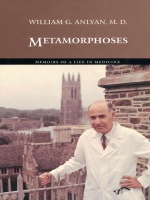 Metamorphoses: Memoirs of a Life in Medicine
William G. Anlyan, M. D.
Duke University Press, 2004 William G. Anlyan, a dedicated doctor and gifted administrator, was a leader in the transformation of Duke University Hospital from a regional medical center into one of America’s foremost biomedical research and educational institutions. Anlyan’s fifty-five-year career at Duke University spanned a period of extraordinary change in the practice of medicine. He chronicles those transformations—and his role in them—in this forthright memoir. Born in Alexandria, Egypt, in 1925, and schooled in the British tradition, Anlyan attended Yale University as an undergraduate and medical student before coming to the relatively unknown medical school at Duke University in 1949 for an internship in general and thoracic surgery. He stayed on, first as a resident, then as a staff surgeon. By 1961, he was a full professor of surgery. In 1964, Anlyan was named dean of the medical school, the first in a series of administrative posts at the medical school and hospital. Anlyan’s role in the transformation of the Duke University Medical Center into an internationally renowned health system is manifest: he restructured the medical school and hospital and supervised the addition of almost four million square feet of new or renovated space. He hired outstanding administrators and directed a staff that instituted innovative programs and groundbreaking research centers, such as the Cancer Center and the Physician’s Assistant Program. Anlyan describes a series of metamorphoses in his own life, in the world of medicine, in Durham, and at Duke. At the time of his prep school upbringing in Egypt, medicine was a matter of controlling infectious diseases like tuberculosis and polio. As he became an immigrant medical student and then a young surgeon, he observed vast advances in medical practice and changes in the financing of medical care. During his tenure at Duke, Durham was transformed from a sleepy mill and tobacco town into the “City of Medicine,” a place where patients routinely travel for open-heart surgery and cutting-edge treatments for cancer and other diseases. Anyone interested in health care, medical education, and the history of Duke University will find Anlyan’s memoir of interest.
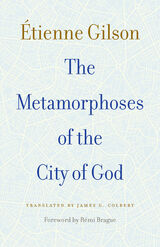 The Metamorphoses of the City of God
Etienne Gilson
Catholic University of America Press, 2021 Étienne Gilson (1884-1978) was a French philosopher and historian of philosophy, as well as a scholar of medieval philosophy. In 1946 he attained the distinction of being elected an "Immortal" (member) of the Académie française. He was nominated for the Nobel Prize in Literature in 1959 and 1964.
The appearance of Gilson's Metamorphosis of the City of God, which were originally delivered as lectures at the University of Louvain, Belgium, in the Spring of 1952, coincided with the first steps toward what would become the European Union. The appearance of this English translation coincides with the upheaval of Brexit. Gilson traces the various attempts of thinkers through the centuries to describe Europe's soul and delimit its parts. The Scots, Catalonians, Flemings, and probably others may nod in agreement in Gilson's observation on how odd would be a Europe composed of the political entities that existed two and a half centuries ago. Those who think the European Union has lost its soul may not be comforted by the difficulty thinkers have had over the centuries in defining that soul. Indeed the difficulties that have thus far prevented integrating Turkey into the EU confirm Gilson's description of the conundrum involved even in distinguishing Europe's material components. And yet, the endeavor has succeeded, so that the problem of shared ideals remain inescapable. One wonders which of the thinkers in the succession studied by Gilson might grasp assent and illuminate the EU's path.
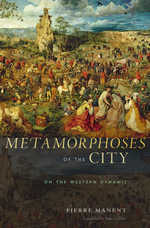 Metamorphoses of the City: On the Western Dynamic
Pierre Manent
Harvard University Press, 2013 What is the best way to govern ourselves? The history of the West has been shaped by the struggle to answer this question, according to Pierre Manent. A major achievement by one of Europe's most influential political philosophers, Metamorphoses of the City is a sweeping interpretation of Europe's ambition since ancient times to generate ever better forms of collective self-government, and a reflection on what it means to be modern.
Manent's genealogy of the nation-state begins with the Greek city-state, the polis. With its creation, humans ceased to organize themselves solely by family and kinship systems and instead began to live politically. Eventually, as the polis exhausted its possibilities in warfare and civil strife, cities evolved into empires, epitomized by Rome, and empires in turn gave way to the universal Catholic Church and finally the nation-state. Through readings of Aristotle, Augustine, Montaigne, and others, Manent charts an intellectual history of these political forms, allowing us to see that the dynamic of competition among them is a central force in the evolution of Western civilization.
Scarred by the legacy of world wars, submerged in an increasingly technical transnational bureaucracy, indecisive in the face of proliferating crises of representative democracy, the European nation-state, Manent says, is nearing the end of its line. What new metamorphosis of the city will supplant it remains to be seen.
 Metamorphoses (The Golden Ass), Volume I: Books 1–6
Apuleius
Harvard University Press, 1989 A beguiling tale of mistaken transformation.
In the Metamorphoses of Apuleius, also known as The Golden Ass, we have the only Latin novel which survives entire. It is truly enchanting: a delightful romance combining realism and magic.
The hero, Lucius, eager to experience the sensations of a bird, resorts to witchcraft but by an unfortunate pharmaceutical error finds himself transformed into an ass. He knows he can revert to his own body by eating rose-petals, but these prove singularly elusive; and the bulk of the work describes his adventures as an animal. He also retails many stories that he overheard, the most charming being that of Cupid and Psyche (beginning, in true fairy-tale fashion, ‘Erant in quadam civitate rex et regina’). Some of the stories are as indecent as they are witty, and two in the ninth book were deemed by Boccaccio worthy of inclusion in the Decameron. At last the goddess Isis takes pity on Lucius. In a surprising denouement, he is restored to human shape and, now spiritually regenerated, is initiated into her mysteries. The author’s baroque Latin style nicely matches his fantastic narrative and is guaranteed to hold a reader's attention from beginning to end.
The Loeb Classical Library edition of Apuleius is in three volumes.
 Metamorphoses (The Golden Ass), Volume II: Books 7–11
Apuleius
Harvard University Press, 1989 A beguiling tale of mistaken transformation.
In the Metamorphoses of Apuleius, also known as The Golden Ass, we have the only Latin novel which survives entire. It is truly enchanting: a delightful romance combining realism and magic.
The hero, Lucius, eager to experience the sensations of a bird, resorts to witchcraft but by an unfortunate pharmaceutical error finds himself transformed into an ass. He knows he can revert to his own body by eating rose-petals, but these prove singularly elusive; and the bulk of the work describes his adventures as an animal. He also retails many stories that he overheard, the most charming being that of Cupid and Psyche (beginning, in true fairy-tale fashion, ‘Erant in quadam civitate rex et regina’). Some of the stories are as indecent as they are witty, and two in the ninth book were deemed by Boccaccio worthy of inclusion in the Decameron. At last the goddess Isis takes pity on Lucius. In a surprising denouement, he is restored to human shape and, now spiritually regenerated, is initiated into her mysteries. The author’s baroque Latin style nicely matches his fantastic narrative and is guaranteed to hold a reader's attention from beginning to end.
The Loeb Classical Library edition of Apuleius is in three volumes.
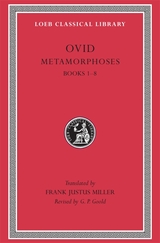 Metamorphoses, Volume I: Books 1–8
Ovid
Harvard University Press The poetry of change.
Ovid (Publius Ovidius Naso, 43 BC–AD 17), born at Sulmo, studied rhetoric and law at Rome. Later he did considerable public service there, and otherwise devoted himself to poetry and to society. Famous at first, he offended the emperor Augustus by his Ars amatoria, and was banished because of this work and some other reason unknown to us, and dwelt in the cold and primitive town of Tomis on the Black Sea. He continued writing poetry, a kindly man, leading a temperate life. He died in exile.
Ovid's main surviving works are the Metamorphoses, a source of inspiration to artists and poets including Chaucer and Shakespeare; the Fasti, a poetic treatment of the Roman year of which Ovid finished only half; the Amores, love poems; the Ars amatoria, not moral but clever and in parts beautiful; Heroides, fictitious love letters by legendary women to absent husbands; and the dismal works written in exile: the Tristia, appeals to persons including his wife and also the emperor; and similar Epistulae ex Ponto. Poetry came naturally to Ovid, who at his best is lively, graphic and lucid.
The Loeb Classical Library edition of Ovid is in six volumes.
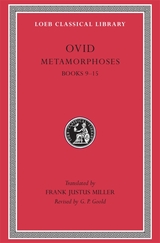 Metamorphoses, Volume II: Books 9–15
Ovid
Harvard University Press The poetry of change.
Ovid (Publius Ovidius Naso, 43 BC–AD 17), born at Sulmo, studied rhetoric and law at Rome. Later he did considerable public service there, and otherwise devoted himself to poetry and to society. Famous at first, he offended the emperor Augustus by his Ars amatoria, and was banished because of this work and some other reason unknown to us, and dwelt in the cold and primitive town of Tomis on the Black Sea. He continued writing poetry, a kindly man, leading a temperate life. He died in exile.
Ovid's main surviving works are the Metamorphoses, a source of inspiration to artists and poets including Chaucer and Shakespeare; the Fasti, a poetic treatment of the Roman year of which Ovid finished only half; the Amores, love poems; the Ars amatoria, not moral but clever and in parts beautiful; Heroides, fictitious love letters by legendary women to absent husbands; and the dismal works written in exile: the Tristia, appeals to persons including his wife and also the emperor; and similar Epistulae ex Ponto. Poetry came naturally to Ovid, who at his best is lively, graphic and lucid.
The Loeb Classical Library edition of Ovid is in six volumes.
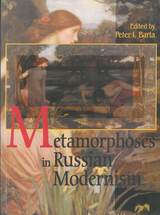 Metamorphosis in Russian Modernism
Peter I. Barta
Central European University Press, 2000 Modern Russia has been shaped by Peter the Great's sudden attempt to transform it into a European country. Since shapeshifting and identity are so closely linked in Russian history, it is hardly surprising that metamorphosis is a prevalent - albeit hitherto neglected - theme in Russian literature. Metamorphoses in Russian Modernism provides the first detailed account of metamorphosis as a Russian theme, structuring principle, and source of artistic identity. Barta examines how the magical transformations depicted in the ancient classics and in the oral epic heritage resonate in Russian literature and film at the fin de siècle and the early decades of the twentieth century - a period of dynamic change in Russian culture. Two hundred years after Peter's forceful westernization and facing its second crucial transformation in 1917, Russia witnessed the decay of classic realism and positivism and the rise of irrational philosophies, psychoanalysis, artistic experimentation, Marxism, as well as the birth of the new genre of film. This in-depth volume examines metamorphosis in the works of prominent representatives of the divided Russian intelligentsia: the Symbolists; the most famous émigré writer, Nabokov; Olesha, the 'fellow traveller' attempting to find his place in the Soviet state; the enthusiastic poet of the Bolshevik movement, Maiakovskii; and finally, Russia's greatest film director, Sergei Eisenstein. The volume directs attention to the fact that Russia itself is a metamorph. The shapeshifter always retains features of previous identities and is sometimes capable of returning into previous forms; whether today's Russia will want to, or be able to do so, remains to be seen. It is futile to attempt to try to understand this civilisation - let alone predict its future - without considering the intellectual, social and emotional reasons why it is not at rest with itself. It is to this end that this volume hopes to make a contribution.
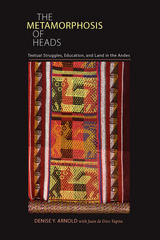 The Metamorphosis of Heads: Textual Struggles, Education, and Land in the Andes
Denise Y. Arnold
University of Pittsburgh Press, 2006
Since the days of the Spanish Conquest, the indigenous populations of Andean Bolivia have struggled to preserve their textile-based writings. This struggle continues today, both in schools and within the larger culture. The Metamorphosis of Heads explores the history and cultural significance of Andean textile writings--weavings and kipus (knotted cords), and their extreme contrasts in form and production from European alphabet-based texts. Denise Arnold examines the subjugation of native texts in favor of European ones through the imposition of homogenized curricula by the Educational Reform Law. As Arnold reveals, this struggle over language and education directly correlates to long-standing conflicts for land ownership and power in the region, since the majority of the more affluent urban population is Spanish speaking, while indigenous languages are spoken primarily among the rural poor. <I>The Metamorphosis of Heads</I> acknowledges the vital importance of contemporary efforts to maintain Andean history and cultural heritage in schools, and shows how indigenous Andean populations have incorporated elements of Western textual practices into their own textual activities.
Based on extensive fieldwork over two decades, and historical, anthropological, and ethnographic research, Denise Arnold assembles an original and richly diverse interdisciplinary study. The textual theory she proposes has wider ramifications for studies of Latin America in general, while recognizing the specifically regional practices of indigenous struggles in the face of nation building and economic globalization.
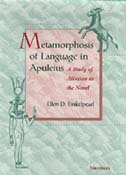 Metamorphosis of Language in Apuleius: A Study of Allusion in the Novel
Ellen D. Finkelpearl
University of Michigan Press, 1998 Ellen D. Finkelpearl's Metamorphosis of Language in Apuleius studies the use of literary allusion by the Roman author Apuleius, in his second century C.E. novel the Metamorphoses, popularly known as The Golden Ass. Apuleius' work is enticing yet frustrating because of its enigmatic mixture of the comic and serious; a young man is transformed into a donkey, but eventually finds salvation with the goddess Isis. Finkelpearl's book represents the first attempt to place Apuleius' allusive practices within a consideration of the development of the ancient novel.
When Apuleius wrote his Metamorphoses, the novel--indeed the very concept of fiction in prose--was new. This study argues that Apuleius' repeated allusions to earlier Latin authors such as Vergil, Ovid, and Seneca represent an exploration on his part of the relationship between the novel and more established genres of the era. Apuleius' struggle with this tradition, Finkelpearl maintains, parallels the protagonist's move from an acceptance of the dominance of traditional forms to a sense of arrival and self- discovery.
An introductory chapter includes general discussion of the theory and practice of allusion. Finkelpearl then revisits the issues of parody in Apuleius. She also includes discussion of Apuleius' use of Vergil's Sinon, the Charite episode in relation to Apuleius' African origins, and the stepmother episode. Finally a new reading of Isis is offered, which emphasizes her associations with writing and matches the multiformity of the goddess with the novel's many voices.
This book will be of interest to scholars of literature and the origins of the novel, multiculturalism, and classical literature.
Ellen D. Finkelpearl is Associate Professor of Classics at Scripps College, Claremont, California.
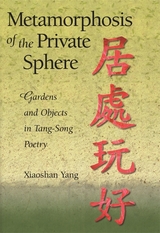 Metamorphosis of the Private Sphere: Gardens and Objects in Tang–Song Poetry
Xiaoshan Yang
Harvard University Press, 2003 The Chinese garden has been explored from a variety of angles. Much has been written about its structural features as well as its cosmological, religious, philosophical, moral, aesthetic, and economic underpinnings. This book deals with the poetic configurations of the private garden in cities from the ninth to the eleventh century in relation to the development of the private sphere in Chinese literati culture. It focuses on the ways in which the new values and rhetoric associated with gardens and the objects found in them helped shape the processes of self-cultivation and self-imaging among the literati, as they searched for alternatives to conventional values at a time when traditional political, moral, and aesthetic norms were increasingly judged inapplicable or inadequate.
The garden was also an artifact and a locus for material culture and social competition. Focusing on a series of anecdotes about private transactions involving objects in gardens, the author dissects the intricate nexus between the exchange of poetry and the poetry of exchange. In tracing the development of the private urban garden through the writings of Bai Juyi, Su Shi, Sima Guang, and their contemporaries, the author argues that this private space figured increasingly as a place of disengagement for those out of political power and hence was increasingly invaded by political forces.
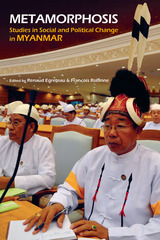 Metamorphosis: Studies in Social and Political Change in Myanmar
Edited by Renaud Egreteau and François Robinne
National University of Singapore Press, 2015 With a young population of more than 52 million, an ambitious roadmap for political reform, and on the cusp of rapid economic development, since 2010 the world’s attention has been drawn to Myanmar or Burma.
But underlying recent political transitions are other wrenching social changes and shocks, a set of transformations less clearly mapped out. Relations between ethnic and religious groups, in the context of Burma’s political model of a state composed of ethnic groups, are a particularly important “unsolved equation”.
The editors use the notion of metamorphosis to look at Myanmar today and tomorrow—a term that accommodates linear change, stubborn persistence and the possibility of dramatic transformation. Divided into four sections, on politics, identity and ethnic relations, social change in fields like education and medicine, and the evolutions of religious institutions, the volume takes a broad view, combining an anthropological approach with views from political scientists and historians. This volume is an essential guide to the political and social challenges ahead for Myanmar.
 Metamorphosis: The Mind in Exile
Harold Skulsky
Harvard University Press, 1981 Fusing the methods of comparative literature, intellectual history, and philosophical analysis, Harold Skulsky explores a motif that has fascinated storytellers since antiquity: the miraculous transformation of a character into a plant, an animal, or a different human being.
The thesis of the study is that the fantasy of metamorphosis challenges the narrator and his audience to confront certain basic anxieties about the human condition: Is the mind reducible to physical properties? What constitutes personhood? How does physical form affect personal identity and continuity of the self?
Testing instances in which these and related perplexities appear in literature, Skulsky systematically and provocatively interprets ten major illustrative texts drawn from diverse epochs and languages, including the works of Homer, Ovid, Apuleius, Marie de France, Dante, Donne, Spenser, Keats, Kafka, and Woolf. Through Skulsky's masterly analysis the victims of metamorphosis in narrative literature--whether werewolf, ass, beetle, swine, or tree--provide a profound insight into the complexities of human experience.
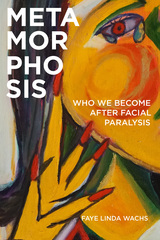 Metamorphosis: Who We Become after Facial Paralysis
Faye Linda Wachs
Rutgers University Press, 2023 Losing her smile to synkinesis after unresolved Bell’s palsy changed how Faye Linda Wachs was seen by others and her internal experience of self. In Metamorphosis, interviewing over one hundred people with acquired facial difference challenged her presumptions about identity, disability, and lived experience. Participants described microaggressions, internalizations, and minimalizations and their impact on identity. Heartbreakingly, synkinesis disrupts the ability to have shared moments. When one experiences spontaneous emotion, wrong nerves trigger misfeel and misperception by others. One is misread by others and receives confusing internal information. Communication of and to the self is irrevocably damaged. Wachs describes the experience as a social disability. People found a host of creative ways to reinvigorate their sense of self and self-expression. Like so many she interviewed, Wachs experiences a process of change and growth as she is challenged to think more deeply about ableism, identity, and who she wants to be.
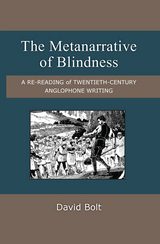 The Metanarrative of Blindness: A Re-reading of Twentieth-Century Anglophone Writing
David Bolt
University of Michigan Press, 2013 Although the theme of blindness occurs frequently in literature, literary criticism has rarely engaged the experiential knowledge of people with visual impairments. The Metanarrative of Blindness counters this trend by bringing to readings of twentieth-century works in English a perspective appreciative of impairment and disability. Author David Bolt examines representations of blindness in more than forty literary works, including writing by Kipling, Joyce, Synge, Orwell, H. G. Wells, Susan Sontag, and Stephen King, shedding light on the deficiencies of these representations and sometimes revealing an uncomfortable resonance with the Anglo-American science of eugenics. What connects these seemingly disparate works is what Bolt calls “the metanarrative of blindness,” a narrative steeped in mythology and with deep roots in Western culture. Bolt examines literary representations of blindness using the analytical tools of disability studies in both the humanities and social sciences. His readings are also broadly appreciative of personal, social, and cultural aspects of disability, with the aim of bringing literary scholars to the growing discipline of disability studies, and vice versa. This interdisciplinary monograph is relevant to people working in literary studies, disability studies, psychology, sociology, applied linguistics, life writing, and cultural studies, as well as those with a general interest in education and representations of blindness.
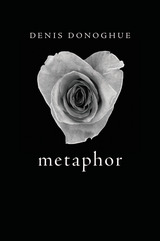 Metaphor
Denis Donoghue
Harvard University Press, 2014 Denis Donoghue turns his attention to the practice of metaphor and to its lesser cousins, simile, metonym, and synecdoche. Metaphor (“a carrying or bearing across”) supposes that an ordinary word could have been used in a statement but hasn’t been. Instead, something else, something unexpected, appears. The point of a metaphor is to enrich the reader’s experience by bringing different associations to mind. The force of a good metaphor is to give something a different life, a new life. The essential character of metaphor, Donoghue says, is prophetic. Metaphors intend to change the world by changing our sense of it.
At the center of Donoghue’s study is the idea that metaphor permits the greatest freedom in the use of language because it exempts language from the local duties of reference and denotation. Metaphors conspire with the mind in its enjoyment of freedom. Metaphor celebrates imaginative life par excellence, from Donoghue’s musings on Aquinas’ Latin hymns, interspersed with autobiographical reflection, to his agile and perceptive readings of Wallace Stevens.
When Donoghue surveys the history of metaphor and resistance to it, going back to Aristotle and forward to George Lakoff, he is a sly, cogent, and persuasive companion. He also addresses the question of whether or not metaphors can ever truly die. Reflected on every page of Metaphor are the accumulated wisdom of decades of reading and a sheer love of language and life.
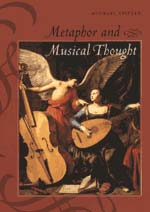 Metaphor and Musical Thought
Michael Spitzer
University of Chicago Press, 2004 "The scholarship of Michael Spitzer's new book is impressive and thorough. The writing is impeccable and the coverage extensive. The book treats the history of the use of metaphor in the field of classical music. It also covers a substantial part of the philosophical literature. The book treats the topic of metaphor in a new and extremely convincing manner."-Lydia Goehr, Columbia University
The experience of music is an abstract and elusive one, enough so that we're often forced to describe it using analogies to other forms and sensations: we say that music moves or rises like a physical form; that it contains the imagery of paintings or the grammar of language. In these and countless other ways, our discussions of music take the form of metaphor, attempting to describe music's abstractions by referencing more concrete and familiar experiences.
Michael Spitzer's Metaphor and Musical Thought uses this process to create a unique and insightful history of our relationship with music—the first ever book-length study of musical metaphor in any language. Treating issues of language, aesthetics, semiotics, and cognition, Spitzer offers an evaluation, a comprehensive history, and an original theory of the ways our cultural values have informed the metaphors we use to address music. And as he brings these discussions to bear on specific works of music and follows them through current debates on how music's meaning might be considered, what emerges is a clear and engaging guide to both the philosophy of musical thought and the history of musical analysis, from the seventeenth century to the present day. Spitzer writes engagingly for students of philosophy and aesthetics, as well as for music theorists and historians.
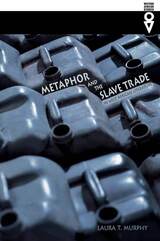 Metaphor and the Slave Trade in West African Literature
Laura T. Murphy
Ohio University Press, 2012 Metaphor and the Slave Trade provides compelling evidence of the hidden but unmistakable traces of the transatlantic slave trade that persist in West African discourse. Through an examination of metaphors that describe the trauma, loss, and suffering associated with the commerce in human lives, this book shows how the horrors of slavery are communicated from generation to generation. Laura T. Murphy’s insightful new readings of canonical West African fiction, autobiography, drama, and poetry explore the relationship between memory and metaphor and emphasize how repressed or otherwise marginalized memories can be transmitted through images, tropes, rumors, and fears. By analyzing the unique codes through which West Africans have represented the slave trade, this work foregrounds African literary contributions to Black Atlantic discourse and draws attention to the archive that metaphor unlocks for scholars of all disciplines and fields of study.
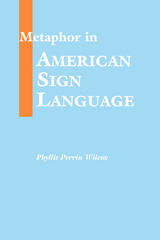 Metaphor in American Sign Language
Phyllis Perrin Wilcox
Gallaudet University Press, 2001 Only recently have linguists ceased to regard metaphors as mere frills on the periphery of language and begun to recognize them as cornerstones of discourse. Phyllis Wilcox takes this innovation one step further in her fascinating study of metaphors in American Sign Language (ASL).
Such an inquiry has long been obscured by, as Wilcox calls it, “the shroud of iconicity.” ASL’s iconic nature once discouraged people from recognizing it as a language; more recently it has served to confuse linguists examining its metaphors. Wilcox, however, presents methods for distinguishing between icon and metaphor, allowing the former to clarify, not cloud, the latter. “If the iconic influence that surrounds metaphor is set aside, the results will be greater understanding, and interpretations that are less opaque.”
Wilcox concludes her study with a close analysis of the ASL poem, “The Dogs,” by Ella Mae Lentz. In presenting Deaf Americans’, Deaf Germans’, and Deaf Italians’ reactions to the poem, Wilcox manages not only to demonstrate the influence of culture upon metaphors, but also to illuminate the sources of sociopolitical division within the American Deaf community. Metaphor in American Sign Language proves an engrossing read for those interested in linguistics and Deaf culture alike.
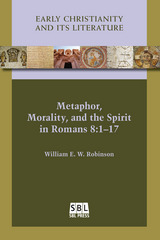 Metaphor, Morality, and the Spirit in Romans 8:1-17
William E. W. Robinson
SBL Press, 2016 Engage compelling arguments that challenge prominent positions in Pauline studies
In this innovative book, William E. W. Robinson takes the reader on a journey through Romans 8:1–17 using Conceptual Metaphor Theory and Conceptual Integration Theory. Robinson delineates the underlying cognitive metaphors, their structure, their function, what they mean, and how Paul’s audiences then and now are able to comprehend their meaning. He examines each metaphor in the light of relevant aspects of the Greco-Roman world and Paul’s Jewish background. Robinson contends that Paul portrays the Spirit as the principal agent in the religious-ethical life of believers. At the same time, his analysis demonstrates that the conceptual metaphors in Romans 8:1–17 convey the integral role of believers in ethical conduct. In the process, he addresses thorny theological issues such as whether Spirit and flesh signal an internal battle within believers or two conflicting ways of life. Finally, Robinson shows how this study is relevant to related Pauline passages and challenges scholars to incorporate these methods into their own investigation of biblical texts.
Features:
- Sustained argument that sheds new light on how Paul communicates with his audiences
- Substantial contribution to current debates about central theological concepts
- Conceptual Metaphor Theory and Conceptual Integration Theory applied to the metaphors in Romans 8:1-17
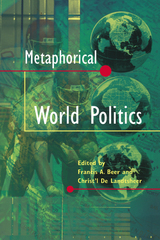 Metaphorical World Politics
Francis A. Beer
Michigan State University Press, 2004 Metaphorical World Politics argues that language and metaphor are important parts of international political reality. Metaphors and world politics have appeared together many times in recent history. The blended space that results is metaphorical world politics, a real- world game for political and scientific actors. This collection picks up the challenge to unravel the game, to examine its rules, to clarify the mixture of images and facts that is so real in politics but so exceptional in science. Scholars have studied metaphor mostly from a linguistic or a literary point of view. This work forces those primarily interested in metaphors to think about applications and implications beyond the text. Others concerned mainly with world politics may consider how metaphors may help to energize and structure international political thought and action.
Scholars have most often studied world politics embedded in so-called "facts." Metaphorical World Politics shows that facts are misleading in their compactness, that facts are often meaningless, that metaphors in contrast are energetic processors of meaning, and that facts in world politics are nothing more than weak emulsions of metaphor. This work outlines the general place of metaphor on the map of politics and highlights the location of specific metaphors on the political terrain.
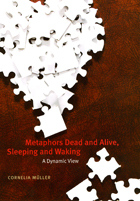 Metaphors Dead and Alive, Sleeping and Waking: A Dynamic View
Cornelia Müller
University of Chicago Press, 2008 Traditional thinking on metaphors has divided them into two camps: dead and alive. Conventional expressions from everyday language are classified as dead, while much rarer novel or poetic metaphors are alive. In the 1980s, new theories on the cognitive processes involved with the use of metaphor challenged these assumptions, but with little empirical support. Drawing on the latest research in linguistics, semiotics, philosophy, and psychology, Cornelia Müller here unveils a new approach that refutes the rigid dead/alive dichotomy, offering in its place a more dynamic model: sleeping and waking.
To build this model, Müller presents an overview of notions of metaphor from the classical period to the present; studies in detail how metaphors function in speech, text, gesture, and images; and examines the way mixed metaphors sometimes make sense and sometimes do not. This analysis leads her to conclude that metaphors may oscillate between various degrees of sleeping and waking as their status changes depending on context and intention. Bridging the gap between conceptual metaphor theory and more traditional linguistic theories, this book is a major advance for the field and will be vital to novices and initiates alike.
Metaphors We Live By
George Lakoff and Mark Johnson
University of Chicago Press, 1981 The now-classic Metaphors We Live By changed our understanding of metaphor and its role in language and the mind. Metaphor, the authors explain, is a fundamental mechanism of mind, one that allows us to use what we know about our physical and social experience to provide understanding of countless other subjects. Because such metaphors structure our most basic understandings of our experience, they are "metaphors we live by"—metaphors that can shape our perceptions and actions without our ever noticing them.
In this updated edition of Lakoff and Johnson's influential book, the authors supply an afterword surveying how their theory of metaphor has developed within the cognitive sciences to become central to the contemporary understanding of how we think and how we express our thoughts in language.
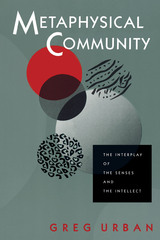 Metaphysical Community: The Interplay of the Senses and the Intellect
By Greg Urban
University of Texas Press, 1996 Winner, Senior Book Prize, American Ethnological Society Starting with the post-structuralist idea that truth systems are lodged in discourse, and that discourse varies from society to society, Greg Urban seeks to discover the nature and extent of that variation. His journey to an Amerindian society in which dreams are more prominent than everyday aspects of the sensible world leads him to radically reformulate one of the main problematics of Western thought: the relationship between our sensations of the world and the understandings we form of them. Metaphysical Community proposes that this dichotomy comes from the interplay between two sides of discourse-its intelligible side as a carrier of meanings, and its sensible side as thing-in-the-world that must be replicated. This insight leads to the heart of the book-the exploration of the uneasy tension that binds experience and understanding, phenomena and noumena. Urban challenges basic assumptions that underlie social and cultural anthropology and much of the social sciences and humanities. His provocative insights will be of interest to all those concerned with anthropology, cultural studies, literary criticism, the sociology and politics of culture, and philosophy.
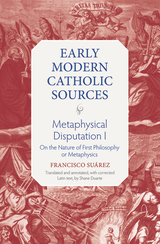 Metaphysical Disputation I: On the Nature of First Philosophy or Metaphysics
Francisco Suarez
Catholic University of America Press, 2021 Francisco Suárez (1548-1617) was one of the most important philosophers and theologians of Early Modern Scholasticism. Although Suárez spent most of his academic career as a professor of theology, he is better known today for his Metaphysical Disputations (Salamanca, 1597). The present volume contains a facing-page English translation of Metaphysical Disputation I, which is introductory and devoted to the nature of metaphysics itself. In it, Suárez first specifies this science’s object and nature (Sections 1 and 2) and then discusses its unity (Section 3), its end, utility and functions (Section 4), its status as the most perfect natural science and true wisdom (Section 5), and finally the thesis that it is the science most of all desired by means of a natural appetite (Section 6). Those interested in late scholastic conceptions of metaphysics and their influence on the better known metaphysical systems of the seventeenth century – e.g., Descartes’s – will find the volume especially useful. The Latin text contained in this volume introduces a significant number of corrections to the text of the Vivès edition, the one standardly used by scholars of Suárez, and thus more faithfully reproduces the text of the first edition. The volume also contains a lengthy introduction that provides a detailed survey of the disputation’s principal claims and arguments.
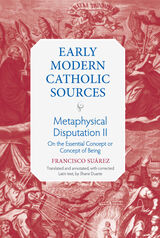 Metaphysical Disputation II: On the Essential Concept or Concept of Being
Francisco Suarez
Catholic University of America Press, 2022 Francisco Suárez (1548-1617) was one of the most important philosophers and theologians of early modern Aristotelian scholasticism. Although Suárez spent most of his academic career as a professor of theology, he is better known today for his Metaphysical Disputations (Salamanca, 1597). The present volume contains a facing-page English translation of Metaphysical Disputation II, which is devoted to the nature of real being, the subject of metaphysics. In it, Suárez is especially concerned, first, to argue there is a single nature of being common to all real beings, and second, to show what this nature consists in. The Latin text contained in this volume introduces a significant number of corrections to the text of the Vivès edition, the one standardly used by scholars of Suárez, and thus more faithfully reproduces the text of the first edition. The volume also contains a lengthy introduction that provides a detailed survey of the disputation’s principal claims and arguments.
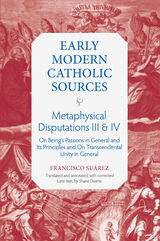 Metaphysical Disputations III and IV: On Being's Passions in General and Its Principles and On Transcendental Unity in General
Francisco Suarez
Catholic University of America Press, 2023 Francisco Suárez (1548-1617) was one of the most important philosophers and theologians of Early Modern Scholasticism. Although Suárez spent most of his academic career as a professor of theology, he is better known today for his Metaphysical Disputations (Salamanca, 1597). The present volume contains a facing-page English translation of Metaphysical Disputations III & IV. Metaphysical Disputation III offers a general treatment of the properties of being as such, while Metaphysical Disputation IV deals with one of these properties in particular, transcendental unity. The Latin text contained in this volume introduces a significant number of corrections to the text of the Vivès edition, the one standardly used by scholars of Suárez, and thus more faithfully reproduces the text of the first edition. The volume also contains a lengthy introduction that provides a detailed survey of the disputations’ principal claims and arguments.
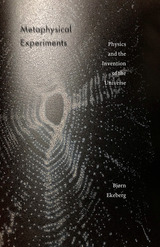 Metaphysical Experiments: Physics and the Invention of the Universe
Bjørn Ekeberg
University of Minnesota Press, 2019 An engaging critique of the science and metaphysics behind our understanding of the universe
The James Webb Space Telescope, when launched in 2021, will be the premier orbital observatory, capable of studying every phase of the history of the universe, from the afterglow of the Big Bang to the formation of our solar system. Examining the theoretical basis for key experiments that have made this latest venture in astrophysics possible, Bjørn Ekeberg reveals that scientific cosmology actually operates in a twilight zone between the physical and metaphysical. Metaphysical Experiments explains how our current framework for understanding the universe, the Big Bang theory, is more determined by a deep faith in mathematical universality than empirical observation. Ekeberg draws on philosophical insights by Spinoza, Bergson, Heidegger, and Arendt; on the critical perspectives of Latour, Stengers, and Serres; and on cutting-edge physics research at the Large Hadron Collider, to show how the universe of modern physics was invented to reconcile a Christian metaphysical premise with a claim to the theoretical unification of nature. By focusing on the nonmathematical assumptions underlying some of the most significant events in modern science, Metaphysical Experiments offers a critical history of contemporary physics that demystifies such concepts as the universe, particles, singularity, gravity, blackbody radiation, the speed of light, wave/particle duality, natural constants, black holes, dark matter, and dark energy. Ekeberg’s incisive reading of the metaphysical underpinnings of scientific cosmology offers an innovative account of how we understand our place in the universe.
The Metaphysical Foundations of Love: Aquinas on Participation, Unity, and Union
Anthony T. Flood
Catholic University of America Press, 2018 The Metaphysical Foundations of Love: Aquinas on Participation, Unity, and Union offers a systematic treatment of St. Thomas Aquinas’s account of the metaphysical relations of unity-to-union and unity-to-participation in God as the key structuring elements to the nature of love and friendship. In general, Aquinas identifies love as the source and summit of the life of each human being. Everything in the created realm issues forth from God’s creative love, and the ultimate end of all human persons is the greatest possible union with God. Aquinas contends that the love of friendship allows for the greatest union between two persons; thus, the greatest union with God takes the form of friendship with him.
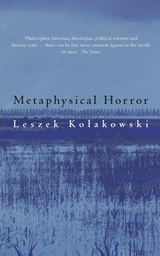 Metaphysical Horror
Leszek Kolakowski
University of Chicago Press, 2001 For over a century, philosophers have argued that philosophy is impossible or useless, or both. Although the basic notion dates back to the days of Socrates, there is still heated disagreement about the nature of truth, reality, knowledge, the good, and God. This may make little practical difference to our lives, but it leaves us with a feeling of radical uncertainty, a feeling described by Kolakowski as "metaphysical horror." "The horror is this," he says, "if nothing truly exists except the Absolute, the Absolute is nothing; if nothing truly exists except myself, I am nothing." The aim of this book, for Kolakowski, is finding a way out of this seeming dead end.
In a trenchant analysis that serves as an introduction to nearly all of Western philosophy, Kolakowski confronts these dilemmas head on through examinations of several prominent philosophers including Descartes, Spinoza, Husserl, and many of the Neo-Platonists. He finds that philosophy may not provide definitive answers to the fundamental questions, yet the quest itself transforms our lives. It may undermine most of our certainties, yet it still leaves room for our spiritual yearnings and religious beliefs.
The final sentence of the book captures the hopefulness that has survived the horror of nothingness when Kolakowski asks: "Is it not reasonable to suspect that if existence were pointless and the universe devoid of meaning, we would never have achieved not only the ability to imagine otherwise, but even the ability to entertain this very thought—to wit, that existence is pointless and the universe devoid of meaning?" The answer, of course, is clear. Now it is up to readers to take up the challenge of his arguments.
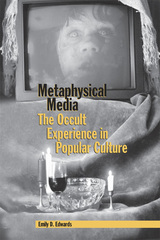 Metaphysical Media: The Occult Experience in Popular Culture
Emily D. Edwards
Southern Illinois University Press, 2005
Considered sinister by Western religious traditions and bizarre in mainstream America, supernatural beliefs and the rituals of occult traditions are often publicly disparaged. But they are paradoxically embraced and exposed by popular culture, in television shows such as Bewitched and in movies from The Wizard of Oz to The Craft, according to Emily D. Edwards. Metaphysical Media: The Occult Experience in Popular Culture is an in-depth discussion of the media’ s presentation of a wide spectrum of the occult that also serves as a comprehensive sourcebook of movies and television programs that deal with supernatural characters and themes.
Metaphysical Media focuses on the blurred definitions of topics associated with the occult as they are presented in popular culture to show moving-image media as devices that help structure an understanding of the supernatural world. Edwards examines what media treatment of supernatural subjects and the very characteristics of the media themselves reveal about the persistence of the occult. She maintains that popular art has always had a close association with the paranormal or supernatural— sometimes in illustration of an ideology, sometimes in ridicule of it, and sometimes as invocation itself.
Beginning with an overview of the role of the media in contemporary society and in its use of the occult, Metaphysical Media looks at the properties of media technology that extend human senses beyond biological boundaries. Edwards then discusses specific media treatment of topics related to the occult, including witchcraft, atavism, reincarnation, out-of-body experiences, and lycanthropy. She outlines the interplay of media and folklore regarding taboos about the handling of the dead and investigates media stories about creatures that cross the boundaries between human, beast, and god.
Metaphysical Themes in Thomas Aquinas
John F. Wippel
Catholic University of America Press, 1995 In this volume, John Wippel has collected a number of his essays dealing with Aquinas's metaphysical thought. The volume begins with a presentation and critical evaluation of certain twentieth-century attempts to describe the philosophical thought of Thomas Aquinas as a "Christian philosophy."
Metaphysical Themes in Thomas Aquinas II
John F. Wippel
Catholic University of America Press, 2007 This volume contains eleven articles and book chapters written by John Wippel since the publication of his Metaphysical Themes in Thomas Aquinas in 1984.
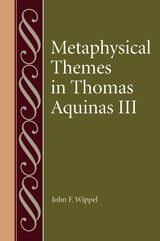 Metaphysical Themes in Thomas Aquinas III
John F. Wippel
Catholic University of America Press, 2020 Metaphysical Themes in Thomas Aquinas III is Msgr. John Wippel’s third volume dedicated to the metaphysical thought of Thomas Aquinas. After an introduction, this volume of collected essays begins with Wippel’s interpretation of the discovery of the subject of metaphysics by a special kind of judgment (“separation”). In subsequent chapters, Wippel turns to the relationship between faith and reason, exploring what are known as the preambles of faith. This is followed by two chapters on the important contributions by Cornelio Fabro on Aquinas’s distinction between essence and esse and on participation. The volume continues with articles on Aquinas’s view of creation as a preamble of faith, Aquinas’s much-disputed defense of unicity of substantial form in creatures, his account of the separated soul’s natural knowledge, and Aquinas’s understanding of evil in his De Malo 1. The volume concludes with an article comparing Bonaventure, Aquinas, and Godfrey of Fontaines on the metaphysical composition of angelic beings.
Most of these issues were disputed during Aquinas’s time by some of his contemporaries, and the proper understanding of each continues to be debated by various students of his thought today. Wippel’s purpose, therefore, is to help clarify our understanding of Aquinas’s thought on each of these topics, a task that requires the careful analysis of primary sources and of secondary literature and attention to the relative chronology of his writing.
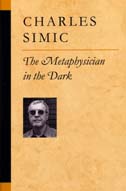 The Metaphysician in the Dark
Charles Simic
University of Michigan Press, 2003 Charles Simic's quicksilver imagination, his masterly way with words, and his unalloyed love of life and language alike inform every page of this wonderfully wide-ranging collection. Again and again, Simic takes up a subject and turns it this way and that, showing us what we haven't noticed before, inviting us to share an infectious delight that turns everything, in the end, into poetry. It's a gift that has won him a coveted MacArthur Fellowship, among many honors, but he wears his magic lightly.
Often, he addresses poetry itself. Among the pieces here are appreciations of Mark Strand, James Merrill, John Ashbery, and James Tate, each evaluated with a keen eye tempered by a generous spirit. Other essays discuss Joseph Brodsky, Czeslaw Milosz, and Vasko Popa; to these writers he brings the understanding available only to those who can read them in the original. In considering Brodsky's translations, for instance, he offers insights regarding not only the poet himself but the very nature of language. Elsewhere, he peers into poetry's past and its future: as a vessel of memory, a witness to history, and a mirror of human experience.
But perhaps the greatest pleasures afforded by The Metaphysician in the Dark, as he styles himself with a beguiling mix of modesty and irony, appear when Simic goes further afield. His look at the deadpan comedy of Buster Keaton is as revealing of the author as of the actor and his craft; his perusal of a Heironymous Bosch altarpiece captures both the painter's sense of apocalypse and a riotous joy in the piling of detail upon detail; his review of a book on Joseph Cornell examines how obsession becomes art. He is fluently familiar with subjects as diverse as Saul Bellow's novels and Aberlardo Morell's extraordinary camera obscura photographs. Yet when he takes the gloves off, as in two essays on the Serbia of Slobodan Milosevic, his outrage is as forceful as his pride is strong in his own Serbian heritage.
Each of the two dozen essays here reflects a sophistication irresistible in its simplicity; taken together, they display a questing intelligence and a panorama of life and art.
Charles Simic is an acclaimed poet, novelist, essayist and teacher. Winner of a MacArthur Fellowship and a Pulitzer Prize, he is the author of more than twenty volumes of poetry and six books of prose, as well as numerous translations. He is Distinguished University Professor of English at the University of New Hampshire, where he has taught since 1973.
Metaphysics
Aristotle
University of Michigan Press, 1952 Aristotle's great work translated into English with an index giving Greek, Latin, and English forms of key terms
Metaphysics
Bruce Aune
University of Minnesota Press, 1985 Comprehensive introductory survey of the key concepts and problems in traditional and contemporary metaphysics. A comprehensive introductory study of the key concepts and problems in traditional and contemporary metaphysics. Aune presents and defends a point of view that is naturalistic, nominalistic and pragmatic-an approach that has the overall advantage of providing a coherent, structured view of the topics he discusses.
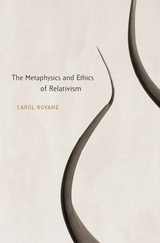 The Metaphysics and Ethics of Relativism
Carol Rovane
Harvard University Press, 2014 Relativism is a hotly contested doctrine among philosophers, some of whom regard it as neither true nor false but simply incoherent. As Carol Rovane demonstrates in this analytical tour-de-force, the way to defend relativism is not initially by establishing its truth but by clarifying its content. The Metaphysics and Ethics of Relativism elaborates a doctrine of relativism that has a consistent logical, metaphysical, and practical significance. Relativism is worth debating, Rovane contends, because it bears directly on the moral choices we make in our lives.
Three intuitive conceptions of relativism have been influential in philosophical discourse. These include the idea that certain unavoidable disagreements are irresolvable, leading to the conclusion that "both sides are right," and the idea that truth is always relative to context. But the most compelling, Rovane maintains, is the "alternatives intuition." Alternatives are truths that cannot be embraced together because they are not universal. Something other than logical contradiction excludes them. When this is so, logical relations no longer hold among all truth-value-bearers. Some truths will be irreconcilable between individuals even though they are valid in themselves.
The practical consequence is that some forms of interpersonal engagement are confined within definite boundaries, and one has no choice but to view what lies beyond those boundaries with what Rovane calls "epistemic indifference." In a very real sense, some people inhabit different worlds--true in themselves, but closed off to belief from those who hold irreducibly incompatible truths.
Metaphysics and Explanation
W. H. Capitan
University of Pittsburgh Press, 1966 This volume offers an unusual variety of topics presented during the fifth annual Oberlin Colloquium in Philosophy. Essays topics include: a dispute of the standard deductivist account of scientific testability; two definitions of “nonsense” that are closely related and correlate to science's concern with truth and philosophy's concern with concepts; contesting the causes of voluntary actions purported in Hart and Honoré's Causation and the Law; distinguishing two kinds of metaphysical tasks-—taxonomic and evaluative; and discussions of “what a thing is” in terms of its qualities and particulars and the distinction between numerical and conceptual differences, universals and individuation.
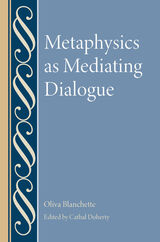 Metaphysics as Mediating Dialogue
Olivia Blanchette
Catholic University of America Press, 2023 Metaphysics is not often spoken of as a venue for dialogue about anything, let alone culture or religion, which are more readily associated with phenomenology or hermeneutics in contemporary thinking. This collection of essays, however, by the late Boston College philosopher Oliva Blanchette, maintains the absolute necessity of metaphysics as a prerequisite for examining any particular ‘realm of being,’ in all areas of human inquiry, from the particular sciences to historical cultures and religions. Blanchette proposes metaphysics as a fundamental and necessary level of intelligence presupposed in any exercise of judgment, discourse, or dialogue, among rational beings. At the same time, he defends the idea that dialogue is the first and most fundamental form in which such reasoning takes place in human experience, on a radically intersubjective level through language.
Metaphysics is not an abstraction removed from human experience. Rather, it is a science in its own right defining itself in relation to ‘being as being’, its subject matter, as it depends on all the particular sciences and bodies of knowledge. Firmly standing on the ground of human experience, and on the human person as primary analogate of being, it opens up an entire realm of questioning that the particular sciences and bodies of knowledge, operating in functional separation, cannot pose on their own, especially when they take, in a reductionist fashion, their own object to be the prime analogate.
Metaphysics, in fact, insinuates itself into each and every particular science in exploring its own subject matter of ‘being as being’ in the analogical sense, advancing to more and more complex stages of analogy through dialogue among different spirits and cultures, and reaching its terminus in the transcendent aspect of spirit and religion. In this sense, metaphysics has much to say to theologians: without metaphysics, theology reduces to mere superstition.
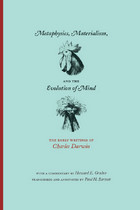 Metaphysics, Materialism, and the Evolution of Mind: The Early Writings of Charles Darwin
Charles Darwin
University of Chicago Press, 1980 First published in 1974 as a companion volume to Darwin on Man by Howard E. Gruber, Paul Barrett’s transcriptions of Darwin’s M and N notebooks served to shed new light on the evolutionist’s methods and motivation. According to Stephen Jay Gould in the New York Times Book Review, “Darwin kept [these notebooks] primarily in 1838, when he was 29 years old. In them, he recorded his early conviction of evolutionary continuity between humans and all other animals. . . . These notebooks display all the features of humanistic intellect that his detractors denied. We find erudition in his comments on Plato, Locke, Hume, Adam Smith, Whewell, Burke, Montaigne, Lessing and Spencer. . . . We appreciate an artistic bent in his delight with nature and her prophet Wordsworth. . . . We grasp the breadth of his bold attempt to clothe all human thought and behaviour in a new evolutionary garb. . . . Charles Darwin was reconstructing the world and he knew exactly what he was doing.”
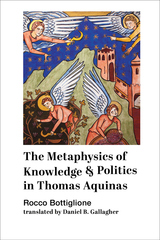 The Metaphysics of Knowledge and Politics in Thomas Aquinas
Rocco Buttiglione
St. Augustine's Press, 2020 Metafisica della Conoscenza e Politica in S. Tommaso d’Aquino was originally published in Bologna in 1985 by the Centro Studi Europa Orientale. This English translation has been prepared with the explicit permission and encouragement of Buttiglione. The work grew from a series of lectures Buttiglione gave on the relationship between metaphysics, knowledge, and politics based on a critical reading of Thomas Aquinas’s Commentary on Aristotle’s Politics and other relevant texts. His aim was to advance Thomistic thinking by incorporating the insights of modern philosophy on subjectivity and relationality.
In addition to its primary audience of philosophers, theologians, and political theorists, the book surprisingly enjoyed a wide general readership in Italy at the time of its publication. It represented an exciting attempt to harmonize medieval philosophy and the insights of personalism that had already had a deep impact on European intellectual life. Buttiglione was able to describe this attempt in a way accessible to a general readership, and in a way that confronted the political challenges Italy had been confronting for the last forty years.
Now, thirty-five years after the book’s initial publication, the conclusions Buttiglione draws from reading Thomas Aquinas’s commentary on Aristotle’s Politics––and the connections he makes between philosophy, theology, and political theory––are more relevant than ever. He argues that the traditional definition of “person” as rationalis naturae individua substantia––an individual substance or substrate (hypokeimenon) of a rational nature––“lacks that certain element that makes Augustine’s approach to personhood so appealing.” Hence Aquinas’s definition “is left wanting since it fails to elaborate on the crucial aspect of interpersonal relationship.”
The ingenuous way in which Buttiglione enlivens Thomistic political thinking with personalist philosophy helps to explain not only why free societies are more stable, tolerant, and respectful of human rights than totalitarian states, but theocratic ones as well. Only by raising the interpersonal aspects of political society to an ontological level—indeed, only by affirming and esteeming the self-transcendence of the human person as evidenced through ontological analysis—do the personal relationships that root and enliven the human person also lead to a realistic, dynamic, and convincing vision of the person’s real existence.
Buttiglione was startlingly prescient of the problems we confront at the beginning of the third millennium. This book will spark new discussions as it explains the importance of both the medieval tradition and twentieth-century personalism. The book also draws on a wide range of secondary sources unavailable to English readers that I and will have the unique ability to introduce readers to the “Italian” way of relating speculative and political philosophy in a relatively slim volume.
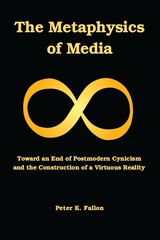 The Metaphysics of Media: Toward an End of Postmodern Cynicism and the Construction of a Virtuous Reality
Peter K. Fallon
University of Scranton Press, 2009 In The Metaphysics of Media, award-winning media critic Peter K. Fallon tackles the complicated question of how a succession of dominant forms of media have supported—and even to some extent created—different conceptions of reality. To do so, he starts with the basics: a critical discussion of the very idea of objective reality and the various postmodern responses that have tended to dominate recent philosophical approaches to the subject. From there, he embarks on a survey of the evolution of communication through four major eras: orality; literacy; print; and electricity.
Within each era, Fallon argues, the dominant form of media supported particular ways of understanding the world, from the ascendance of reason that followed the development of alphabets to the obliteration of space and time that we associate with electronic communications. Fallon concludes with a hard look at the mass ignorance that prevails today despite (or perhaps because of) the sea of information with which contemporary life is surrounded.
A stirring, philosophically rich investigation, The Metaphysics of Media offers not only a clear picture of where our society has been but also a road map to a more engaged, informed, and fully human future.
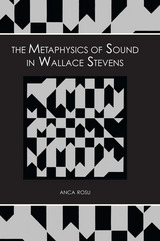 The Metaphysics of Sound in Wallace Stevens
Anca Rosu
University of Alabama Press, 1995 Where sound speaks louder than meaning—Stevens’s poetry as a metaphysical echo. Wallace Stevens dedicated his poetry to challenging traditional notions about reality, truth, knowledge, and the role of language as a means of representation. Rosu demonstrates that Stevens's experimentation with sound is not only essential to his poetics but also profoundly linked to the pragmatist ideas that informed his way of thinking about language. Her readings of Stevens's poems focus on revealing the dynamic through which meaning emerges in language patterns—a dynamic she calls "images of sound." Rosu argues that the formal aspects of poetry are deeply ingrained in cultural realities and are, in fact, generated by their context. The sound pattern pervading Stevens's poems at once addresses and violates the reader's assumptions about the functioning of language and, along with them, ideas about reality, knowledge, and subjectivity. Sound is thus the starting point of an argument concerned with Stevens's epistemology and poetics—the way his poems insist on a movement past or through a normal poetic representation of the world to gesture toward a reality that lies outside or beyond systems of representation. The relationship between sound and meaning isolated and analyzed in The Metaphysics of Sound in Wallace Stevens is firmly situated among critical debates concerning the poet's aesthetic and philosophical convictions. Rosu claims that Stevens's poetry is not ultimately about the powerlessness of language, nor is it a deconstructive enterprise of destabilizing culturally consecrated truths; rather it achieves meaning most frequently through patterns of sound. Sound helps Stevens make a deeply philosophical point in a language unavailable to philosophers.
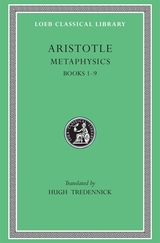 Metaphysics, Volume I: Books 1–9
Aristotle
Harvard University Press First things.
Aristotle, great Greek philosopher, researcher, reasoner, and writer, born at Stagirus in 384 BC, was the son of a physician. He studied under Plato at Athens and taught there (367–347); subsequently he spent three years at the court of a former pupil in Asia Minor. After some time at Mitylene, in 343–342 he was appointed by King Philip of Macedon to be tutor of his teen-aged son Alexander. After Philip’s death in 336, Aristotle became head of his own school (of “Peripatetics”), the Lyceum at Athens. Because of anti-Macedonian feeling there after Alexander’s death in 323, he withdrew to Chalcis in Euboea, where he died in 322.
Nearly all the works Aristotle prepared for publication are lost; the priceless ones extant are lecture-materials, notes, and memoranda (some are spurious). They can be categorized as follows:
I Practical: Nicomachean Ethics; Great Ethics (Magna Moralia); Eudemian Ethics; Politics; Economics (on the good of the family); On Virtues and Vices.
II Logical: Categories; Analytics (Prior and Posterior); Interpretation; Refutations used by Sophists; Topica.
III Physical: Twenty-six works (some suspect) including astronomy, generation and destruction, the senses, memory, sleep, dreams, life, facts about animals, etc.
IV Metaphysics: on being as being.
V Art: Rhetoric and Poetics.
VI Other works including the Constitution of Athens; more works also of doubtful authorship.
VII Fragments of various works such as dialogues on philosophy and literature; and of treatises on rhetoric, politics, and metaphysics.
The Loeb Classical Library edition of Aristotle is in twenty-three volumes.
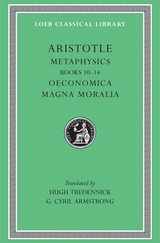 Metaphysics, Volume II: Books 10–14. Oeconomica. Magna Moralia
Aristotle
Harvard University Press First things.
Aristotle, great Greek philosopher, researcher, reasoner, and writer, born at Stagirus in 384 BC, was the son of a physician. He studied under Plato at Athens and taught there (367–347); subsequently he spent three years at the court of a former pupil in Asia Minor. After some time at Mitylene, in 343–342 he was appointed by King Philip of Macedon to be tutor of his teen-aged son Alexander. After Philip’s death in 336, Aristotle became head of his own school (of “Peripatetics”), the Lyceum at Athens. Because of anti-Macedonian feeling there after Alexander’s death in 323, he withdrew to Chalcis in Euboea, where he died in 322.
Nearly all the works Aristotle prepared for publication are lost; the priceless ones extant are lecture-materials, notes, and memoranda (some are spurious). They can be categorized as follows:
I Practical: Nicomachean Ethics; Great Ethics (Magna Moralia); Eudemian Ethics; Politics; Economics (on the good of the family); On Virtues and Vices.
II Logical: Categories; Analytics (Prior and Posterior); Interpretation; Refutations used by Sophists; Topica.
III Physical: Twenty-six works (some suspect) including astronomy, generation and destruction, the senses, memory, sleep, dreams, life, facts about animals, etc.
IV Metaphysics: on being as being.
V Art: Rhetoric and Poetics.
VI Other works including the Constitution of Athens; more works also of doubtful authorship.
VII Fragments of various works such as dialogues on philosophy and literature; and of treatises on rhetoric, politics, and metaphysics.
The Loeb Classical Library edition of Aristotle is in twenty-three volumes.
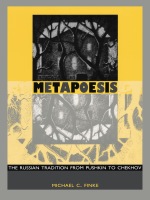 Metapoesis: The Russian Tradition from Pushkin to Chekhov
Michael C. Finke
Duke University Press, 1995 Readers have been schooled to see nineteenth-century Russian literature as the summit of social and psychological realism. But in the work of writers from Pushkin to Chekhov, Michael C. Finke discloses a pervasive self-referentiality, a running commentary on the literary conventions these texts seem so wholly to embody. Metapoesis examines how—and more importantly, why—a series of major Russian authors spanning the nineteenth century inscribed commentary on their own poetics into their works of drama, narrative poetry, and fiction. As he explores the process of metapoesis in these works, Finke reveals its communicative function in its time and its interpretive value in our own.
Jakobsonian poetics provides the framework for this approach, though Finke also draws freely upon a number of contemporary literary theorists. After elucidating the meaning of metapoesis in works by Pushkin, Gogol, and Chernyshevsky, he reveals its covert functioning in such masterpieces of realism as Dostoevsky’s The Idiot, Tolstoy’s Anna Karenina, and Chekhov’s "The Steppe." The result is a new interpretation and deeper understanding of these particular works, which in turn reorient our understanding of linguistic and literary "codes" and of the Russian literary tradition itself.
Of special interest to scholars of Russian literature, Metapoesis will also appeal to a broad range of readers and students of comparative literature, literary theory, and poetics.
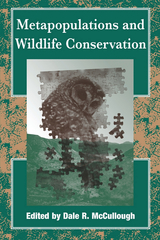 Metapopulations and Wildlife Conservation
Edited by Dale R. McCullough
Island Press, 1996 Development of rural landscapes is converting once-vast expanses of open space into pockets of habitat where wildlife populations exist in isolation from other members of their species. The central concept of metapopulation dynamics -- that a constellation of partially isolated patches can yield overall stability to a system that is chaotic at the level of the individual patch -- offers an important new way of thinking about the conservation and management of populations dispersed among small habitat fragments. This approach is proving to be a rich resource for biologists hoping to arrest the current catastrophic loss of biodiversity. An understanding of metapopulation theory and analysis is critical to the modern practice of wildlife conservation and management. This volume provides a comprehensive overview of the subject, addressing the needs of an applied professional audience for comprehensible information to integrate into their practices. Leading conservation biologists, ecologists, wildlife managers, and other experts consider the emergence and development of metapopulation theory and explore its applicability and usefulness to real-world conservation programs. Introductory chapters provide background information on basic concepts such as models, genetics, landscape configuraton, and edges and corridors. Subsequent chapters present detailed methods of analyzing metapopulation structure. Case studies of an array of vertebrate species, including the Swedish pool frog, the northern spotted owl, Stephens' kangaroo rat, Florida scrub jay, Mediterranean monk seal, Steller sea lion, tule elk, and others, illustrate nuances of metapopulation theory analysis and its practical applications. Contributors describe what metapopulation approaches bring to wildlife conservation and management, present models of how metapopulation thinking has been applied in specific situations, and suggest the analysis required in given cases. Metapopulations and Wildlife Conservation is essential reading for anyone working in the field of wildlife conservation and managment.
Metaracial: Hegel, Antiblackness, and Political Identity
Rei Terada
University of Chicago Press, 2023 A formidable critical project on the limits of antiracist philosophy.
Exploring anxieties raised by Atlantic slavery in radical enlightenment literature concerned about political unfreedom in Europe, Metaracial argues that Hegel's philosophy assuages these anxieties for the left. Interpreting Hegel beside Rousseau, Kant, Mary Shelley, and Marx, Terada traces Hegel's transposition of racial hierarchy into a hierarchy of stances toward reality. By doing so, she argues, Hegel is simultaneously antiracist and antiblack. In dialogue with Black Studies, psychoanalysis, and critical theory, Metaracial offers a genealogy of the limits of antiracism.
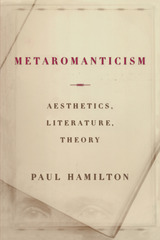 Metaromanticism: Aesthetics, Literature, Theory
Paul Hamilton
University of Chicago Press, 2003 This bracing study redefines romanticism in terms of its philosophical habits of self-consciousness. According to Paul Hamilton, metaromanticism, or the ways in which writers of the romantic period generalized their own practices, was fundamentally characteristic of the romantic project itself.
Through a close look at the aesthetics of Friedrich Schiller and Jean-Jacques Rousseau, and key works by Samuel Taylor Coleridge, Percy and Mary Shelley, John Keats, Sir Walter Scott, Jane Austen, and many others, Hamilton shows how the romantic movement's struggle with its own tenets was not an effort to seek an alternative way of thought, but instead a way of becoming what it already was. And yet, as he reveals, the romanticists were still not content with their own self-consciousness. Pushed to the limit, such contemplation either manifested itself as self-disgust or found aesthetic ideas regenerated in discourses outside of aesthetics altogether.
Metasurface Electromagnetics: The Cagniard-DeHoop time-domain approach
Martin Štumpf
The Institution of Engineering and Technology, 2022 The book is entirely dedicated to the exploration of time-domain electromagnetic fields in the presence of thin, high contrast sheets, with an emphasis on metasurfaces combining magnetic and dielectric properties.
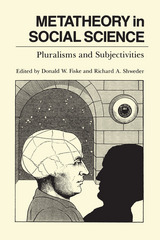 Metatheory in Social Science: Pluralisms and Subjectivities
Edited by Donald W. Fiske and Richard A. Shweder
University of Chicago Press, 1986 What is the nature of the social sciences? What kinds of knowledge can they—and should they—hope to create? Are objective viewpoints possible and can universal laws be discovered? Questions like these have been asked with increasing urgency in recent years, as some philosophers and researchers have perceived a "crisis" in the social sciences. Metatheory in Social Science offers many provocative arguments and analyses of basic conceptual frameworks for the study of human behavior. These are offered primarily by practicing researchers and are related to problems in disciplines as diverse as sociology, psychology, psychiatry, anthropology, and philosophy of science.
While various points of view are expressed in these nineteen essays, they have in common several themes, including the comparison of social and natural science, the role of knowledge in meeting the demands of society and its pressing problems, and the nature and role of subjectivity in science. Some authors hold that subjectivity cannot be studied scientifically; others argue that it can and must be if progress in knowledge is to be made. The essays demonstrate the philosophical pluralism they discuss and give a wide range of alternative positions on the future of the social and behavioral sciences in a postpositivist intellectual world.
 Meta-Tuning Justice: Game Design and Black Youth Agency
Laquana Cooke
University of Massachusetts Press, 2026 Exploring how Black youth are reshaping game design to dismantle stereotypes and spark social change
In the early 2000s, digital gaming rose to cultural and economic prominence. Communities of color, however, and especially Black youth, were largely excluded from gaming culture. The rare Black character in games tended to reinforce stereotypes, while racial bias was often surreptitiously embedded in game design platforms—what decolonial scholars call “whitestream” computing. Progressive game design education initiatives and new technologies have recently begun to dismantle these barriers. Yet, because biases remain, historically excluded young people still need to actively reconfigure these digital spaces to fully develop and convey their own perspectives.
In Meta-Tuning Justice, digital rhetoric scholar Laquana Cooke explores how Black youth express cultural identity and challenge dominant narratives through innovative game design. Cooke introduces the Transformative Constructionist Learning (TCL) paradigm and its core theory of “meta-tuning”—the idea that students are better able to adjust to new challenges through trial-and-error and experimentation in educational environments that correspondingly adjust to their evolving learning needs. In contrast to traditional education practices, which assume the neutrality of technology, Cooke approaches it as a tool for social transformation. Drawing on the TCL paradigm, she explores how the unique cultural algorithms and expressions (like popping and locking dance forms) that inform the programming and designs of Black youth represent a powerful form of resistance and creation.
Through rich ethnographic case studies across multiple educational settings, and with gaming as its experimental center, this book presents a compelling vision of how TCL and meta-tuning can help make technologies more equitable. Cooke’s innovative study offers insights crucial to scholars and practitioners in game studies, Science and Technology Studies, STEM education, and racial equity in digital learning.
 Meta-Tuning Justice: Game Design and Black Youth Agency
Laquana Cooke
University of Massachusetts Press, 2026 Exploring how Black youth are reshaping game design to dismantle stereotypes and spark social change
In the early 2000s, digital gaming rose to cultural and economic prominence. Communities of color, however, and especially Black youth, were largely excluded from gaming culture. The rare Black character in games tended to reinforce stereotypes, while racial bias was often surreptitiously embedded in game design platforms—what decolonial scholars call “whitestream” computing. Progressive game design education initiatives and new technologies have recently begun to dismantle these barriers. Yet, because biases remain, historically excluded young people still need to actively reconfigure these digital spaces to fully develop and convey their own perspectives.
In Meta-Tuning Justice, digital rhetoric scholar Laquana Cooke explores how Black youth express cultural identity and challenge dominant narratives through innovative game design. Cooke introduces the Transformative Constructionist Learning (TCL) paradigm and its core theory of “meta-tuning”—the idea that students are better able to adjust to new challenges through trial-and-error and experimentation in educational environments that correspondingly adjust to their evolving learning needs. In contrast to traditional education practices, which assume the neutrality of technology, Cooke approaches it as a tool for social transformation. Drawing on the TCL paradigm, she explores how the unique cultural algorithms and expressions (like popping and locking dance forms) that inform the programming and designs of Black youth represent a powerful form of resistance and creation.
Through rich ethnographic case studies across multiple educational settings, and with gaming as its experimental center, this book presents a compelling vision of how TCL and meta-tuning can help make technologies more equitable. Cooke’s innovative study offers insights crucial to scholars and practitioners in game studies, Science and Technology Studies, STEM education, and racial equity in digital learning.
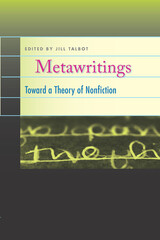 Metawritings: Toward a Theory of Nonfiction
Jill Talbot
University of Iowa Press, 2012 Metawriting—the writing about writing or writing that calls attention to itself as writing—has been around since Don Quixote and Tristram Shandy, but Jill Talbot makes that case that now more than ever the act of metawriting is performed on a daily basis by anyone with a Facebook profile, a Twitter account, or a webpage. Metawritings: Toward a Theory of Nonfiction is the first collection to combine metawriting in both fiction and nonfiction. In this daring volume, metawriting refers to writing about writing, veracity in writing, the I of writing and, ultimately, the construction of writing. With a prologue by Pam Houston, the anthology of personal essays, short stories, and one film script excerpt also includes illuminating and engaging interviews with each contributor. Showcasing how writers perform a meta-awareness of self via the art of the story, the craft of the essay, the writings and interviews in this collection serve to create an engaging, provocative discussion of the fiction-versus-nonfiction debate, truth in writing, and how metawriting works (and when it doesn’t). Metawritings provides a context for the presence of metawriting in contemporary literature within the framework of the digital age’s obsessively self-conscious modes of communication: status updates, Tweets, YouTube clips, and blogs (whose anonymity creates opportunities for outright deception) capture our meta-lives in 140 characters and video uploads, while we watch self-referential, self-conscious television (The Simpsons, The Daily Show with Jon Stewart, The Office). Speaking to the moment and to the writing that is capturing it, Talbot addresses a significant and current conversation in contemporary writing and literature, the teaching of writing, and the craft of writing. It is a sharp, entertaining collection of two genres, enhanced by a conversation about how we write and how we live in and through our writing. Contributors Sarah Blackman Bernard Cooper Cathy Day Lena Dunham Robin Hemley Pam Houston Kristen Iversen David Lazar E. J. Levy Brenda Miller Ander Monson Brian Oliu Jill Talbot Ryan Van Meter
Meteor in the Madhouse
Leon Forrest
Northwestern University Press, 2011 Forrest's long-awaited last work follows the last days of journalist Joubert Jones and his long relationship with his friend and mentor, the idealistic and doomed poet Leonard Foster.
Meteorite Craters
Kathleen Mark
University of Arizona Press, 1987 The scientific community has argued for decades over the origin of giant craters on the earth. In a highly readable fashion, Kathleen Mark recounts the fascinating detective story of how scientists came to recognize metorite craters, both ancient and relatively recent.
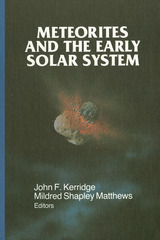 Meteorites and the Early Solar System
John F. Kerridge
University of Arizona Press, 1988 First published in November 1988, this work provided a coherent narrative about the known understandings of meteorites and the early solar system.
From the original publication: Although the Earth was formed, together with the other planets, at the birth of the solar system, geological activity has since erased all but a hint of the processes that accompanied its formation. If we wish to explore the processes that occurred in the earliest solar system, and the nature of the environment in which they took place, we must turn to the record contained in more primitive material. Many meteorites appear to satisfy that criterion, and much effort has been applied in identifying those meteorites, or their constituents, that have retained a reliable record of the early solar system. This book provides a synthesis of what has been learned so far about the earliest stages of solar system history through the study of meteorites, and what, given our current level of understanding, remains to be learned.
Contents 1. Introduction 2. Source Regions 3. Secondary Processing 4. Irradiation Effects 5. Solar System Chronology 6. Chondrites and the Early Solar System 7. Elemental Composition of Chondrites 8. Magnetic Fields in the Early Solar System 9. Chondrules10. Primitive Material Surviving in chondrites11. Micrometeorites12. Inhomogencity of the Nebula13. Survival of Presolar Material in Meteorites14. Nucleosynthesis15. Nucleocosmochronology16. Summary
Meteorites and the Early Solar System II
Edited by Dante S. Lauretta and Harry Y. McSween
University of Arizona Press, 2006 They range in size from microscopic particles to masses of many tons. The geologic diversity of asteroids and other rocky bodies of the solar system are displayed in the enormous variety of textures and mineralogies observed in meteorites. The composition, chemistry, and mineralogy of primitive meteorites collectively provide evidence for a wide variety of chemical and physical processes. This book synthesizes our current understanding of the early solar system, summarizing information about processes that occurred before its formation. It will be valuable as a textbook for graduate education in planetary science and as a reference for meteoriticists and researchers in allied fields worldwide.
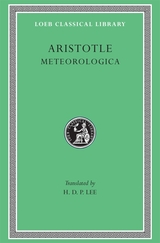 Meteorologica
Aristotle
Harvard University Press Things in heaven and earth.
Aristotle, great Greek philosopher, researcher, reasoner, and writer, born at Stagirus in 384 BC, was the son of a physician. He studied under Plato at Athens and taught there (367–347); subsequently he spent three years at the court of a former pupil in Asia Minor. After some time at Mitylene, in 343–342 he was appointed by King Philip of Macedon to be tutor of his teen-aged son Alexander. After Philip’s death in 336, Aristotle became head of his own school (of “Peripatetics”), the Lyceum at Athens. Because of anti-Macedonian feeling there after Alexander’s death in 323, he withdrew to Chalcis in Euboea, where he died in 322.
Nearly all the works Aristotle prepared for publication are lost; the priceless ones extant are lecture-materials, notes, and memoranda (some are spurious). They can be categorized as follows:
I Practical: Nicomachean Ethics; Great Ethics (Magna Moralia); Eudemian Ethics; Politics; Economics (on the good of the family); On Virtues and Vices.
II Logical: Categories; Analytics (Prior and Posterior); Interpretation; Refutations used by Sophists; Topica.
III Physical: Twenty-six works (some suspect) including astronomy, generation and destruction, the senses, memory, sleep, dreams, life, facts about animals, etc.
IV Metaphysics: on being as being.
V Art: Rhetoric and Poetics.
VI Other works including the Constitution of Athens; more works also of doubtful authorship.
VII Fragments of various works such as dialogues on philosophy and literature; and of treatises on rhetoric, politics, and metaphysics.
The Loeb Classical Library edition of Aristotle is in twenty-three volumes.
Meter in English: A Critical Engagement
David Baker
University of Arkansas Press, 1997 Renowned poets and experts in metrics respond to Robert Wallace's pivotal essay which clarifies and simplifies methods of studying poetry. Former United States Poet Laureate Robert Hass has called Wallace's essay a paradigm shift in our understanding of English prosody.
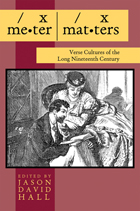 Meter Matters: Verse Cultures of the Long Nineteenth Century
Jason David Hall
Ohio University Press, 2011 Across the nineteenth century, meter mattered—in more ways and to more people than we might well appreciate today. For the period’s poets, metrical matters were a source of inspiration and often vehement debate. And the many readers, teachers, and pupils encountered meter and related topics in both institutional and popular forms. The ten essays in Meter Matters showcase the range of metrical practice of poets from Wordsworth and Byron to Hopkins, Swinburne, and Tennyson; at the same time, the contributors bring into focus some of the metrical theorizing that shaped poetic thinking and responses to it throughout the nineteenth century. Paying close attention to the historical contours of Romantic and Victorian meters, as well as to the minute workings of the verse line, Meter Matters presents a fresh perspective on a subject that figured significantly in the century’s literature, and in its culture.
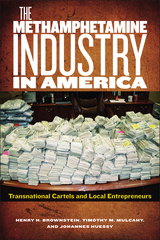 The Methamphetamine Industry in America: Transnational Cartels and Local Entrepreneurs
Brownstein, Henry H
Rutgers University Press, 2016 Galax, a small Virginia town at the foot of the Blue Ridge Mountains, was one of the first places that Henry H. Brownstein, Timothy M. Mulcahy, and Johannes Huessy visited for their study of the social dynamics of methamphetamine markets—and what they found changed everything. They had begun by thinking of methamphetamine markets as primarily small-scale mom-and-pop businesses operated by individual cooks who served local users—generally stymied by ever more strenuous laws. But what they found was a thriving and complex transnational industry. And this reality was repeated in towns and cities across America, where the methamphetamine market was creating jobs and serving as a focus for daily lives and social experience. The Methamphetamine Industry in America describes the reality that the methamphetamine industry is a social phenomenon connecting local, national, and international communities and markets. The book details the results of a groundbreaking three-stage study, part of a joint initiative of the National Institute on Drug Abuse and the National Institute of Justice, in which police agencies across the United States were surveyed and their responses used to identify likely areas of study. The authors then visited these areas to observe and interview local participants, from users and dealers to law enforcement officers and clinical treatment workers. Through the eyes and words of these participants, the book tells the story of the evolution of methamphetamine markets in the United States over the past several years, given changes in public policies and practices and changing public opinion about methamphetamine. The authors look closely at how the markets are part of a larger industry, how they are socially organized, and how they operate. They also consider the relationships among the people involved and those around them, and the national, regional, and local culture of the markets. Their work demonstrates the importance of understanding the business of methamphetamine—and by extension other drugs in society—through a lens that focuses on social behavior, social relationships, and the cultural elements that shape the organization and operation of this illicit but effective industry.
Methane and Hydrogen for Energy Storage
Rupp Carriveau
The Institution of Engineering and Technology, 2016 Commercial energy storage has moved from the margins to the mainstream as it fosters flexibility in our smarter, increasingly integrated energy systems. Natural gas has been identified by many as the fuel to take us to the no-carbon horizon; where a hydrogen economy waits on development. These two actors are already connected in precursor applications as transitional solutions for hydrogen handling and transportation are sought ahead of a fully established hydrogen infrastructure.
Method Acting and Its Discontents: On American Psycho-Drama
Shonni Enelow
Northwestern University Press, 2015 Method Acting and Its Discontents: On American Psycho-Drama provides a new understanding of a crucial chapter in American theater history. Enelow’s consideration of the broader cultural climate of the late 1950s and early 1960s, specifically the debates within psychology and psychoanalysis, the period’s racial and sexual politics, and the rise of mass media, gives us a nuanced, complex picture of Lee Strasberg and the Actors Studio and contemporaneous works of drama. Combining cultural analysis, dramaturgical criticism, and performance theory, Enelow shows how Method acting’s contradictions reveal powerful tensions inside mid-century notions of individual and collective identity.
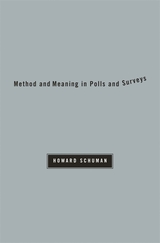 Method and Meaning in Polls and Surveys
Howard Schuman
Harvard University Press, 2008 Howard Schuman is one of the premier scholars of social surveys. His expertise concerns the way questions about attitudes and beliefs are worded and the effects questions have on the answers people give. However, Method and Meaning in Polls and Surveys is less about the substance of wording effects and more about approaches to interpreting the respondent’s world, and how surveys can make that world understandable—though often in ways not anticipated by the researcher.
Schuman examines the question-answer process that is basic to polls and surveys, as it is in so much of life. His concern is with the nature of questioning itself, with issues of validity and bias, and with the scope and limitations of meaning sought through polls and surveys.
Writing with both wisdom and humor, Schuman considers the issues both at a theoretical level, bringing in ideas from other social sciences, and empirically with substantive research of his own and others. The book will be of interest to social scientists, to survey researchers in academia and business, and to all those concerned with the pervasive influence of polls in society.
 Method and Perspective in Anthropology: Papers in Honor of Wilson D. Wallis
Robert F. Spencer
University of Minnesota Press, 1954
Method and Perspective in Anthropology was first published in 1954. Minnesota Archive Editions uses digital technology to make long-unavailable books once again accessible, and are published unaltered from the original University of Minnesota Press editions.
The boundaries and goals of anthropology are changing and expanding as scholars recognize and pursue wider opportunities for achieving an understanding of the cultural development of man. The range of interests of the discipline as shown in this book embodies such varied fields as archaeology, human geography, linguistics, and the organization of society. With the broadening and deepening of these concerns, those working and studying in the various areas of anthropology have sought more concise methods and more adequate techniques with which to meet increasingly complex problems.
This volume of papers, published in honor of a scholar who has himself devoted much effort to the refinement of anthropological methods, represents a long step forward toward the solution of some of the problems of methodology. The contributors are outstanding scholars in cultural anthropology, ethnology, and related fields.
The first twelve papers, by as many different authors, present discussions of specific aspects of ethnography, cultural anthropology, prehistory, linguistics, ethnogeography, and sociology. The final paper, by Alfred L. Kroeber, provides a critical summary of the preceding papers. All twelve of the writers answer, in their own way, the questions of how they derive their data, and how they establish their theoretical frame of reference.
The contributors are, in addition to Professor Kroeber, Melville J. Herskovits, Sister M. Inez Hilger, Elizabeth Colson, David G. Mandelbaum, Allan R. Holmberg, Robert F. Spencer, Ralph Linton, Erwin H. Ackerknecht, Lloyd A. Wilford, Joseph H. Greenberg, Omer C. Stewart, and Raymond V. Bowers.
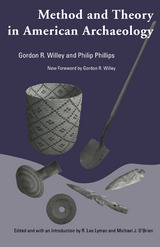 Method and Theory in American Archaeology
Gordon R. Willey
University of Alabama Press, 2001 A Dan Josselyn Memorial Publication
This invaluable classic provides the framework for the development of American archaeology during the last half of the 20th century. In 1958 Gordon R. Willey and Philip Phillips first published Method and Theory in American Archaeology—a volume that went through five printings, the last in 1967 at the height of what became known as the new, or processual, archaeology. The advent of processual archaeology, according to Willey and Phillips, represented a "theoretical debate . . . a question of whether archaeology should be the study of cultural history or the study of cultural process."
Willey and Phillips suggested that little interpretation had taken place in American archaeology, and their book offered an analytical perspective; the methods they described and the structural framework they used for synthesizing American prehistory were all geared toward interpretation. Method and Theory served as the catalyst and primary reader on the topic for over a decade.
This facsimile reprint edition of the original University of Chicago Press volume includes a new foreword by Gordon R. Willey, which outlines the state of American archaeology at the time of the original publication, and a new introduction by the editors to place the book in historical context. The bibliography is exhaustive. Academic libraries, students, professionals, and knowledgeable amateurs will welcome this new edition of a standard-maker among texts on American archaeology.
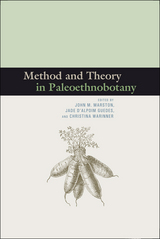 Method and Theory in Paleoethnobotany
John M. Marston
University Press of Colorado, 2014 Paleoethnobotany, the study of archaeological plant remains, is poised at the intersection of the study of the past and concerns of the present, including agricultural decision making, biodiversity, and global environmental change, and has much to offer to archaeology, anthropology, and the interdisciplinary study of human relationships with the natural world. Method and Theory in Paleoethnobotany demonstrates those connections and highlights the increasing relevance of the study of past human-plant interactions for understanding the present and future. A diverse and highly regarded group of scholars reference a broad array of literature from around the world as they cover their areas of expertise in the practice and theory of paleoethnobotany—starch grain analysis, stable isotope analysis, ancient DNA, digital data management, and ecological and postprocessual theory. The only comprehensive edited volume focusing on method and theory to appear in the last twenty-five years, Method and Theory in Paleoethnobotany addresses the new areas of inquiry that have become central to contemporary archaeological debates, as well as the current state of theoretical, methodological, and empirical work in paleoethnobotany.
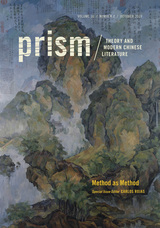 Method as Method
Carlos Rojas, special issue editor
Duke University Press, 2020 In 1960, Japanese scholar of Chinese literature Takeuchi Yoshimi gave a pair of lectures titled “Asia as Method,” in which he considered how one might engage with Western theory from an East Asian perspective. Since then, it has been fashionable to use the “X as method” formulation to take what might have otherwise been an object of analysis and use it to elaborate an innovative methodology. Drawing inspiration from the numerous recent books and articles built around that formulation, contributors to this issue propose breaking the linkage between methodologies and objects or phenomena that inspired them and then applying them to a broader array of topics. Essays address the meanings that get left out in the process of translation, artistic representations of garbage, indigenous eco-fiction from Inner Mongolia, the role of cannibalism in a popular Hong Kong television series, and the implications of Taiwan legalizing same-sex marriage. The issue focuses on topics related to China in hopes of reassessing the assumptions that have come to define the concept of "China" and its relationship to the West.
Contributors. Yomi Braester, Hsiao-hung Chang, Margaret Hillenbrand, Chun-kit Ko, Belinda Kong, Petrus Liu, Laikwan Pang, Christopher Rea, Carlos Rojas, Shuang Shen, Robin Visser, Lorraine Wong
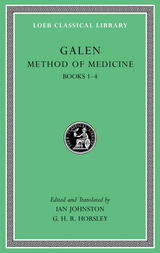 Method of Medicine, Volume I: Books 1–4
Galen
Harvard University Press, 2011 Antiquity’s most prolific and influential medical writer and practitioner.
Galen of Pergamum (129–?199/216), physician to the court of the emperor Marcus Aurelius, was a philosopher, scientist, and medical historian, a theoretician and practitioner, who wrote forcefully and prolifically on an astonishing range of subjects and whose impact on later eras rivaled that of Aristotle. Galen synthesized the entirety of Greek medicine as a basis for his own doctrines and practice, which comprehensively embraced theory, practical knowledge, experiment, logic, and a deep understanding of human life and society.
Method of Medicine is a systematic and comprehensive account of the principles of treating injury and disease and one of Galen’s greatest and most influential works. Enlivening the detailed case studies are many theoretical and polemical discussions, acute social commentary, and personal reflections. The Loeb Method of Medicine is in three volumes.
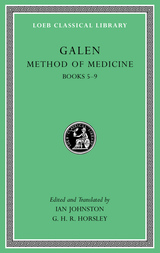 Method of Medicine, Volume II: Books 5–9
Galen
Harvard University Press, 2011 Antiquity’s most prolific and influential medical writer and practitioner.
Galen of Pergamum (129–?199/216), physician to the court of the emperor Marcus Aurelius, was a philosopher, scientist, and medical historian, a theoretician and practitioner, who wrote forcefully and prolifically on an astonishing range of subjects and whose impact on later eras rivaled that of Aristotle. Galen synthesized the entirety of Greek medicine as a basis for his own doctrines and practice, which comprehensively embraced theory, practical knowledge, experiment, logic, and a deep understanding of human life and society.
Method of Medicine is a systematic and comprehensive account of the principles of treating injury and disease and one of Galen’s greatest and most influential works. Enlivening the detailed case studies are many theoretical and polemical discussions, acute social commentary, and personal reflections. The Loeb Method of Medicine is in three volumes.
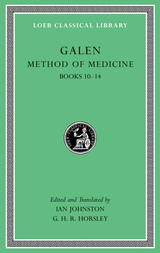 Method of Medicine, Volume III: Books 10–14
Galen
Harvard University Press, 2011 Antiquity’s most prolific and influential medical writer and practitioner.
Galen of Pergamum (129–?199/216), physician to the court of the emperor Marcus Aurelius, was a philosopher, scientist, and medical historian, a theoretician and practitioner, who wrote forcefully and prolifically on an astonishing range of subjects and whose impact on later eras rivaled that of Aristotle. Galen synthesized the entirety of Greek medicine as a basis for his own doctrines and practice, which comprehensively embraced theory, practical knowledge, experiment, logic, and a deep understanding of human life and society.
Method of Medicine is a systematic and comprehensive account of the principles of treating injury and disease and one of Galen’s greatest and most influential works. Enlivening the detailed case studies are many theoretical and polemical discussions, acute social commentary, and personal reflections. The Loeb Method of Medicine is in three volumes.
The Method of Metaphor
Stanley Raffel
Intellect Books, 2013 Both sides in controversies tend to argue they have logic on their side. This book proposes that the interminable nature of these controversies suggests there is a problem with the main tool of logic, the syllogism. Drawing on contemporary developments in social theory and philosophy, Stanley Raffel argues that metaphors are not just aesthetic tools; they can also be used to judge phenomena. Featuring case studies drawn from both literary material and current controversial debates, The Method of Metaphor ultimately demonstrates the value of this neglected potential of metaphoric reasoning and shows its far-reaching implications in both moral behavior and moral education.
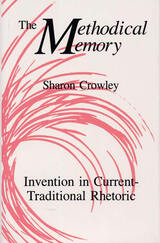 The Methodical Memory: Invention in Current-Traditional Rhetoric
Sharon Crowley
Southern Illinois University Press, 1990 In this first sustained critique of current-traditional rhetorical theory, Sharon Crowley uses a postmodern, deconstructive reading to reexamine the historical development of current-traditional rhetoric. She identifies it (as well as the British new rhetoric from which it developed) as a philosophy of language use that posits universal principles of mind and discourse. Crowley argues that these philosophies are not appropriate bases for the construction of rhetorical theories, much less guides for the teaching of composition. She explains that current-traditional rhetoric is not a rhetorical theory, and she argues that its use as such has led to a misrepresentation of invention. Crowley contends that current-traditional rhetoric continues to prosper because a considerable number of college composition teachers—graduate students, part-time instructors, and teachers of literature—are not involved in the development of the curricula they are asked to teach. As a result, their voices, necessary to create any true representation of the composition teaching experience, are denied access to the scholarly conversations evaluating the soundness of the institutionalized teaching methods derived from the current-traditional approach.
|
|
